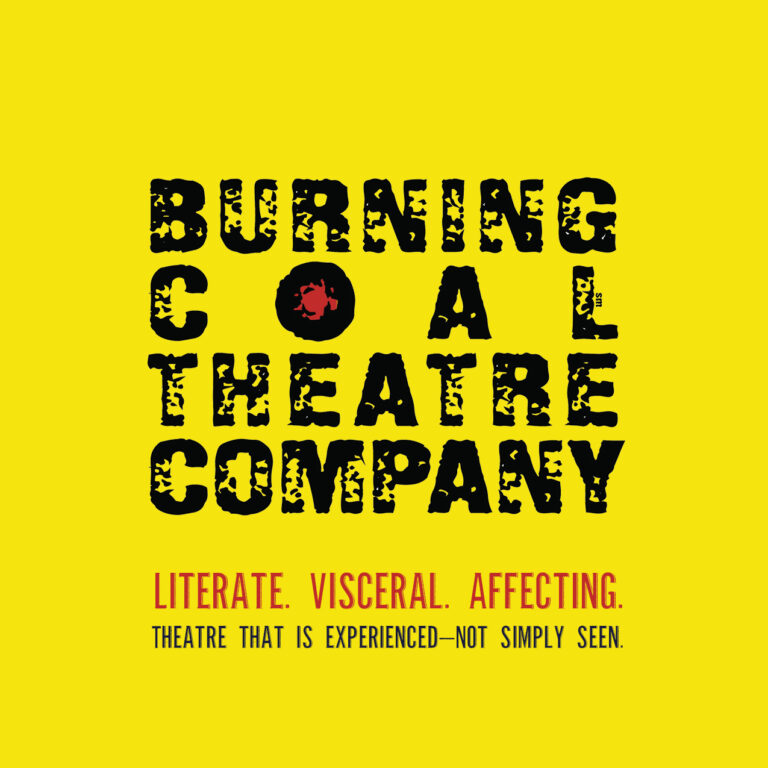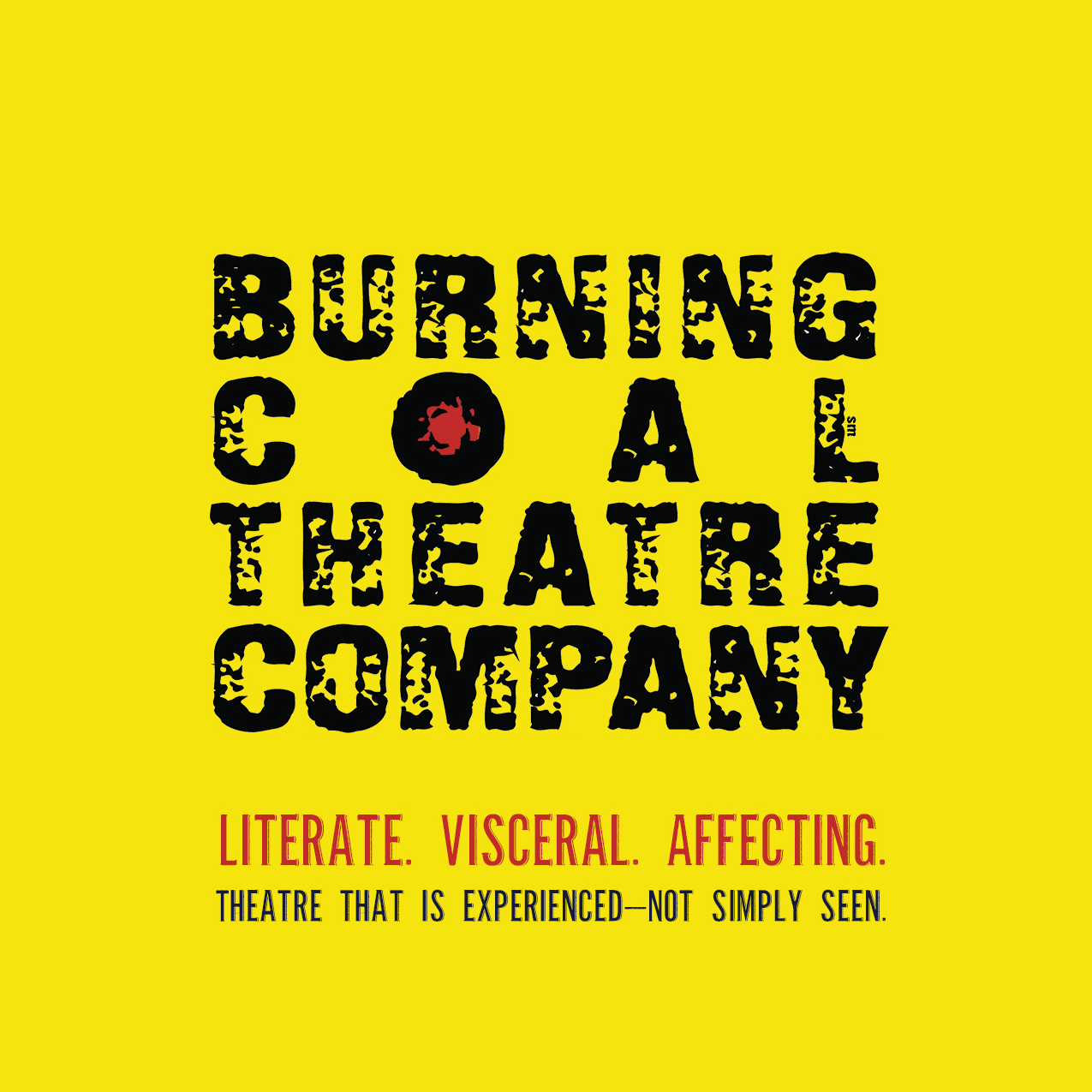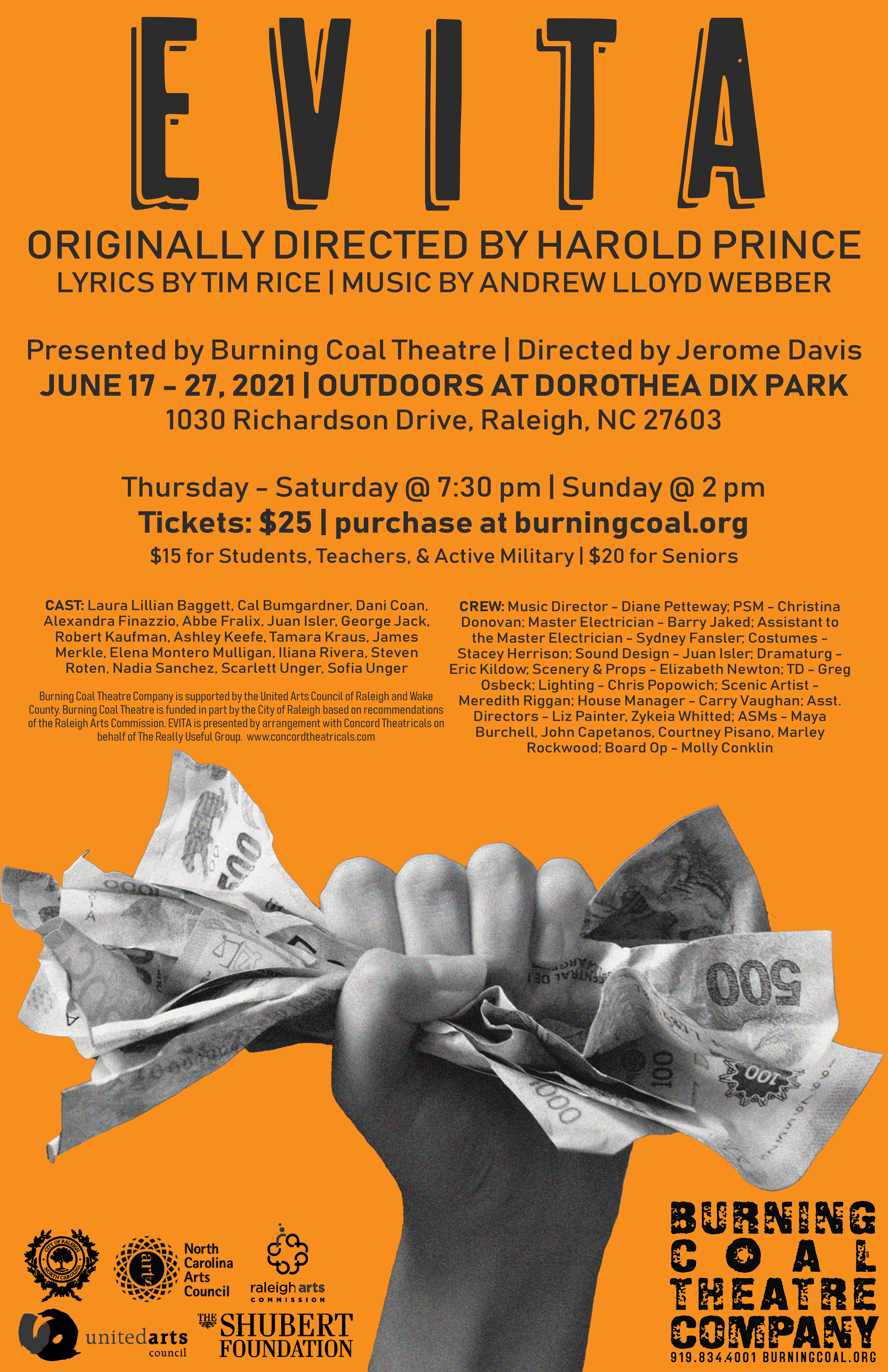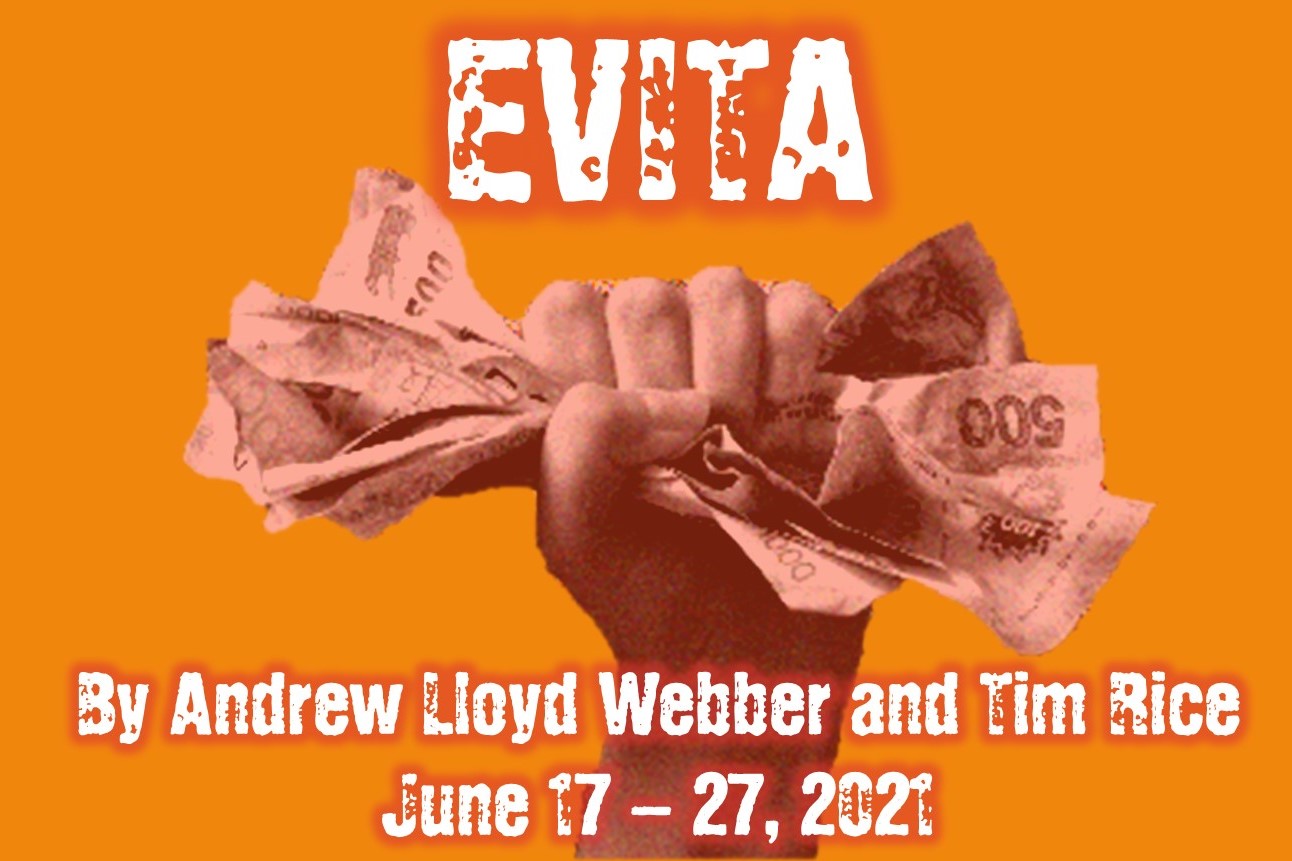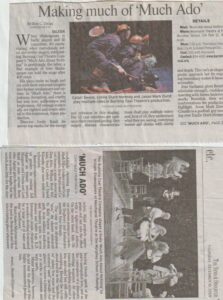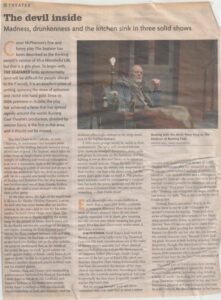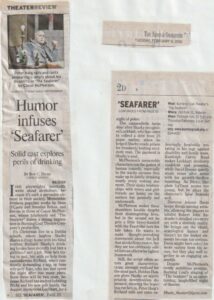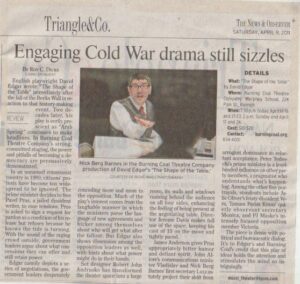
Through the Years Timeline:
Season 13: (2009-2010)
Hair
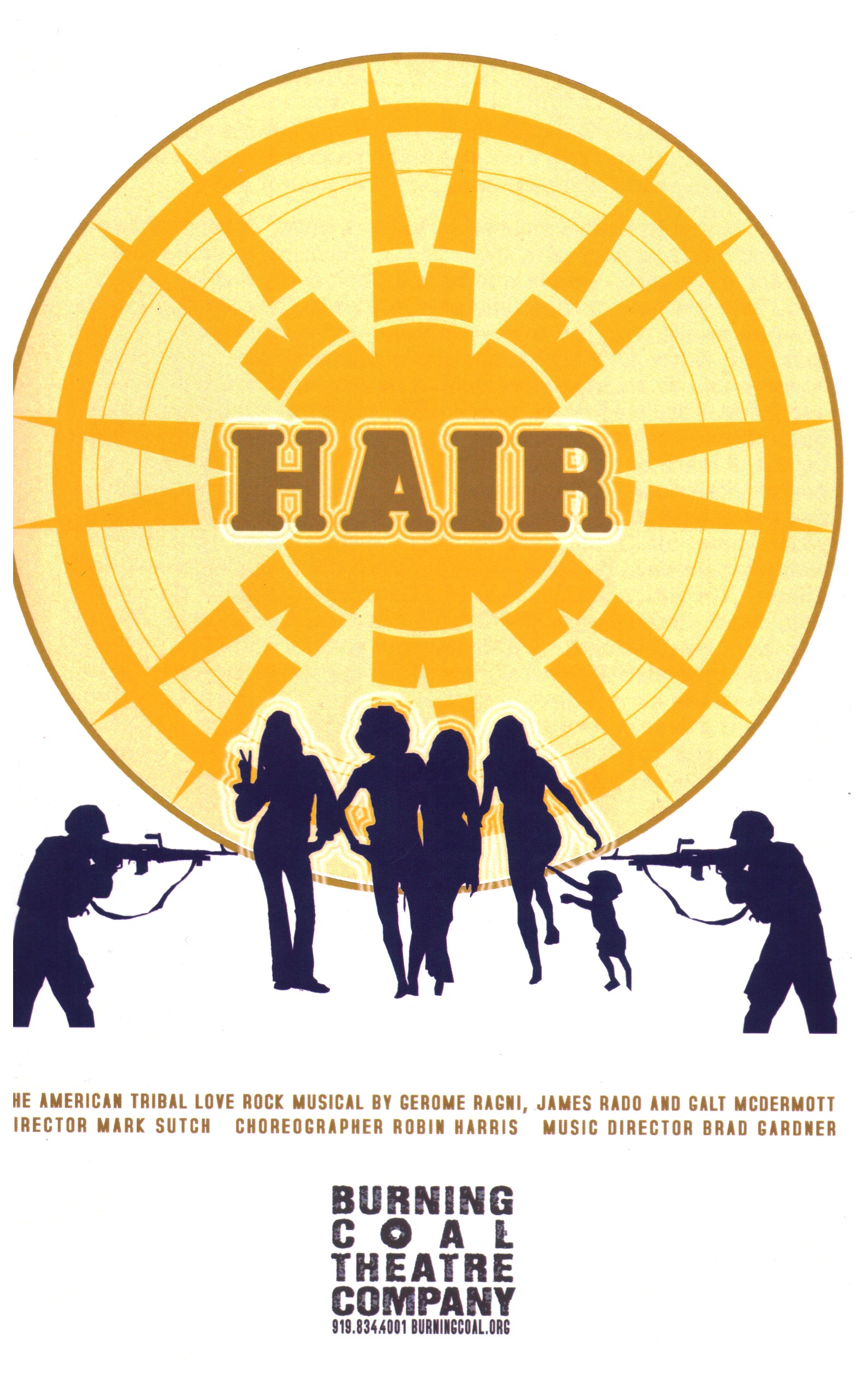
Hair by Gerome Ragni, James Rado, and Galt McDermott
Dir. Mark Sutch
Dates: September 10-27 2009
Location: Murphey School
Much Ado About Nothing
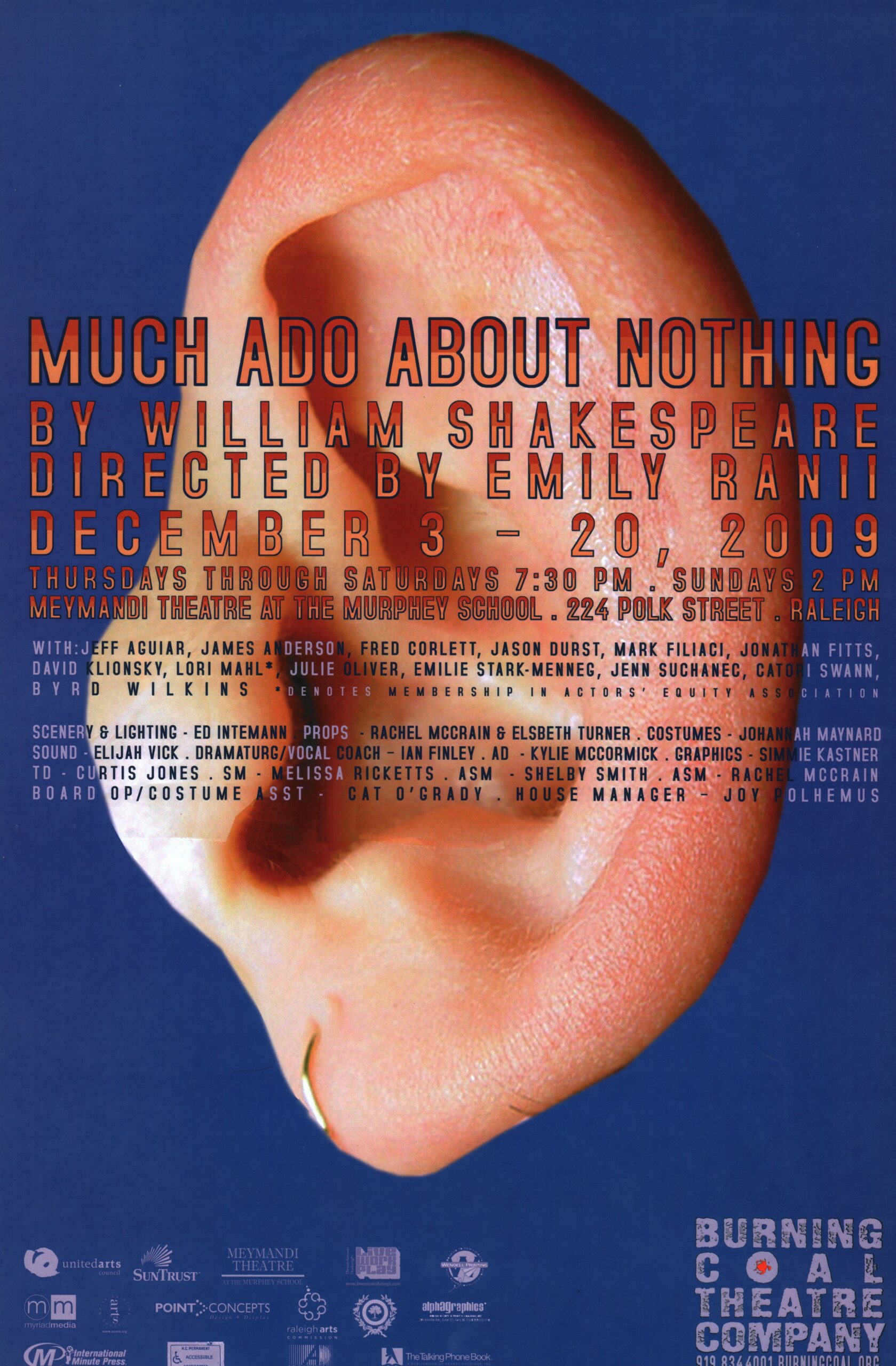
Much Ado About Nothing by William Shakespare
Dir. Emily Ranii
Dates: December 3-20 2009
Locatio: Murphey School
The Seafarer
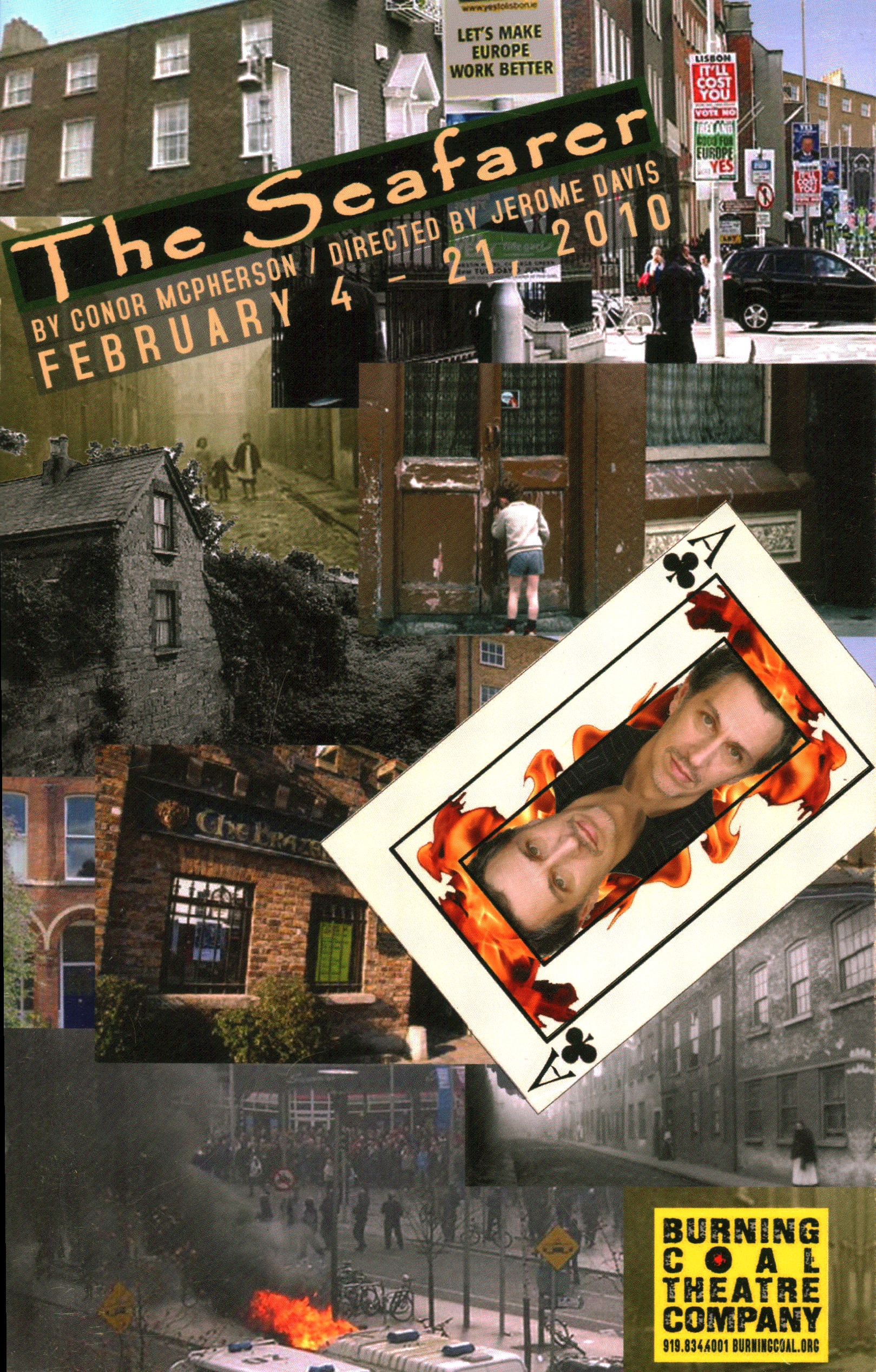
The Seafarer by Conor McPherson
Dir. Jerome Davis
Dates: February 4-21, 2010
Location: Murphey School
Gee's Bend & SECCA

GEES BEND by Elyzabeth Gregory Wilder
Dir. Marc Williams
Dates: April 15-May 2, 2010
Location: Murphey School
SECCA by Angus Maclachlan
Dir. Kathryn Milliken
Dates: April 15-May 2, 2010
Location: Murphey School
Hair
Hair by Gerome Ragni, James Rado, and Galt McDermott
Dir. Mark Sutch
Dates: September 10-27 2009
Location: Murphey School
Artistic Director’s Notes:
I keep getting asked two questions: How’d you get the rights? (I asked for them!) and Why Hair now? The second question requires more than my usual glib response.
I have wanted to do this material for quite a while. It seemed to me that with each passing year, the urgency, the need to do Hair was growing more faint. People who were in their teens and 20s in the mid 1960s are now nearing their own “sixties.” They are, and have been for a while now, the ones with power, influence, control. To say that many of the lofty aspirations of the counterculture have failed to flower would be an understatement. The fact is, very few of those succinctly articulated goals (peace, love, freedom, happiness) have been attained on any meaningful level. Why? Were the objectives so far out of reach of humankind? If not, have we moved in the direction of those goals? I don’t know. If we could get in a time machine and travel back to Woodstock or Haight Ashbury circa 1967 my suspicion is that the Flower Children of that day would not be impressed with what we have managed to attain since then. Watergate. Iran-Contra. The S&L Scandal. The “Me” Generation. Enron. Gangsta Rap, Death Metal, Reality TV. September 11th. Off-shoring. The Iraq war. Internet porn. A decline in our cultural output so pronounced that poetry, classical music, dance, theatre, fictional literature, even movies have dropped from their status as significant parts of the lives of Americans into their current status as political ‘talking points’ to be disparaged or championed (depending on which side of the debate you are on), but never to actually attend, to support, to build up. Sex & drugs remain, in abundance, but rock & roll (the least self-serving of that quintessentially 60s triumvirate) has fallen out of our hearts and off our airways. It has lost its meaning.
Which leads me to the answer to that second question: Why Hair now? Forty years on, it seems to me a good time to look back (albeit through bifocals!) and ask ourselves what part of “the Sixties” were actually worth the fight. It is not for nothing that the final song of this great song cycle is called, in part, “Flesh Failures.” If you listen to this play, really listen to it, it may well surprise you. This play is not a blind celebration of all that Flower Power stood for. Instead, I believe it was and remains a call to arms, a suggestion that it was time, then, “to put away childish things” and to become politicized in a communal or universal way. Does anyone hear that call today?
And so, at the beginning of a new year at Burning Coal and here in our beautifully gritty new Meymandi Theatre at the Murphey School, I ask you to do our company and this play the greatest honor that you can bestow: Stop! Listen. Think. And then act accordingly. That is, I think, all the Flower Children could ask of us. And of themselves.
Jerome Davis
Crew:
Choreography: Robin Harris
Music Director: Brad Gardner
Stage Manager: Elizabeth Gerhard
Technical Director: Curtis Lee Jones
Scenic Designer: Joe Gardner
Lighting Designer: Christopher Popowich
Costume Design: Kelly Farrow
Props: Rachel McCrain and Elsbeth Turner
Graphics Designer: Simmie Kastner
Asst. Director: Sylvia Mallory
Resident Dramaturg: Marc Williams
House Manager: Joy Polhemus
Asst. Stage Manager: Rachel McCrain and Haley Teater
Wigs Designer: Brittnye Batcheler
Dresser: Cat O’Grady and Dionne Hodge
Asst. Costume Designer: McLeod Skinner
Asst. to the Lighting Designer: Trameeka Reid
Board Operator: Spencer Bloom
Cast:
Jade Arnold – Paul Michael
Aurelia Belfield – Iris
Jackson Bloom – Walter
Katie Finan – Jeanie
Jonathan Fitts – Steve
Sam Heldt – Claude
Joel Hughes – Berger
Lormarev Jones – Dionne
Whitney Madren – Sheila
Kristen McCabe – Layla
Jennifer Mundia – Ronni
Betsy Newsome – Diane
Chloe Oliver – Crissy
Aaron Pratt – Woof
Mark St. Cyr – Hud
Thomas WeaverMargaret – Zeke
Rob Jenkins – Hubert
Julie Oliver – Mead
The Band:
Guitar – Marc Davis
Drums – Mike Davis
Piano – Brad Gardner
Guitar 2 – Matt Kanon
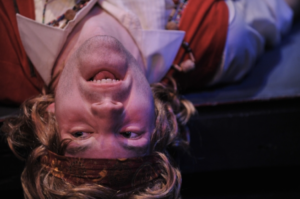
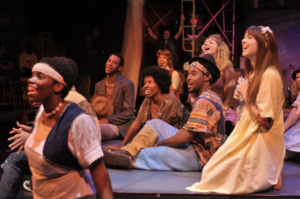
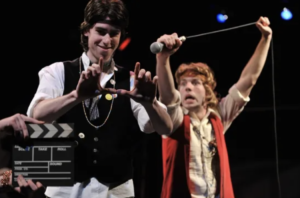
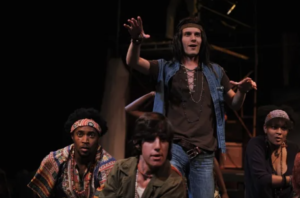
Have a fond or interesting memory of this play you’d like to share with us? We’d love to hear it!
Please Contact Us to Share!
Burning Coal Theatre
(919) 834-4001
224 Polk St., Raleigh NC 27604
Played September 10-27 2009: Hair
Much Ado About Nothing
Much Ado About Nothing by William Shakespare
Dir. Emily Ranii
Dates: December 3-20 2009
Location: Murphey School
Artistic Director’s Notes:
We don’t know much about the person, William Shakespeare. We do know that he married Anne Hathaway while he was still a teenager and she in her twenties. We know that he fathered children by her, including the boy, Hamnet, who died shortly after Shakespeare left his young family and travelled to London to a life in the theatre. There has been a lot of speculation about what would have caused Shakespare to leave his family, how a man of such seeming integrity could make a choice that we, today, would consider unsupportable. Though there is no evidence to support such supposition, many have speculated that Shakespaere and Anne’s marriage had fallen on hard times, that they had fought, leading to the separation.
The “battle of the sexes” rages ever on. Shakespeare wrote about this conundrum on numerous occasions, the most famous of which, perhaps, is The Taming of the Shrew. I like Much Ado About Nothing because it deals head-on with that seemingly insurmountable war but also touches, indeed lands firmly, on other equally important concerns. We have the issue of men coming home from war and acclimating themselves to their communities, the issue of how people are valued within their community (and based upon what set of criteria), male bonding, female friendships, the division between youth and the aged, and a consideration of the nature of evil.
Shakespeare is still important today as a model against which all other writers are judged. Few writers today want to seriously explore consequential issues. Which ‘battle of the sexes’ comedy have you seen recently in which may be observed the additional layers presented by Shakespeare in the beautiful scene in which the aging Don Pedro suddenly and nervously asks for Beatrice’s hand – and we understand a little bit about her own superficial favorings – the moment when Borachio repents his sins (in the middle of a comedy!?) or the jaw-dropping moment in which Beatrice asks Benedick to….Well, you’ll have to wait to see that one for yourself!
These moments all reveal character flaws or discrepancies. That is an idea we have gotten away from in our modern culture. Heroes are relentless in their pursuit of justice, without a moment of self-reflection. Lovers meet and never reconsider their entanglement. And Heaven forbid that a modern villain should turn out to have a valid point or two to be made. If these intractable positions were held only within fictional worlds, it would be troubling. But anyone who can read a newspaper knows that those ways of thinking have bled into our “real world” experience in ways that are divisive and worse.
I like to think that Shakespeare, in creating three dimensional characters and situations, was working to create a more contemplative, self-reflective society. It may very well also be, given his early life story, that he was working to create those characteristics in himself.
Jerome Davis
Crew:
Stage Manager: Melissa Ricketts
Technical Director: Curtis Lee Jones
Scenery and Lighting: ED Intemann
Costume Design: Kelly Farrow
Props: Rachel McCrain and Elsbeth Taylor
Sound Design: Elijah Vick
Graphics Designer: Simmie Kastner
Asst. Director: Kylie McCormick
Dramaturg/Vocal Coach: Ian Finley
House Manager: Joy Polhemus
Asst. Stage Manager: Rachel McCrain and Shelby Smith
Asst. Costume Designer: Cat O’Grady
Cast:
Jeff Aguiar – Margaret/Ursula/Verges
James Anderson – Benedick
Fred Corlett – ANtonion
Jason Mark Durst – Claudio/The Watch
Mark Filiaci – Don Pedro
David Klionsky-Conrade/Messenger
Lori Mahl – Borachio
Julie Oliver – Dogberry/Friar Francis
Emilie Stark-Menneg – Hero/The Watch
Catori Swann – Don John/The Watch
William Byrd Wilkins – Leonato
Have a fond or interesting memory of this play you’d like to share with us? We’d love to hear it!
Please Contact Us to Share!
Burning Coal Theatre
(919) 834-4001
224 Polk St., Raleigh NC 27604
Played December 3-20 2009: Much Ado About Nothing
The Seafarer
The Seafarer by Conor McPherson
Dir. Jerome Davis
Dates: February 4-21, 2010
Location: Murphey School
Artistic Director’s Notes:
I was out doing some last minute Christmas shopping with my wife Simmie this past December when an extraordinary and disturbing thing happened. I walked into a bookstore and asked for the “record action.” I call the CD or music section this because I am fond of ‘dating’ myself and/or eliciting peculiar and uncomprehending looks from the 20-somethings behind the counter. This clerk, however, nearer to my own age (ah, the recession!), knew what I was talking about and was ready with a response. “Oh, we don’t do music,” she said with a dismissive air. She pointed over in a southwesterly direction. “We have a very small collection of there (she might as well have been pointing out a smelly shoe someone had left behind for all her enthusiasm for the subject). Hmm, I thought as my wife and I stumbled in that general direction. “What could that have been about?” Then Simmie stopped. “They aren’t going to be doing that anymore,” she said. “Doing what?” “Selling records…er, CDs.” “What do you mean?” I asked. “It’s all going to be in digital format. Mp3s.”
My heart sank. I ought to admit this is a personal response that may be related only to my age, having grown up as I did in that relatively slender window of time between the inventions of the phonograph and the Ipod. I have held vinyl in my hands! I have fumbled for many hours (cumulatively speaking, of course) to remove those cellophane wrappers, cursing all the while the devilish intention behind those…um…record wrappers. I have chipped wax, scratched disks, played Thick as a Brick from start to finish (not to mention, Tubular Bells). I have walked solemnly to the turntable of my best high school buddy and listened in awe and a bit of fear as he dropped the needle on the first Black Sabbath album. I’ve sat in a dark room as my very first girlfriend in the world played for me an obscure filler track on an early Elton John album called “Candle in the Wind” (a song that would later rise from the ash heap of filler tracks to become one of the most poignant and beloved songs of our time. I have also received also (from that same girl, come to think of it) a record called “Kristofferson’s Greatest Hits” (I owe that girl a helluva lot!). I’ve stood in line in lower Manhattan for more than my lunch hour waiting with 150 other young men who looked more or less just like me to plunk down $40 for a five record set (Bruce Live, what else?) and I have marveled at my stern disciplinarian/law abiding father’s only record purchase ever: Soundtrack to The Godfather.
What have I never done, and never will do, is spend my love, my heart, my dreams, my faith, my fantasies, my life … in the mp3 format. The world will lose something vast when boys and girls lose the ability to hand those things on to the one they love. You can’t gaze into someone’s eyes over an IPhone.
I hope you enjoy The Seafarer. I give it to you, as Michelle gave me Candle in the Wind, in the dark, expectant, breathless. And hopeful for a tomorrow that only Conor McPherson, among the many, seems currently able to envision.
Jerome Davis
Crew:
Stage Manager: Jessica McGloin
Technical Director: Mark Peelman
Scenery Design: Robert John Andrusko
Lighting: Matthew Adelson
Costume Design: Lynda Clark
Props: Jan Morgan
Sound Design: Steve Burnett
Dialects Coach: Kirby Wahl
Dramaturg: Marc Williams
Graphics Designer: Simmie Kastner
Asst. Director” Rachel McCrain
House Manager: Joy Polhemus
Asst. Stage Manager: marissa Boisvert and Kylie McCormick
Board Operator: Cat O’Grady
Cast:
David Dossey – Ivan
Peter Haig – Richard
Holden Hansen – Sharky
Stephen LeTrent – Nicky
Randolph Curtis Rand – Lockhart
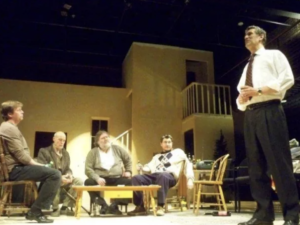
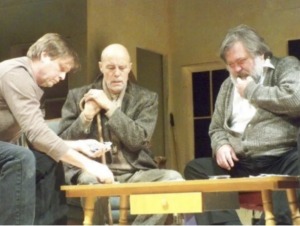
Have a fond or interesting memory of this play you’d like to share with us? We’d love to hear it!
Please Contact Us to Share!
Burning Coal Theatre
(919) 834-4001
224 Polk St., Raleigh NC 27604
Played February 4-21, 2010: The Seafarer
Gee's Bend & SECCA
GEES BEND by Elyzabeth Gregory Wilder
Dir. Marc Williams
Dates: April 15-May 2, 2010
Location: Murphey School
SECCA by Angus Maclachlan
Dir. Kathryn Milliken
Dates: April 15-May 2, 2010
Location: Murphey School
Artistic Director’s Notes:
It is easy to dream of a better world. How, though, might we work toward that goal? One little step, I believe, is the creation of new art. Old art is good (sometimes). Old art is beautiful (often). But new art is something else (telling).
We’re doing Southeastern Center for Contemporary Arts and Gee’s Bend in repertory. “Why?” . you might ask. Because the two plays are about the same thing. Both show what happens to artists living in a community that is unprepared to welcome them, as professionals, into that community. In one case, it is in the deeply rural Alabama. In the other, it is the more cosmopolitan Winston-Salem. In both cases, the subtle barriers presented to these artists, who would be contributors of enormous value to their regions if they were welcomed, are ultimately challenged and finally, in varying degrees, overcome. In one case, time and a great deal of bravery and blood shed for the good cause help to begin to remove the barriers. In the other case, the artist’s own self-scrutiny is necessary for a similar result. Scrutiny of a psychology not entire self-inflicted, but rather the result of a particular communal attitude toward art and its practitioners.
Nothing Burning Coal will do this year, next year, or any year, is more important than the development of new work. South Eastern Center for Contemporary Arts is one of several new plays we’ve presented over the years. Angus is a very talented writer of both screenplays (Junebug, the upcoming Stone) and plays (The Dead Eye Boy, The Radiant Abyss). His lifelong effort to build a life as an artist in his hometown of Winston-Salem is a magnificent example of what is possible and also a clarion call for communities like his own to step up and support professional artists in their midst. At Burning Coal, we have made a firm commitment to the production of new plays and we mean to stick to it. Next year, we will present the world premiere of Raleigh-based playwright Kelly Doyle’s Blue. It is a remarkable, fun, savagely pointed work by a young woman who has as much talent as any writer working in the theatre today. That our audience in Raleigh will be the first to see it is both a tribute to Raleigh’s growth as an incubator for the arts and a hint at what the future may hold.
Why, then, is new work important? Why shouldn’t we continue to present the same tried-and-true “audience favorites”? For one thing, we know that the art forms that do not welcome new works into the canon have an increasingly difficult time drawing audiences. But that is only an “art for arts sake” argument. There is a deeper, more all encompassing reason for new works in theatre or any other art form to be supported and nurtured. When a writer puts pen to paper, he or she is inevitably, unavoidably telling a story through the prism of that writer’s own experience. That means all that has come before, both the profound and the mundane, the universal and the local, will be a part of that writer’s work, whether that person wants it to be or not. In this way, society collects itself, documents itself, and moves forward. Without new works, a filter exists between the audience and the truth. There are far too many filters on our lives today, far too many experts pontificating to make sure that we understand what they want us to understand. With the creation of new works, we can glean for ourselves that truth. Such clarity is vital to any society. Of course, the writer will filter the work, but only to a degree. Deeper than editorial decisions, there exists on new work a thin film of time, place, thought. Language, tempo, subject matter are all part of it. That truth is, then buried in the work. Think of how much we learn about Elizabethan England when we read or see a Shakespeare play. Not because of the who / what / when / where / why journalistic details, but because of something deeper. A Shakespeare play is different from a Sam Shepard play. And not because of any journalistic detail. They are different because Shepard had experiences that Shakespeare couldn’t have. And therefore a production of Shakespeare in 1970 tells us only those things about 1970 that the production wants us to understand. But a production of Shepard in 19700 (or any other year) tells us much about 1970 and its concerns. New work in a theatre are, then, stenographers for the times.
On a far less esoteric level, new works are a lot of fun. Remember the amazing scene in Shakespeare in Love when we saw young William gather the troupe of actors around the stage and read for them, for the first time, his new play about a young man named Romeo and his Juliet? In that film, we listen along, hearing the story as if for the first time. But goodness, wouldn’t I have been something to have been there? Sit, then, tonight, in the theater and realize as you listen to the words of Angus’ wry comedy, that you are among the very first people to ever hear the words spoken. And realize, too, that a new world is enfolding before your eyes and ears. A better world? We shall see.
Jerome Davis
Crew:
Stage Manager: Elsbeth Cassandra
Technical Director Mark Peelman
Scenery Design Vicki R. Davis
Lighting Roz Fulton
Costume Design for Gee’s Bend Jenn Baker
Costume Design for Southeastern Johannah Maynard
Properties Design for Gee’s Bend Rachel McCrain
Properties Design for Southeastern Julie Mayberry
Sound Design Elijah Vick
Graphics Designer Simmie Kastner
Assistant Directors Kylie McCormick
House Manager Joy Polhemus
Assistant Stage Managers for Gee’s Bend Rachel McCrain
Assistant Stage Managers for Gee’s Bend Nelson Peebles
Assistant Stage Managers for Southeastern Natasha Jackson
Assistant Stage Managers for Southeastern Erin Tito
Board Operator Cat O’Grady
Gee’s Bend Cast:
Emelia Me-Me Cowans – Nella
Sherida McMullan – Sadie
Yolanda Rabun – Alice/Asia
William Byrd Wilkins – Macon
SECCA Cast:
PJ Maske.- Liz
Aaron Mills – Ethan
Emily Rieder – Spencer
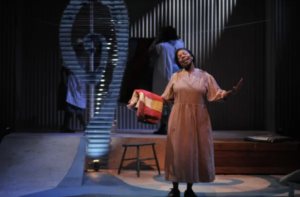
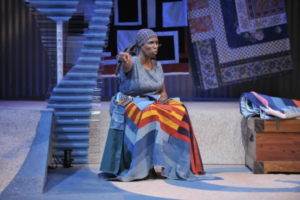
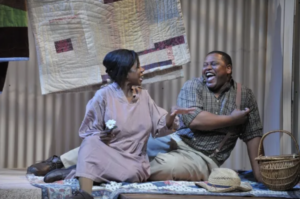
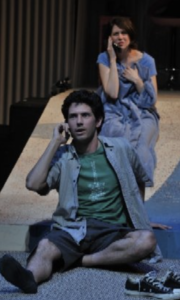
Have a fond or interesting memory of this play you’d like to share with us? We’d love to hear it!
Please Contact Us to Share!
Burning Coal Theatre
(919) 834-4001
224 Polk St., Raleigh NC 27604
Played April 15-May 2, 2010: Gee's Bend & SECCA
Season 14: (2010-2011)
To Kill a Mockingbird
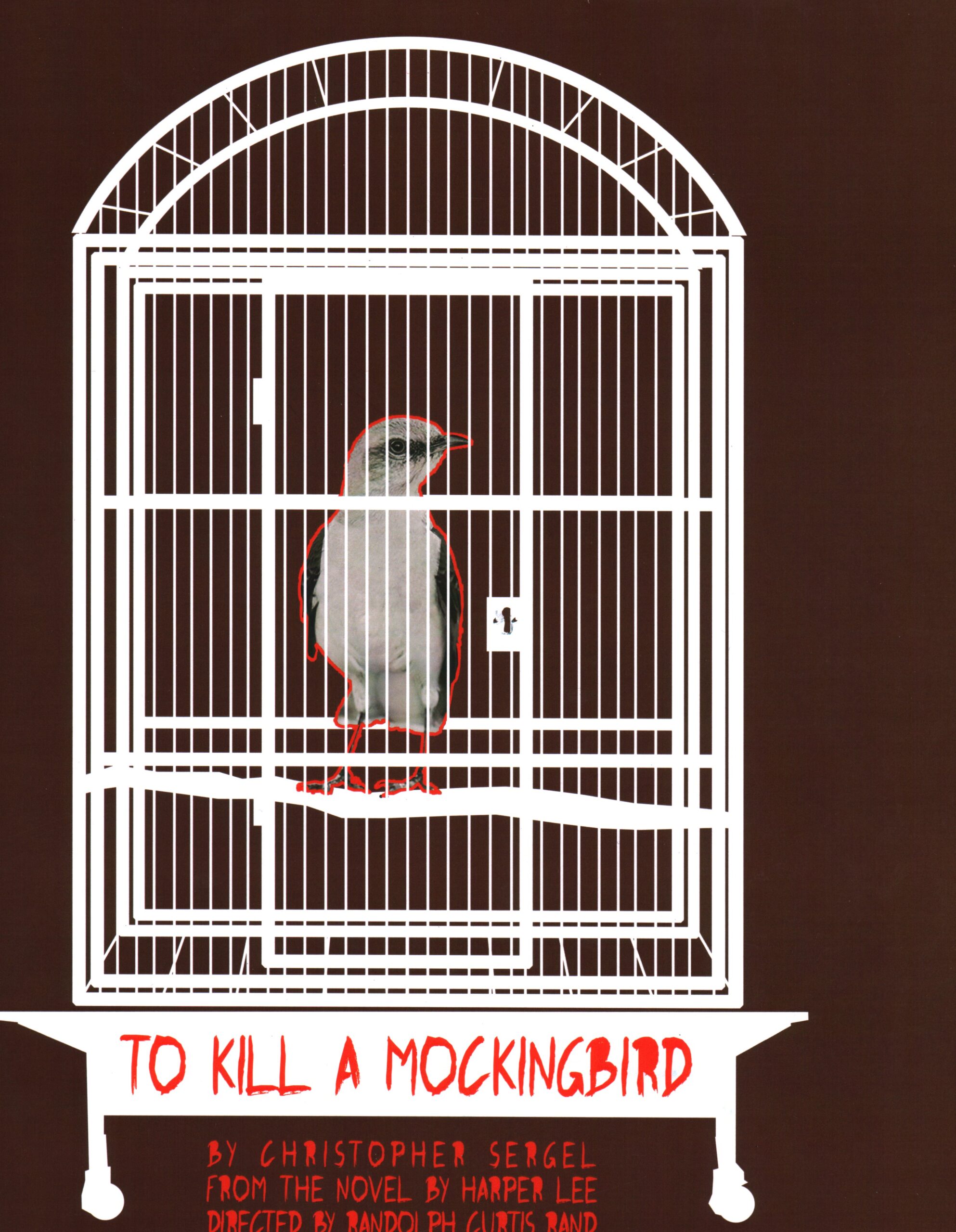
To Kill a Mockingbird by Christopher Sergel From the novel by Harper Lee
Dir. Randolph Curtis Rand
Dates: September 9-26 2010
Location: Murphey School
St. Nicholas
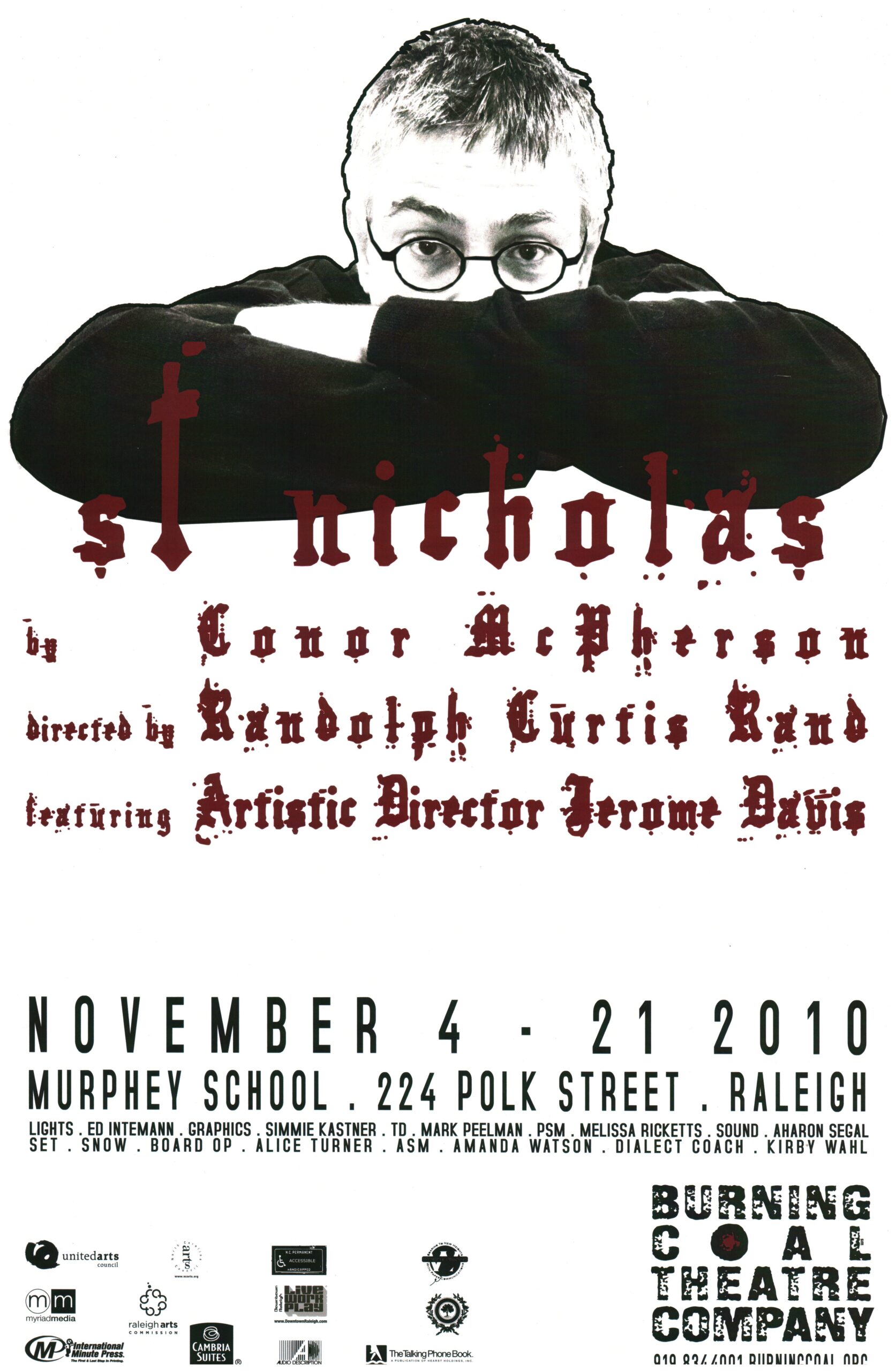
St. Nicholas by Conor McPherson
Dir. Randolph Curtis Rand
Dates: November 4-21 2010
Location: Murphey School
Crowns
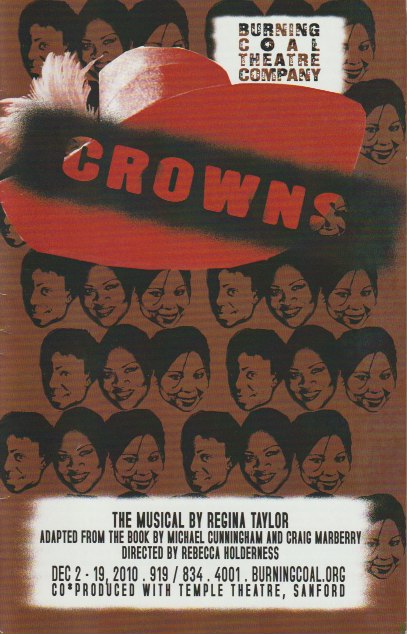
Crowns by Regina Taylor
Dir. Rebecca Holderness
Dates: December 2-19 2010
Location: Murphey School
Blue
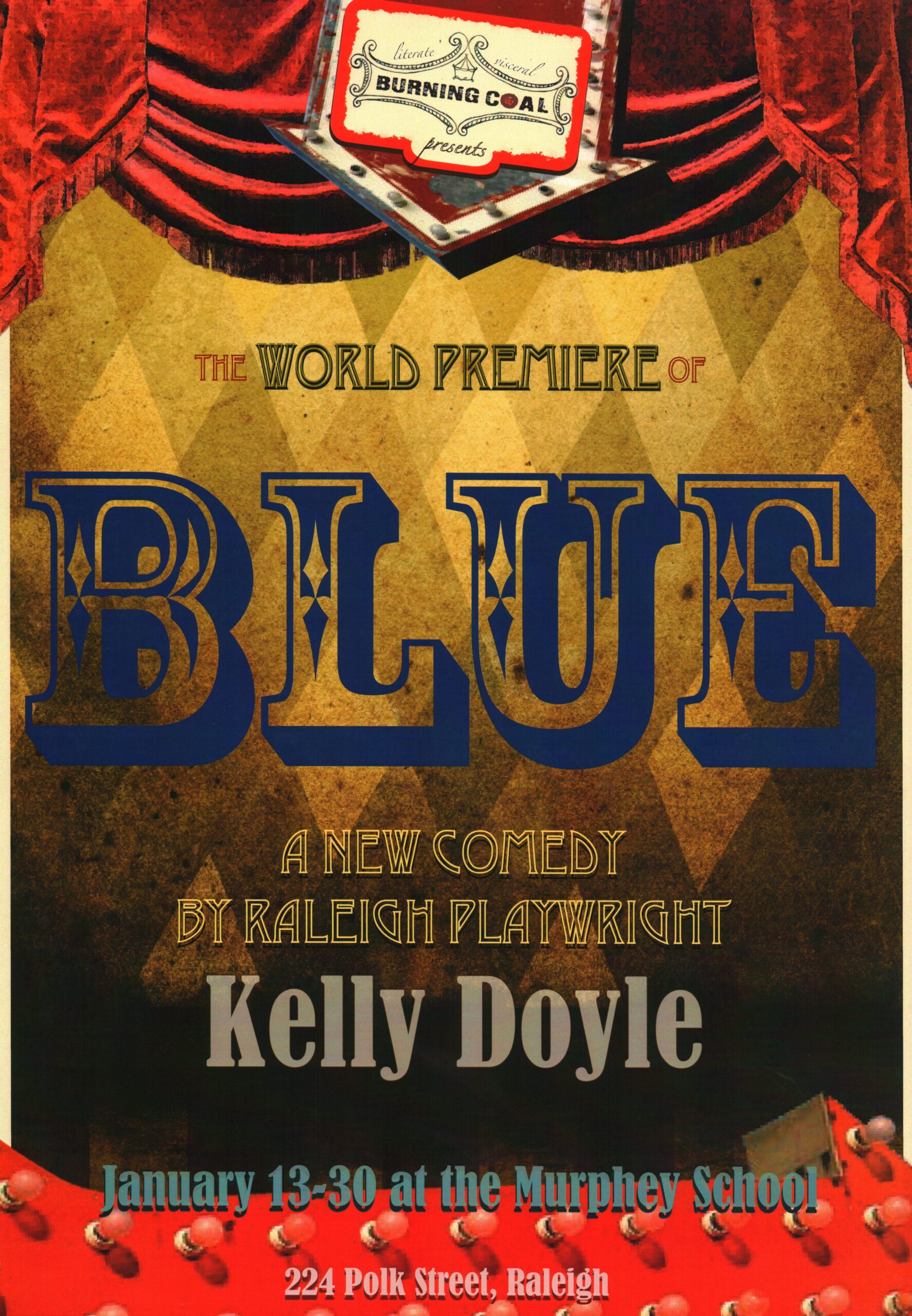
Blue by Kelly Doyle
Dir. Mark Sutch
Dates: January 13-30 2011
Location: Murphey School
The Shape of the Table

The Shape of the Table by David Edgar
Dir. Jerome Davis
Dates: April 7-24 2011
Location: Murphey School
To Kill a Mockingbird
To Kill a Mockingbird by Christopher Sergel From the novel by Harper Lee
Dir. Randolph Curtis Rand
Dates: September 9-26 2010
Location: Murphey School
Artistic Director’s Notes:
In his argument against Atticus Finch and “his type of Southern Liberalism,” the verbose Malcolm Gladwell (writing in an obscure, left-wing journal funded mainly through the lunch money saved up by the poor sharecroppers’ sons and destitute single mothers called “The New Yorker”) comes to the conclusion that Atticus was “not liberal enough” because “he’s not Thurgood Marshall, looking for racial justice through the law.” Sidestepping the fact that most would come up a tad shy if if Justice Marshall was the person against whom our “liberalness” was judged, it is a strange argument because it is applied to a) a fictional character, b) a man who lived his life a full generation before Justice Marshall and most surprisingly c) a man who did spend his (fictional) life, or at least one part of it, looking for racial justice through the law.
Mr. Gladwell goes on to make a string of accusations against Finch, including that he was sexist because he assumed the same lack of character of Mayella Ewell as radical rightists like George Wallace or Bull Connor might have assumed. But Wallace and Connor were both products of the post-Brown v. Board era and, if not the “post” then certainly the imminent feminist era. They were reactionaries whose use of hatred, bigotry, sexism and the like can, through the prism of time, be seen as a calculated effort to appeal to fear and desperation while using government to back up their digressive stance. In short, they were using the law to administer their brand of racial and gender justice. And they were doing it because a tidal wave of “liberalism” was washing over them. That wave did not materialize from thin air. It was created by the persistent attack on inhumane politics and, I will say it, unchristian principles that a relative few people managed to achieve. Those people, not all of them fictional, put their lives and more on the line to live an example to those around them.
In politics, there is only winning and losing. An argument in favor of more politicking is a naive one, at best. Atticus Finch chose a different route. He chose to live his life the way he knew it should be lived and to let that shining example resonate throughout his community. And, I dare say, that his example will continue to shine long after the smoldering hatred stirred up by Bull Connor, Governor Wallace, et al, has long been vanquished from the earth.
So, it makes no sense to compare Finch to Marshall, Wallace or Connor. Finch stood up in a certain place and a certain time and progress was achieved. Of course, he was a fictional character, but real men and women like Finch did exist and they did pave the way for the future generations of more forward thinkers. That is how it always is. Should Thomas Jefferson be discredited because of his ownership of slaves? Well, yes! But not his place in history. Should we cast aspersions on John Fitzgerald Kennedy because his treatment of his wife and other women around him can now, through the same prism, be seen as sexist? Again, yes. But still, he stood up and said “Ask not what your country can do for you…” And he deserves a place in history for having done so. Neither could Gladwell identify Jefferson’s inconsistencies as examples of a luke-warm Colonial American Liberalism. He has not seen Kennedy’s dalliances as emblematic of a Misogynistic Catholic, Massachusetts Liberalism. Surely in art, the flawed hero teaches us most about ourselves. Only in politics must human beings pretend the world is black and white.
Atticus Finch came along at a time when he was needed, and he did a thing that was needed. He did not firebomb the Pentagon or burn himself to death on the steps of the Alabama State House. Neither, I would suggest, did Mr. Gladwell, as the obvious lies leading up to the Iraq war were being plastered across the pages of his most liberal of publications.
Welcome, by the way, to our 14th season! If you haven’t noticed, we’re fired up…and ready to go! We’re going to begin by seeing how far we’ve come, how far we’ve yet to go, and how many of us recognize anything of our current world in one Ms. Lee conjured so powerfully half a century past.
Jerome Davis
Crew:
Stage Manager: Melissa Ricketts
Technical Director: Mark Peelman
Scenery Design: Snow
Lighting Design: Daniel Winters
Costume Design: Kelly Farrow
Props: Jan Morgan
Sound Design: Elijah Vick
Graphics Design: Simmie Kastner
Asst. Director: Kylie McCormick
House Manager: Joy Polhemus
Asst. Stage Manager: Samantha Corey and Rachel McCrain
Scene Painting: Molly Enis
Board Operator: Braeden Earp, Taylor Shumate, Donna Youngblood
Cast:
LeDawna Akins – Calpurnia, ReverendSykes, Mr. Gilmer
Jade Arnold – Tom Robinson, Reverend Sykes
Liz Beckham – Jean Louise/Scout
Jeff Cheek – Heck Tate/Mr. Cunnngham/Judge Taylor
Whitney Madren – Miss Maudie/Mayella Ewell, Judge Taylor, Mr. Gilmer
Paul Paliyenko – Bob Ewell/Judge/Taylor/Miss Stephanie/Old Mr. Radley/Nathan Radley/Mr. Gilmer
Adam Patterson – Cunningham Boy/Jem/Mr. Gilmer
Samantha Rahn – Dill/Miss Dubose/Mr. Gilmer
Roger Rathburn – Atticus Finch
George Spelvin – Boo Radley
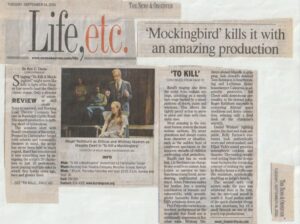
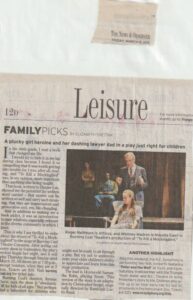
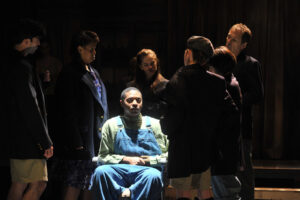
Have a fond or interesting memory of this play you’d like to share with us? We’d love to hear it!
Please Contact Us to Share!
Burning Coal Theatre
(919) 834-4001
224 Polk St., Raleigh NC 27604
Played September 9-26 2010: To Kill a Mockingbird
St. Nicholas
St. Nicholas by Conor McPherson
Dir. Randolph Curtis Rand
Dates: November 4-21 2010
Location: Murphey School
Artistic Director’s Notes:
Ten years ago, nature didn’t cooperate. Twenty inches of snow landed on Raleigh and sat there for the entire month of February. We lost most of the performances of St. Nicholas. When we were putting together this season, the play kept coming up. “Why don’t we revive that one again? “Why?” I asked. “No one saw it!” came the reply. The Seafarer (also by Conor McPherson) had just been a big success for us. And, perhaps more importantly, I was now ten years older! “Older and wiser?” I asked.
Certainly, the world has changed during the last decade. Has there ever been so slight a swath of time after which a people, a country, a world could be said to have been so altered? Perhaps the decade in which Columbus discovered the New World? Or the Decade that saw the advent of the printing press? Maybe the period between John Kennedy’s inauguration and the Altamont Festival in California? I don’t know, but I do know that I am not the same man I was then, and neither is my country.
We entered the 21st century with trepidation: the Y2K jitters, the hysterical inflating of the Stock Market bubble, fears about NAFTA, the rising tide of China, India and other emerging economies. But those fears were tempered by a certain feeling of invincibility. We can talk about a time beyond ‘the American Century,’ but can we really imagine it? I think, at the beginning of this decade, the answer to that question was an emphatic, ‘no.’ In the intervening years, we have found that we are not invincible, that our cathedrals of power can be sabotaged, both from without and from within. Besides attacks by terrorists, we have seen the Enron disaster, the Wall Street collapse and the bursting of the housing bubble. We have witnessed a steady stream of corrupt politicians uncovered, and wondered in our hearts how many were not being uncovered because their power was so great that the media did not dare shine a light on them. We have watched a decade of humiliation, or what should have been humiliation, in our beloved national pastime as the revelation of rampant steroid use was greeted mostly by yawns from the public. We have seen the division of our people into Red and Blue. We’ve weathered Katrina, fought the longest war in our nation’s history, denied climate change and protested feebly, if at all. We have seen the jobs set sail for foreign lands, the collapse of all but the shell of labor unions, the deterioration of infrastructure and (as far as I’m concerned), the almost complete loss of significant contributions to the mass marketed arts forms of popular music and film. I probably should also mention the advent of ‘reality TV,’ but since I’ve never actually seen one…
St. Nicholas is a little play by an Irishman, about an Irishman, set in Dublin and London. It is about one man’s struggle with personal demons. He is a person at the end of his rope, a man who has lost faith in himself. He’s a fellow who no longer believes in his own narrative. In his darkest moment, he sits down and begins to talk. Is he here to recite his own eulogy, or to declare his emergence from a dim dream? As you sit in the dark…listen.
Jerome Davis
Crew:
Stage Manager: Melissa Ricketts
Technical Director: Mark Peelman
Scenery Design: Snow
Lighting Design: Ed Intemann
Sound Design: Aharon Segal
Graphics Design: Simmie Kastner
Dialects Coach: Kirby Wahl
House Manager: Joy Polhemus
Asst. Stage Manager: Amanda Watson
Board Operator: Alice Turner
Cast:
The Critic: Jerome Davis
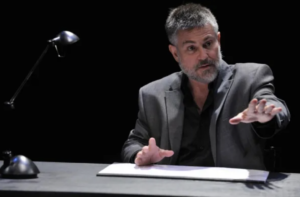
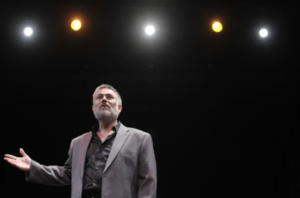
Have a fond or interesting memory of this play you’d like to share with us? We’d love to hear it!
Please Contact Us to Share!
Burning Coal Theatre
(919) 834-4001
224 Polk St., Raleigh NC 27604
Played November 4-21 2010: St. Nicholas
Crowns
Crowns by Regina Taylor
Dir. Rebecca Holderness
Dates: Dec 2-19 2010
Location: Murphey School
Artistic Director’s Notes:
We presented Crowns only a few weeks after opening the historic Murphey School auditorium. We were still feeling around for the building, trying to fit into it, trying to find our identity within its walls. The play sort of burst forth in the building and brought us into fully… because it brought our audience along in a visceral way. I was delighted! And of course wanted to bring the play back again. To my amazement, virtually the entire team of artists who first assembled this piece of us were available and willing to dive into it again.
But despite the play having been staged only 30 months ago, this production marks a true first for our company. It is the first time we have entered into a real collaboration with a sister company in our area. We are hoping it won’t be the last! The Temple Theatre has long been a source of inspiration to me and to many others who work in this business. Situated as it is in rural Sanford, NC, the theatre has managed to grow into a fully professional organization against all odds, and to stay there! With the addition of the supremely talented Peggy Taphorn, the Temple has reached artistic heights that I suspect even its most ardent supporters would not have imagined a few years ago. We are pleased and inspired to be partnering with them on this production. After our run here in Raleigh, the production will move to Sanford near the end of January.
Good neighbors! That’s a thing I remember people talking about from my youth. Has the idea grown passé? As we walk down the streets, we observe person after person on their iphones, punching digits into tiny black boxes with their thumbs, carrying on the most private conversations with the entire block listening in (though trying not to, certainly). The quality that makes up a good neighbor, that subtle combination of interest and distance kept, is narrowing to include a box selected on a website (to ‘Friend’ or not to ‘ Friend’, that is the question). It’s not easy to make the case that you are interested in another human being’s trajectory through life when you don’t have to get up out of your chair to follow them. And that other quality, the one involving knowing when to look away, to stay out, to well, butt out, is equally impossible in a world in which you can invade your ‘friend’s’ page (i.e., life) without their ever having known that you have been there.
Progress is a good thing. The problem with it comes when it accelerates so fast that looking back over one’s shoulder for guidance, for perspective, for the steps that got us to where we are as we hurdle forward to the place we (think we) want to be isn’t possible anymore. That leads to confusion, the dizziness, to spiritual malaise, perhaps. Crowns is a simple little play that suggests that those place from which we came may be critically important to who we are now and where it is we are going.
The next few years are going to be tough for those of us in the arts industry. The economy is shuddering. The world is changing and the arts, those historically slow-moving purveyors of an intangible idea called ‘culture’ are at the head of the line of activities that can be done without – so we are told. The small, most fragile groups are folding or scaling back. The large institutions are hunkering down and, more so than ever, using every resource at their disposal to claim every dollar possible from the public funding till. The in-between companies (our version of the middle class) – well, there aren’t many of those around, are there? We ask you as you watch this play tonight to stop for the length of time you are here and look back at your own life, your own trajectory, those who have lain down the stepping stones over which you have trod into the 21st century. And, as appropriate, pay respect. That act may provide clarity for the future for all of us. It may be the only thing that can.
Jerome Davis, November 2010
Director’s Notes:
As Peter Filene points out in his history of the Right-to-Die in America, In the Arms of Others, death was a familiar occurrence to Americans of the early 19th century. He quotes from a number of sources who matter-of-factly recount the deaths of loved ones or calmly anticipate their own. Since then, thanks to a myriad of medical advancements, life expectancies have lengthened dramatically, once-fatal disease have become treatable, and death has moved toward the margins of our popular consciousness.
It is in large part that increasing remoteness that makes physician-assisted suicide the political football it is, and at the same time makes it so difficult for us to address the issue reasonably. Looking at death in theoretical terms, we often perceive it as we do an object seen in the side-view mirror of a car, farther away than it really is; conversely, when we are forced to confront an individual’s demise, we often find ourselves too close to focus on the details before us. We are reluctant and ill equipped to grapple with this truly life-and-death matter. Consequently, as in the case of abortion, our national debate over assisted suicide has been characterized by rhetorical extremism: inalienable human rights on one side, death camps on the other.
The characters in A Question of Mercy know the torrid political and legal arguments for and against, but ultimately those constructs are of little use or comfort. ANthony’s allies are woefully unprepared by their experience, their value systems or their cultures to provide, or even determine precisely, what he most needs. As they desperately try to bring rationality to this discussion, even the language itself proves inadequate. “What are you saying?” the characters frequently ask each other. “What do you mean?” But though the play is rife with questions, including its title, answers are in very short supply.
Still, the characters’ struggle is a necessary one. As our world continues to evolve and technology alters our choices, we must learn again how to talk about death, to move beyond abstractions and confront it in all its difficult and individual particulars. Only then may we hope to come to terms with dying, and begin to consider our concomitant rights and obligations.
-Paul Frellick, January 1999
Crew:
Music Director: Jan Powell
Additional Choreography: Naima Adedapo
Stage Manager: Elsbeth Cassandra
Technical Director: Mark Peelman
Costume Design: Vicki R. Davis
Lighting Design: ED Intemann
Sound Design: Al Singer
Props: Kylie McCormick
Asst. Director: Alice Turner
Voice and Text Coach: Marc Williams
Graphics Design: Simmie Kastner
Asst. Music Director/Asst. Stage Manager: Samantha Corey
Asst. Stage Manager: Rachel McCrain and Janelle Netterville
Volunteer Coordinator: Kelly Watson
Board Operator: Renato Zamudio
Cast:
Naima Adedapo – Yolanda
LeDawna Akins – Wanda
Emelia Cowans – Velma
Paul Garrett – Older Man/Man with Staff/ “Dad” with Mother Shaw/Procession Leader/The Preacher
Joan J – Mother Shaw
Toni Martin – Understudy for Yolanda
Sherida McMullan – Jeanette
Yolanda Rabun -Mabel
- Delton Streeter – Younger Man/Yolanda’s Brother/Others
Have a fond or interesting memory of this play you’d like to share with us? We’d love to hear it!
Please Contact Us to Share!
Burning Coal Theatre
(919) 834-4001
224 Polk St., Raleigh NC 27604
Played December 2-19 2010 : Crowns
Blue
Blue by Kelly Doyle
Dir. Mark Sutch
Dates: January 13-30 2011
Location: Murphey School
Artistic Director’s Notes:
In 1995, George Devine founded the most important theatre in the English speaking world (so sez I): the English Stage Company at the Royal Court Theatre in Sloan Square, London. At that time, Sloan Square was not a very nice place. Devine’s actors were mostly unknowns, his budget paled in comparison to the large, West End (their “Broadway”) companies, and his playwright, John Osborne, had been a mostly out of work actor up until May, 1965m when his play Look Back in Anger opened. Devine had found the voice of a generation in a most unexpected and out of the way place.
At some point soon after that, things began to happen at the Royal Court (as it came to be known). Osboren’s play received notoriety from that one-eyed monster, television. It also drew attention of many young people, people for whom the so-called Angry Young Men (oh, what a sexist time it was!) movement had already begun to take root in other artistic forms, such as creative writing and visual arts. But in the theatre, that slow-moving purveyor of culture, the mid-50s were a time when the youth of England and the world, were on the lookout for a new direction. Noel Coward, Terrnace Rattigan and that lot had led the island nation through the clouds of war and into brighter skies, but now it was time for a chance. When they saw Jimmy Porter and his kitchen sink, they recognized their man. The other group looking at the goings on in Sloan Square, of course, were the royals. Laurence Olivier came to see Anger and, making his way backstage to meet Osborne, declared airily “I wonder if you might write something for me?” Osborne, of course, did. When The Entertainer opened the following year, the press declared “King comes to the Court!”
Sometime soon thereafter, George Devine was moved to hastily paint a slogan for his company on the brick facade separating the court’s lobby area from its auditorium, The slogan read “The Right to Fail.” This became the motto for all the work done at the Royal Court, before and since. Devine understood in that instant that what a playwright (perhaps any artist) needed more than anything else was the opportunity to not produce a great work. In the struggle to do so, regardless of the ultimate success, greatness would eventually emerge. And so it has. The Royal Court has either fostered or eventually pulled into its orbit more or less every great playwright of the last 55 years. It continues to produce amazing plays, seemingly out of thin air, and, too, the clunkers that will not likely be heard from beyond their month-long run at the Court.
If you are in London, make a sojourn to the off-beat Royal Court at Sloan Square, The slogan has long since faded from the wall, but the spirit of George Devine and his once-in-a-century idea live on to this day.
Jerome Davis/January, 2011
Director’s Notes:
O.k- Here’s the problem. While the “lighter” characters in this play have straightforward, though descriptive names (“Fang”, “Shallow”, “Tere-Sheet”), and most use diminutives (“Jack”, “Ned”, “Doll”), what the “higher characters call themselves is a little more complicated.
To start with, there’s the sir name. All royalty has shown tremendous lack of imagination in this matter (they would say they “uphold tradition”). Thus, we have the King, Henrie IV, whose oldest son is called Henry, and next son is called John, after his grandfather. And we have Henry Percy, Earl of Northumberland, and his son … Henry Percy. Indeed, the nobility probably need the variety. What with all the Henrys, Johns, and Thomases, a council of Parliament might easily turn into a production of The Bald Soprano.
To make things simpler, these nobles sometimes use nicknames. Both King Henrie and Prince Henry are called “Harry”. But the Prince is also called “Hal”, so that helps. And Henry Percy (Fils) is called “Hot-Spurre”, so there’s no confusion with dad. But dad is usually called a name the royals used most often with each other; that of title. So Percy (Pere) is “Northumberland”, his brother “Worcester”, the King’s sons’ “the Prince of Wales”, “Lancaster”, “Gloucester”, “Clarence” (yes, Clarence is a title, his name is Thomas). These titles derive from actual counties in England that owed money and allegiance to their lord. It would be like someone calling you “North Raleigh” or me “Brooklyn” (well, “Fort Green” anyway).
Even simpler, the nobles just as often call themselves by where they were born. So, Henrie – “Harry” – “Hal” – Prince of Wales, is called Henrie “Monmouth”, his father Henrie “Bollingbroke”, and his father, John “of Gaunt”. Simpler still, though least used, is the family name. Edmund is called “Mortimer”, the Percys are called “the Percys”, and the King’s family is called “Plantagenet” (but only once)!
Simplest of all is the nice habit the nobility has of calling anyone of any relation to them “Cousin”. And Kings of different countries, who are no relation whatsoever, call each other “Brother”.
So, is everything clear?
O.k. On to spelling and pronunciation….
Randolph Curits Rand, May 1999
Crew:
Stage Manager: Jessica McGloin
Technical Director: Mark Peelman
Costume Design: Katy Werlin
Lighting Design: ED Ijtemann
Sound Design: Aharon Segal
Props: Rachel McCrain and Eslbeth Cassandra
Asst. Director: Samantha Corey
Graphics Design: Sara Outing
Asst. Stage Manager: Tanner Norris and Alice Turner
Volunteer Coordination: Kelly Watson
Board Operator: Dominique Grizzle
Cast:
John Allore – William
John Jimerson – Adagio
Kerrie Seymour – Louise
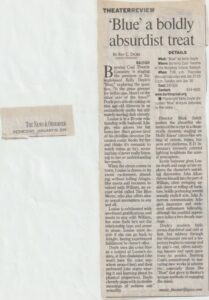
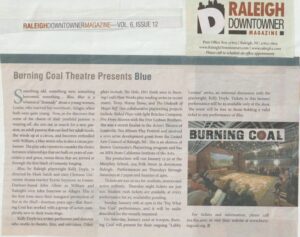
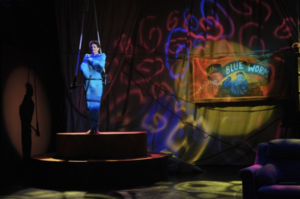
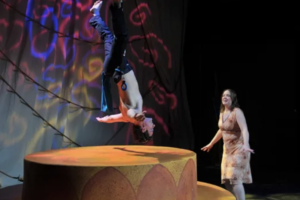

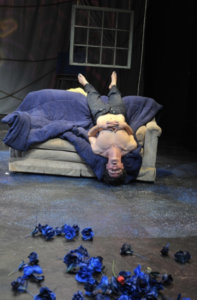
Have a fond or interesting memory of this play you’d like to share with us? We’d love to hear it!
Please Contact Us to Share!
Burning Coal Theatre
(919) 834-4001
224 Polk St., Raleigh NC 27604
Played January 13-30, 2011: Blue
The Shape of the Table
The Shape of the Table by David Edgar
Dir. Jerome Davis
Dates: April 7-24 2011
Location: Murphey School
Crew:
Lights: Matthew Adelson
Set Design: Robert Andrusko
Asst. Director: Jackson Bloom
Asst. Stage Manager: Austin Dennis, Courtney Pisano, and Tanner Norris
Costumes: Kelly Farrow
Video: Roz Fulton
Graphics Design: Simmie Kastner
Stage Manager: Kylie McCormick
Props: Jan Morgan
Board Operator: Janelle Netterville
Sound Design: Sharath Patel
Technical Director: Mark Peelman
Dramaturg: Alice Turner
Cast:
James Anderson – Pavel Prus
PJ Maske – Victoria Brodskaya
Julie Oliver – Vera Rousova
Prime Minister – Peter Tedeschi
Tom McCleister – Victor Spassov
Tamara Farias Kraus – Monica
John Allore – Vladislav
Nick Berg – Lutz
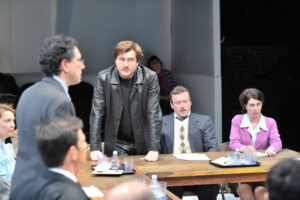
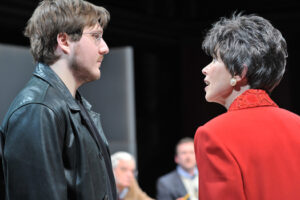



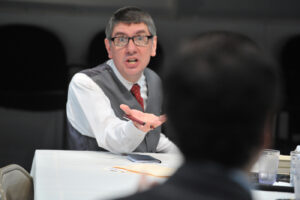
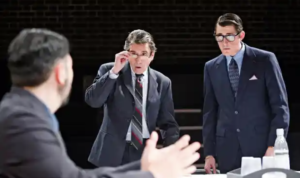

Have a fond or interesting memory of this play you’d like to share with us? We’d love to hear it!
Please Contact Us to Share!
Burning Coal Theatre
(919) 834-4001
224 Polk St., Raleigh NC 27604
Played April 7 - 24, 2011: The Shape of the Table
Season 15: (2011-2012)
Enron
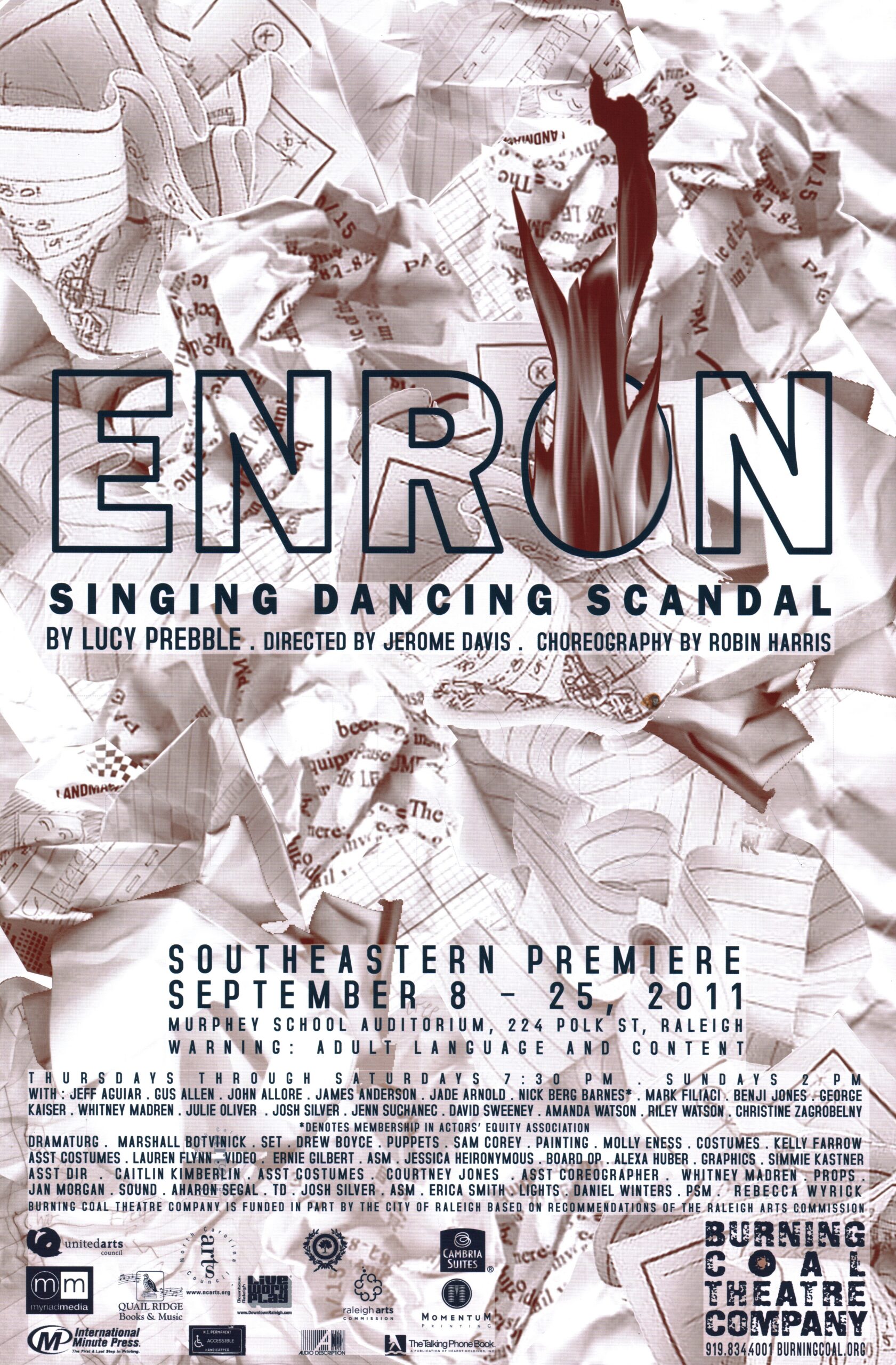
Enron by Lucy Prebble
Dir. Jerome Davis
Dates: September 8-25 2011
Location; Murphey School
Henry V (on Trapeze)
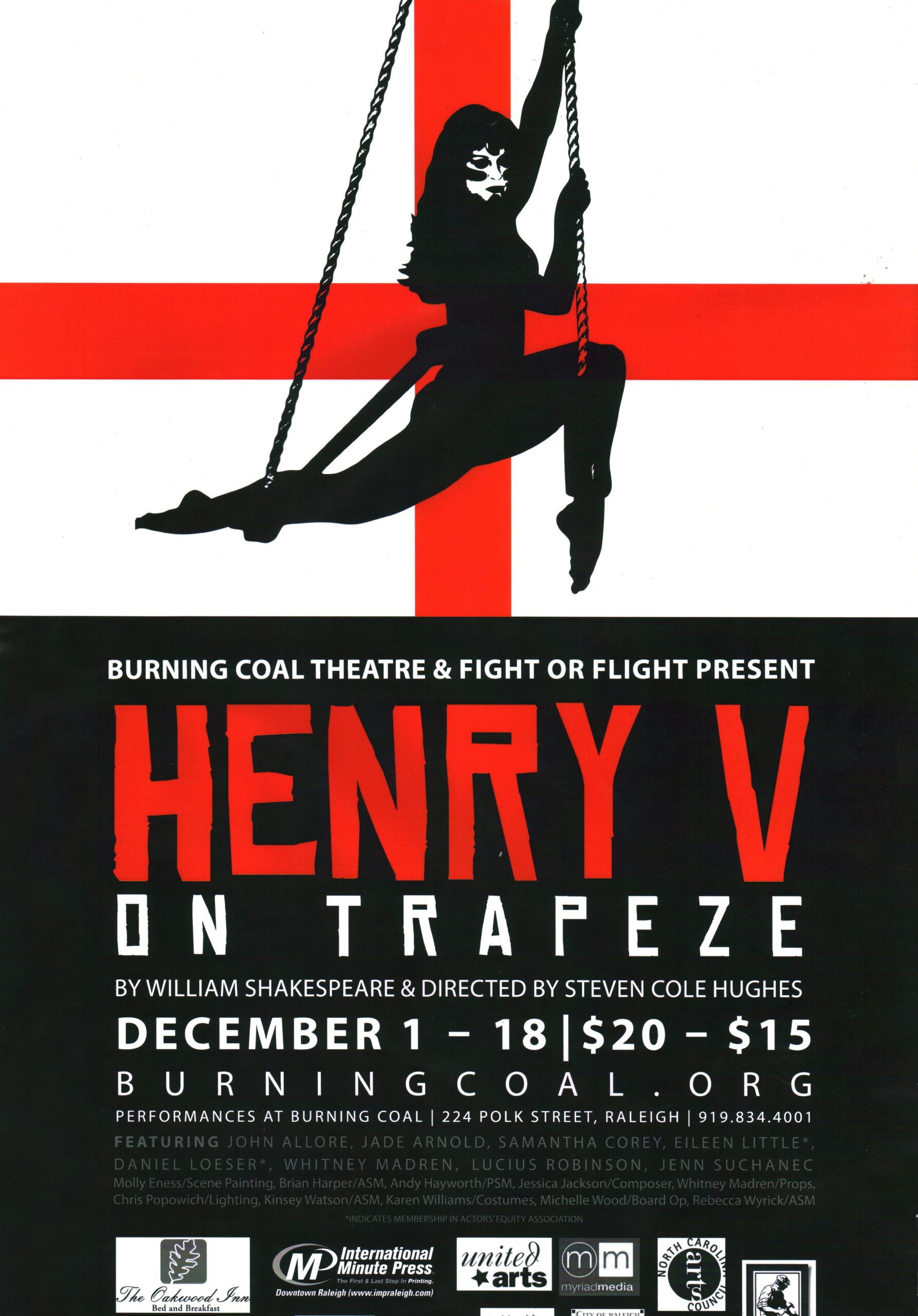
Henry V (on Trapeze) by William Shakespeare
Dir. Stephen Cole Hughes
Dates: December 1-18 2011
Location: Murphey School
Man of La Mancha
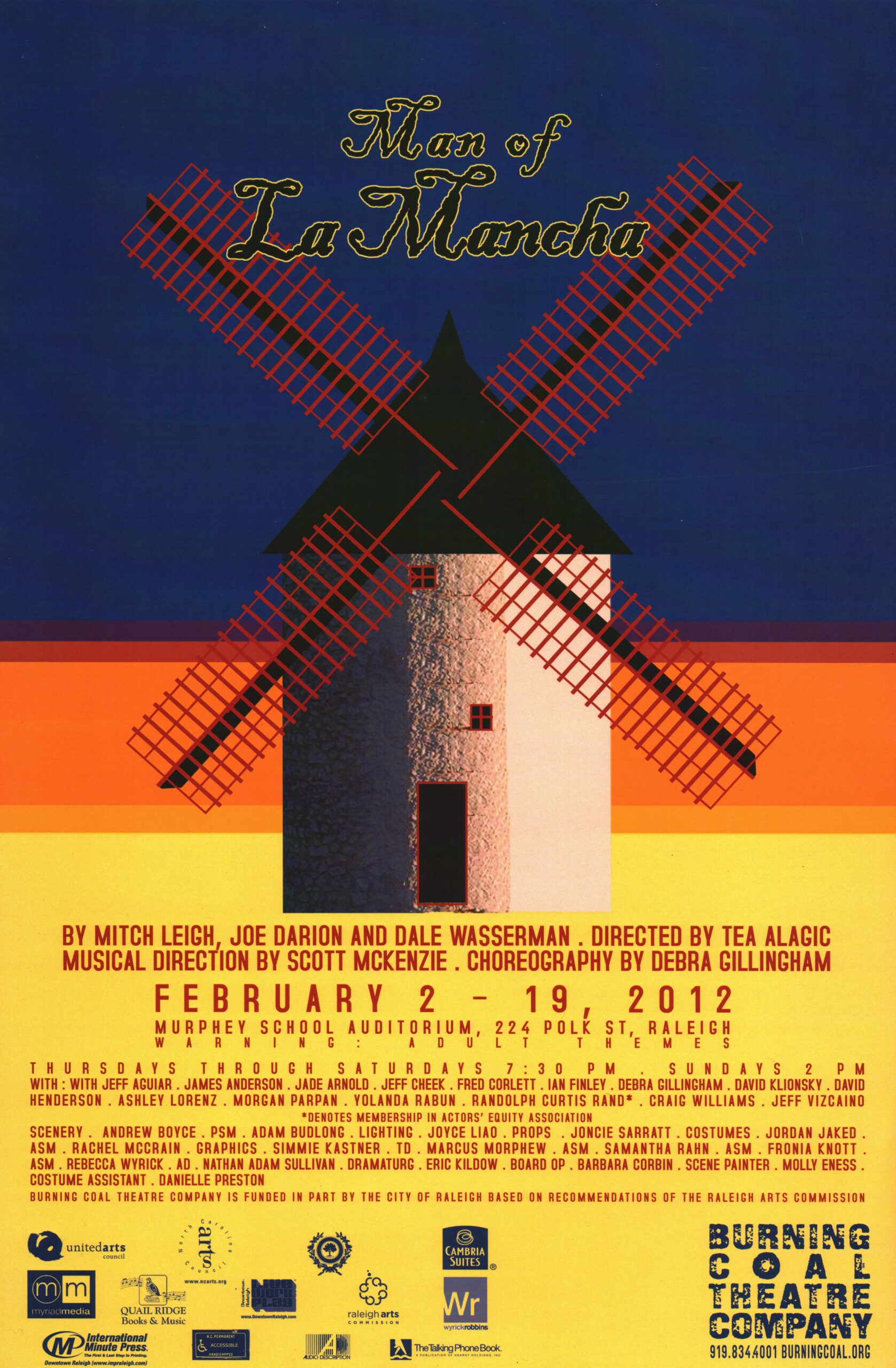
Man of La Mancha by Mitch Leigh, Joe Darion, and Dale Wasserman
Dir. Tea Alagic
Dates: February 2-19 2012
Location: Murphey School
Jude the Obscure
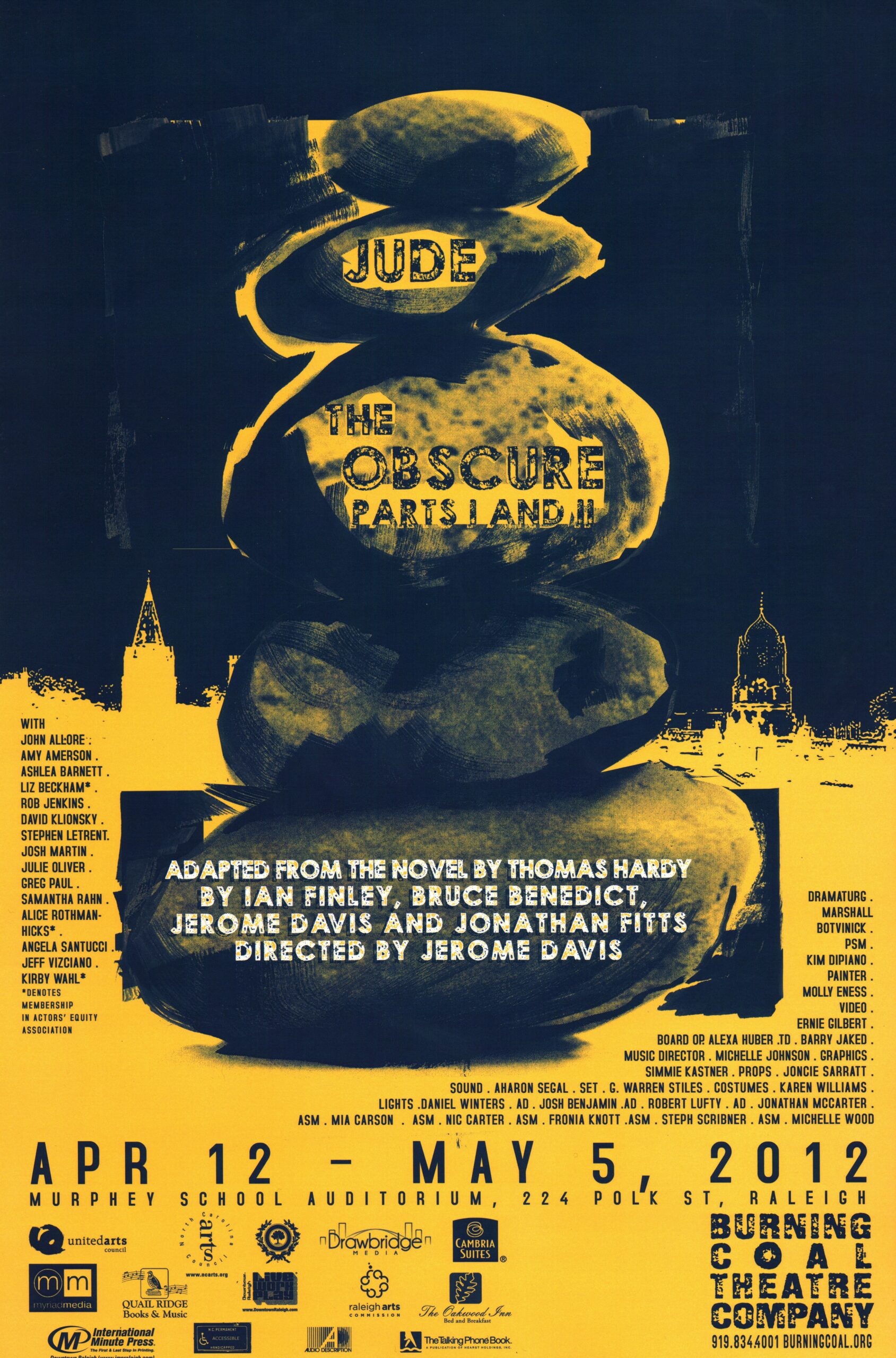
Jude the Obscure, Parts 1 & 2Adapted from the novel by Thomas Hardy By Ian Finley, Bruce Benedict, Jerome Davis, and Jonathan Fitts
Dir. Jerome Davis
Dates: April 12-May 5 2012
Location: Murphey School
Enron
Enron by Lucy Prebble
Dir. Jerome Davis
Dates: September 8-25 2011
Location: Murphey School
Artistic Director’s Notes:
“Why Ask Why?” This corporate mantra was Enron’s calling card. It was a double-edged question. Lay, Skilling, Fastow, et al, used the expression to communicate the idea of the power of inquisitiveness, curiosity, creativity. Those would seem like good traits for a company to be developing amongst its employees, board and shareholders. “Look closer,” they seemed to invite. But when someone did, the view was terrible. How did the company most forcefully advocating those positive ideals end up as a poster child for corporate skullduggery
The answer perhaps is that intellectual rigor alone cannot guide the human species. We still have animal needs that push against our thin veneer of civility, When we jettison thought and its offspring, empathy, we find ourselves in a society that is ungovernable, and in which the self takes center stage over the opposing players of ‘community’ and ‘progress; (Somalia, Serbia).
But the other end of the spectrum, intellectual development without humane regulations, takes us, it seems , to the same outcome. Who would doubt the intelligence of Bernie Madoff or, for that matter, the journalist behind England’s scandal involving wire-tapping of private citizens at their most vulnerable? Yet they, like the Somalian warlords or facist armies, find themselves engaged in precisely the same activity – the enrichment of the self at the expense of the community, This ought to tell rational thinking people on any side of the political spectrum that our society cannot move forward without an underpinning of ethical mooring. The issue is not, and never was, “Whose side are you on, Joe?”
I’ve been thinking a lot about Joe Strummer while working on Enron, maybe because of the cadences in the writing of Lucy Prebble, the preternaturally talented young playwright. Her words spill out, violent, abrupt, harsh. Maybe it has something to do with the subject matter, though an oil & gas company in Houston would not seem to share much in common with the Turkish-born son of a British diplomat turned front man for the radical punk band The Clash. Joe’s desire to change the world, like Skilling’s, was fierce, brutal, and in some ways selfish.We know what Skilling was after. What about Strummer, this young man who changed musical genres as fashions changed, but always seemed to find a voice of controlled rage, anger, and sadness that achieved in his art the rarest of qualities: authenticity? He struggled to articulate his intentions. That same fellow, who died of a sudden heart attack at 50 in 2002, was a spokesperson for an idea that was most recently, succinctly and perhaps slightly inadvertently voiced by Republican ex-Governor of Louisiana, Buddy Roemer. He was asked to define “corruption.” He responded with a beautifully simple answer. He essentially said that corruption was when money and power elbowed out talent, creativity, intelligence, drive, wisdom and enthusiasm. In other words, it doesn’t matter if your idea is a good one, it is your idea, and I can’t make a profit from that.
In Mark Kurlansky’s book Nonviolence: The History of a Dangerous Idea, Kurlansky points out that nonviolence is so radical an idea that most societies don’t even have a word for it (other than one that takes its alternatives, violence, and turn it into a negative). He’s right. Joe Strummer, after helping create the increasingly violent punk scene that mushroomed across the West in the late 70s and early 80s, walked away and sought, instead, to articulate through his life, his behavior, his art, Kurlansky’s nonexistent word. He passed on far, far, too soon, leaving in his wake people that you and I might think should have gone in his stead. Joe never met Jeffrey Skilling, but I can imagine Joe bouncing up to him, extending his hand, clapping him on the back and saying, “Jeff. Man. What were you thinking?” Then sitting down with those inquisitive eyes and ears, hunched forward, and listening. He was out to change the world, one question at a time.
Enjoy Enron. It is a happy play about our darkest hour. Our 15th season (can you believe it?) continues in December with Shakespeare’s Henry V (on Trapeze) the lovely Man of La Mancha in February, and finally the world premiere of an epic new version of Thomas Hardy’s last great masterpiece, Jude the Obscure, Parts 1 & 2. I can’t wait to roll this year out. It’s going to be a blast!
Jerome Davis
Crew:
Choreography: Robin Harris
Stage Manager: Rebecca Wyrick
Scenery Design: Drew Boyce
Costume Design: Kelly Farrow
Lighting Design: Daniel Winters
Sound Design: Aharon Segal
Video Design: ernie Gilbert
Props: Jan Morgan
Music Director: Jalie Oliver
Asst. Director: Caitlin Kimberlin
Graphics Design: Simmie Kastner
Asst. Stage Manager: Erica Smith, Arya Sundaram
Dramaturg: Marshall Botvinick
Board Operator: Alexa Huber
Technical Director: Josh Silver
Master Electrician: Stephen West
Scene Painter: Molly Eness
Puppetry Design: Samantha Corey
Asst. Scene Design: Sarah Muxlow
Asst. Choreographer: Whitney Madren
Asst. Costumer: Courtney Jones and Danielle Preston
Asst. Scene Painter: Lauren Flynn
Cast:
Jeff Aguilar – Trader #3/Lehman Bro #2/Mouse #3/News Report/Court Officer
Gus Allen – Trader #7/Ramsay/JP Morgan/Senator/Employee
John Allore – Andrew Fastow
James Anderson – Lawyer/Trader #1/Business Analyst/Business Anchor
Jade Arnold – Security officer/Analyst/Trader #3
Nick Berg Barnes – Jeffrey Skilling
Mark Filiaci – Ken Lay
George Kaiser – Schwartzenegger/Mouse #1/Trader #6/Raptor #3/Employee $4
Whitney Madren – Hewitt/Reporter/Prostitute/Stripper #2/Trader/Voice #1
Julie Oliver – Sheryl Sloman/Irene Gant/Member of the Board
Benji Jones – Trader/Congresswoman/Female Analyst/Business News/Raptor #2
Josh Silver – Trader #4/Lehman Bro #1/Mouse #2/Police Officer #1
Jenn Suchanec – Claudia Roe
David Sweeney – Arthur Andersen/Trader
Amanda Watson – Trader/Stripper #1/Older daughter/Secretary/Officer #2
Riley Watson – Skilling’s Daughter
Christine Zagrobelny – Trader/Press/Stripper #3/Raptor #1/Employee #2

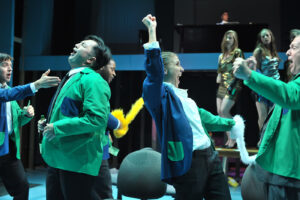
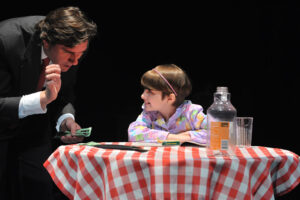
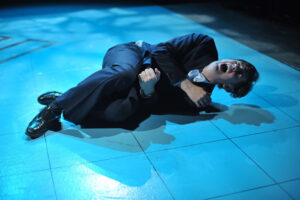
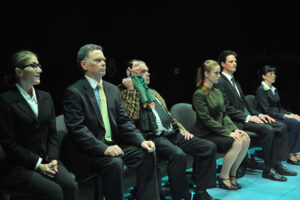
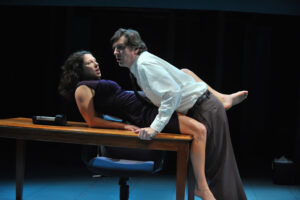

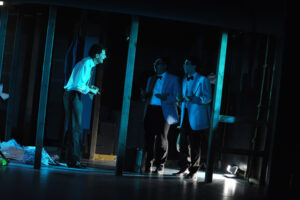
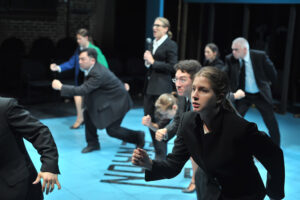
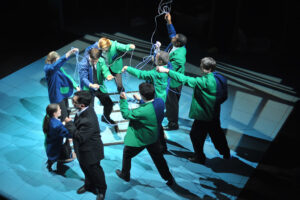
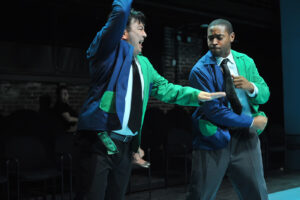
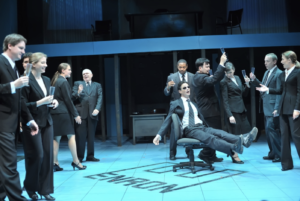
Have a fond or interesting memory of this play you’d like to share with us? We’d love to hear it!
Please Contact Us to Share!
Burning Coal Theatre
(919) 834-4001
224 Polk St., Raleigh NC 27604
Played September 8-25 2011: Enron
Henry V (on Trapeze)
Henry V (on Trapeze) by William Shakespeare
Dir. Stephen Cole Hughes
Dates: December 1-18 2011
Location: Murphey School
Artistic Director’s Notes:
Shakespeare achieves greatness by doing two things at once: his poetry soars to the stars, while his humor and violence plummets or wallows in the dirt. When his plays are at their best, both of these very human impulses are on display, pulling against each other, creating tension that is palpable and, for us humans, very recognizable. Think of Hamlet. The language, the lyricism, the beauty of that text is enough to lift the most leaden spirit. But the plot is quite base: the thirst for revenge, the lust of Claudius for power, of Gertrude for sex, of the grave diggers for some spark of life to invigorate their drab existence. Think of Much Ado About Nothing, with its beautiful love scenes juxtaposed against the scheming imp, Don John or the bumbling constable Dogberry and his ‘watch’. Think of Prospero’s beloved books, his hatred of mendacity, then compare that with his selfish desire to keep his young daughter separate from the world, or the evil spirit that he himself inflicts in his treatment of the aboriginal Caliban or the spirit, Ariel.
The examples are only limited by the approximately 37 texts that Shakespeare put his name too. In each case, the sublime mingles and bleeds into the earthy, the gritty, the impulsive, and in this juxtaposition, Shakespeare identifies both ‘the guilty party’ and the hero or heroine: us! This is what we learn from Shakespeare, why we continue to do his plays. He teaches us where to look for answers: within.
It is my great pleasure to collaborate with Fight or Flight Theatre out of New York City. We’ve had so much joy working with these whimsical artists, hell-bent on finding a physical manifestation for the lyricism of Shakespeare’s language. Their rigorous approach to training, a daily thing for them, has been a revelation. Uta Hagen talked about the fact that musicians may play their instruments daily, dancers may approach the barre (so to speak), and painters may paint, but for actors, it is generally only when they are in a play that they get to practice their craft. The good men and women of Fight or Flight have a special way of practicing their craft, and they do it daily. This is the way to get good at something, no? Someone once said that amateurs practice until they get it right, while professionals practice until they can’t get it wrong. I’m happy to be in the company who are working very hard to make sure they can’t get it wrong…and I’m equally happy to report that their work has inspired us, as a company, immensely. My hope for you is that their work, which is now our work, will be an inspiration to you, too.
Happy holidays to you all!
Jerome Davis
Crew:
Stage Manager: Andy Hayworth
Technical Director: Marcus Morphew
Costume Design: Karen Morgan Williams
Lighting Design: Chris Popowich
Props: Whitney Madren
Master Electrician: Stephen West
Music Composer: Jessica Jackson
Graphics Design: Liza Donovan
Asst. Stage Manager: Brain Harper, Samantha Rahn, Rebecca Wyrick, Christine Zagrobelny
Dramaturg: Jon behlman
Board Operator: Michelle R. Wood
Cast:
John Allore – Hostess, Constable, Alice, Fluellen, MacMorris, Jamy
Jade Arnold – Exeter, Bates
Samantha Corey – Canterbury, Cambridge, Orleans, Williams
Eileen Little – Chorus, Bardolph, Scroop, Katherine
Daniel Loeser – Henry
Whitney Madren – Dauphin, Grey, Governor
Lucius Robinson – Ely, Westmoreland, Pistol, French King
Jean Suchanec – Montjoy, Nym, Gower
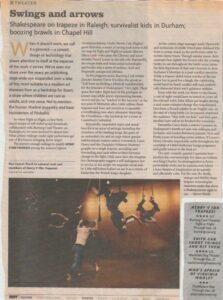
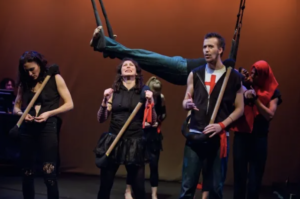

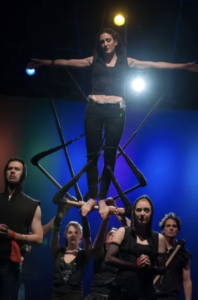
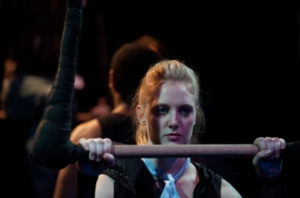
Have a fond or interesting memory of this play you’d like to share with us? We’d love to hear it!
Please Contact Us to Share!
Burning Coal Theatre
(919) 834-4001
224 Polk St., Raleigh NC 27604
Played December 1-18 2011: Henry V (on Trapeze)
Man of La Mancha
Man of La Mancha by Mitch Leigh, Joe Darion, and Dale Wasserman
Dir. Tea Alagic
Dates: Feb 2-19 2012
Location: Murphey School
Artistic Director’s Notes:
Thank you for coming to see Man of La Mancha. I saw it first when I was maybe seventeen years old. It moved me deeply. I think it is safe to say it changed the direction of my life. Sitting in a little log-cabin into which a tiny theatre had been carved…I lost control of my tear-ducts! The song “What Does He Want of Me?” did it. The actress who sang it gave a marvelous and gritty reading of the role and of that song and, for the remainder of the evening, I was pretty much a blubbering mess. Prior to that evening, I had always thought about theatre as a vehicle for my own rather narrow interests (to be famous!). That night I began to think of the theatre as a tool with which to change the world. But the question of that song goes far beyond the simple story of Don Quixote. We are born, we live, we die. In the meantime, what are we to do? What is expected of us?
I don’t know the answer to that, of course, but I do know that I seriously began to consider that question for the first time in my life that night.
Out in the streets right now there are a lot of people asking that question of themselves and their neighbors. From the Arab Spring to the Occupy movement we are seeing ordinary people the world over, the quiet ones who for generations have been happy to make it through the day unnoticed, spilling into the streets. In the U.S. at least, violence has been minimal, thankfully, yet the windmills…er, I mean the powers that be…have strenuously insisted that the Occupiers have no purpose. Cervantes’ notion, I think, was that through an act of human will, of creative imagination, one might re-mold the world into something better. It seems to me much of the same idea that we’ve seen in the Occupy movement. Now that is a Quixotic idea if ever there was one. Gandhi had such an idea. So did Mandela. In each case, their Quixotic ideas have proven not just possible but the only way forward. There is no doubt in my mind that will ultimately prove to be the case again.
In fact, the past century has been a century full of Quixotic ideas. The humans could take flight. That the human voice might be recorded, and kept for posterity. That illnesses and disease might be wiped from the face of the earth. In America, we have raised up a middle class of such power, such wealth that all the world stands back in wonder. Labor unions rose, workers’ rights were fought for and achieved, women and minority populations have striven for and received something approaching equal rights, advanced education was extended to a wide swath of the population. In the early 70s we bought a corrupt President to resign, and ended a brutal war by marching in the street, by putting flowers in our hair.
I am happy to present this theatre piece to you and happy to follow it up in a few weeks with the two part Jude the Obscure. That production, which deals with a similar theme, will be the first time that any theatre has attempted to put Thomas Hardy’s great novel onstage. I hope you will come join us as we embark upon that magical journey – the journey of creating, through the force of will, something new. A world premiere! Right here in Raleigh. Until then!
Jerome Davis
Crew:
Music Direction: Scott McKenzie
Choreography: Debra Gillingham
Stage Manager: Adam Budlong
Technical Director: Marcus Morphew
Scenery Design: Andrew Boyce
Costume Design: Jordan Jaked
Lighting Design: Joyce Liao
Sound Design: Michael Betts, II
Props: Joncie Sarratt
Asst. Director: Nathan Adam Sullivan
Fight Choreographer: Christine Zagrobelny
Graphics Design: Simmie Kastner
Asst. Stage Manager: Fronia Knott, Rachel McCrain, Samantha Rahn, Rebecca Wyrick
Dramaturg: Eric S. Kildow
Scenic Painter: Molly Eness
Master Electrician: Steven West, Liz Albright
Asst. Costumer: Danielle Preston
Board Operator: Barbara Corbin
Spot Ops: Courtney Pisano, Jamie Stephens, Alice Turner, Kinsey Watson
Cast:
Jeff Aguiar – Juan/Barber
James Anderson – Padre/Paco
Jade Arnold – Jose
Jeff Cheek – Dr. Carrasco/Antonia’s fiancée/Knight of Mirrors
Fred Corlett – Innkeeper
Ian Finley – Paco
Debra Gillingham – Maria/Housekeeper
David Henderson – Sancho Panza
David Klionsky – Pedro
Ashley Lorentz – Antonia
Morgan Parpan – Fermina
Yolanda Rabun – Aldonza/Dulcinea
Randolph Curtis Rand – Don Quixote/Alonso Quixana
Jeff Vizcaino – Tenorio
Edward H. Cooke – Tour Sancho
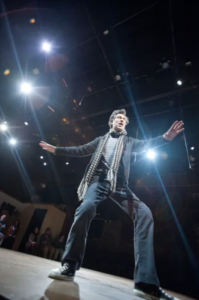

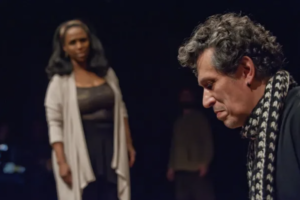
Have a fond or interesting memory of this play you’d like to share with us? We’d love to hear it!
Please Contact Us to Share!
Burning Coal Theatre
(919) 834-4001
224 Polk St., Raleigh NC 27604
Played February 2-19 2012: Man of La Mancha
Jude the Obscure
Jude the Obscure Adapted from the novel by Thomas Hardy By Ian Finley, Bruce Benedict, Jerome Davis, and Jonathan Fitts
Dir. Jerome Davis
Dates: April 12-May 5 2012
Location: Murphey School
Artistic Director’s Notes:
I’ve enjoyed working on Jude so very much. “It must be a natural thing,” says Arabella Donn. “Bringing something new into the world.” Indeed. A natural, and a difficult thing. When you work toward that sort of goal with people like the ones I’ve been blessed to work with on Jude, it is far less painful and far more rewarding that it might be. With this production, I’ve had the honor of working again with our brilliant writer/education director/actor/musician/foodie/all around theatre geek Ian Finley, the disturbingly talented Jonathan Fitts and the quietly brilliant Bruce Benedict. Our musical direction team of Julie Florin and Lawson Taylor, with help from two music directors in their own rite, Julie Oliver and Angel Santucci, has made this process not only pain-free, but fun. I wanted to thank all of them, plus our cast, designers and stage management, the hardest working in the show business, for helping realize this long held dream.
Hardy’s work has always appealed to me. I’m not entirely sure why. On a recent theatre trip abroad, I’ve been reminded over and over that people, intelligent, discerning, well-educated though they may be, most often are drawn to works of art that look like them. This has always disturbed me a bit, yet I cannot help feel that if it is true for others, it must actually be true for me. So, what is it about Hardy’s people, place and time that so attracts me? From The Mayor of Casterbridge to Far From the Madding Crowd to Jude the Obscure, I immediately found myself immersed in a world in which, against all odds, I felt comfortable. I come from a rural background, as do most of Hardy’s people, I probably had aspirations not unlike their one, I Had and continue to have a deeply held belief in what is sometimes called “the Protestant Work Ethic” (a work ethic that applies, in my experience, to pretty much every classification of people), and I loathe hierarchy, yet feel myself perpetually pulled towards its enticing comforts. I believe, as Jude does at the beginning of this story, that education and morality (whether ‘organized’ or otherwise) are the foundational blocks upon which to address the great questions: “Why are we here?” “How did we get here?” and “What ought we do while here?” And yet this book, this beautiful, terrible story, which I have regularly found myself declaring as “my favorite” over the past month, questions every bit of that and then some.
As the walls of civilization shake before us here in the midst of our reconfiguration of human institutions and mores, we find ourselves, as did Hardy’s ‘Wessex’ people, questioning the very institutions we’ve spent a lifetime building up. If an artist’s true mission is to question, then now is a darned good time for artists to step forward in our culture. Will the institutions support us in that goal? Will we support our own selves in that goal, or will we retreat, yet again, into the comfortable place of light entertainment, of cynical ‘irony’, of distancing techniques that allow us to feel superior to rather than engaging in the struggle to make sure that as our institutions crumble yet again around us, those struggles we build in their place are more supportive of humankind, not less so?
Jerome Davis, April 2012
Crew:
Music Director: Julie Florin and Lawson Taylor
Stage Manager: Kim DiPiano
Technical Director: Barry Jaked
Scenery Design: G. Warren Stiles
Costume Design: Karen Williams
Lighting Design: Daniel Winters
Sound Design: Aharon Segal
Video Design: Ernie Gilbert
Props: Joncie Sarratt
Asst. Director: Josh Benjamin and Robby Lotfy
Graphics Design: Simmie Kastner
Asst. Stage Manager: Mia Carson, Nic Carter, Steph Scribner, Lindsay Urena, Michlle Williams
Dramaturg: Marshall Botvinik
Scenic Artist: Molly Eness
Master Carpenter: Stephanie Byrd
Cast:
John Allore – Vilbert, Gibbon, Father, Tinker Taylor, Chairman, Registrar, Unionist
Amy Amerson – Caroline, Miss Fontover, Woman in the Crowd, Drunken Woman, Schoolmistress, Third Landlady
Ashlea Barnett – Mabel, Anny, Freckles, Neighbor, Bride, Beth
Liz Beckham – Arabella
Rob Jenkins – Tiler, Challow, Foreman, Parson, Tetuphany, Kemble, Gillingham, Brewer, Soldier, Doctor
David Klinosky – Blacksmith, Farmer Troutham, Mr. Donn, Newman, Uncle Jim, Wheelwright, Groom, Thomas, Auctioneer
Stephen LeTrent – Jude
Josh Martin – Young Jude/Little Father Time
Julie Oliver – Aunt Drusilla, Bower O’Bliss, Washerwoman, Charwoman, Auctiongoer 1, Second Landlady
Greg Paul – Carter, Constable, Miles, Browning, Conductor, Porter, Mason, Auctiongoer 3, Husband
Samantha Rahn – Gilly, Pupil, Girl in the Crowd, Messenger, Clair, Daughter
Alice Rothman-Hicks – Sue
Angela Santucci – Sarah, Mrs. Hawes/Landlady, Cake Seller, Rachel, Auctiongoer 2, Mother, First Landlady
Kirby Wahl – Philloston

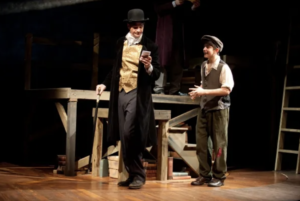

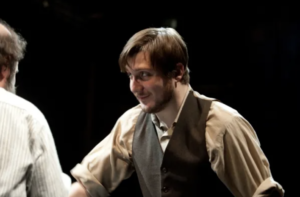
Have a fond or interesting memory of this play you’d like to share with us? We’d love to hear it!
Please Contact Us to Share!
Burning Coal Theatre
(919) 834-4001
224 Polk St., Raleigh NC 27604
Played April 12-May 5 2012: Jude the Obscure
Season 16: (2012-2013)
Brigadoon
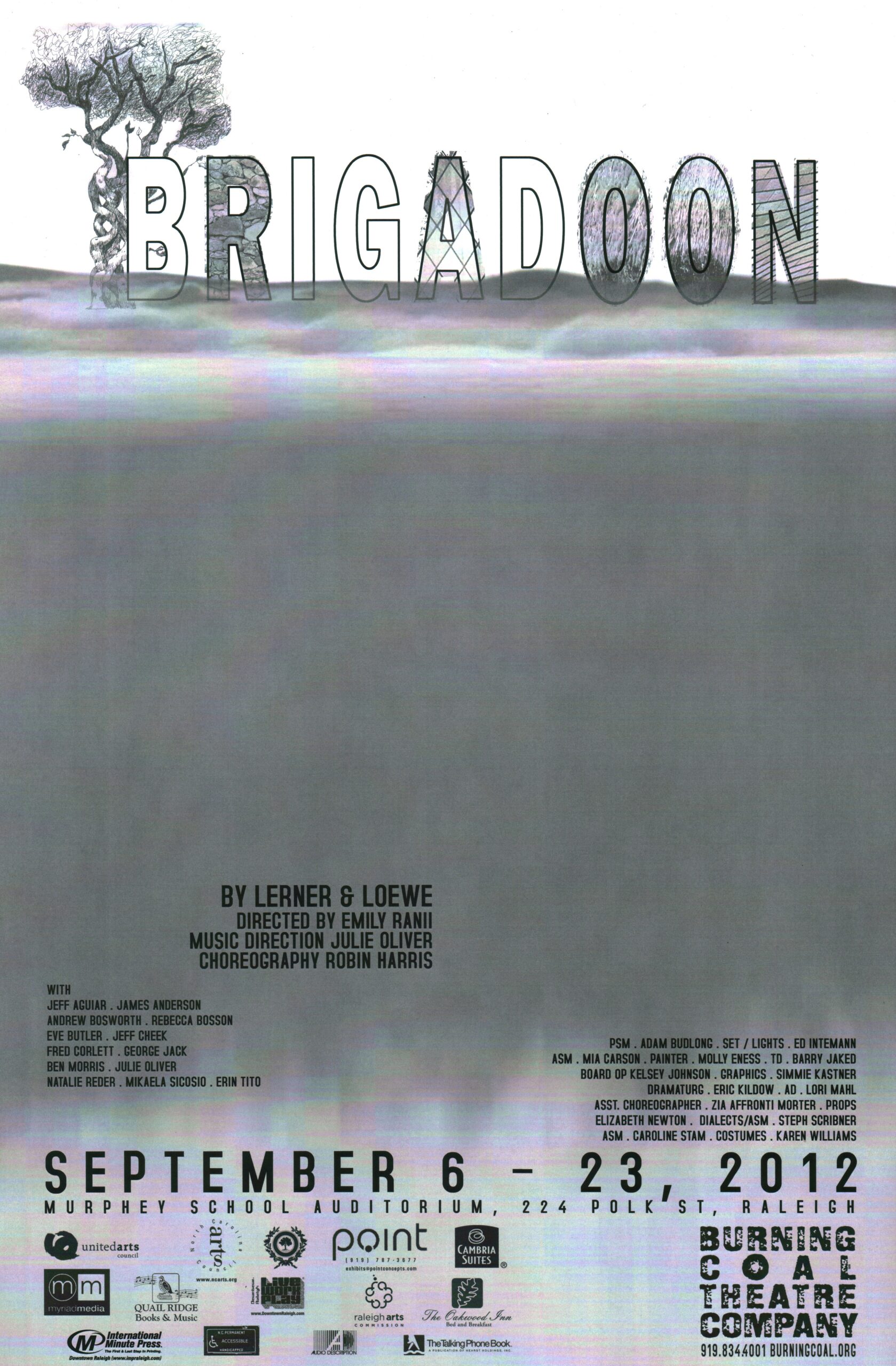
Brigadoon by Lerner and Loewe
Dir. Emily Ranii
Dates: September 6-23 2012
Location: Murphey School
Shining City
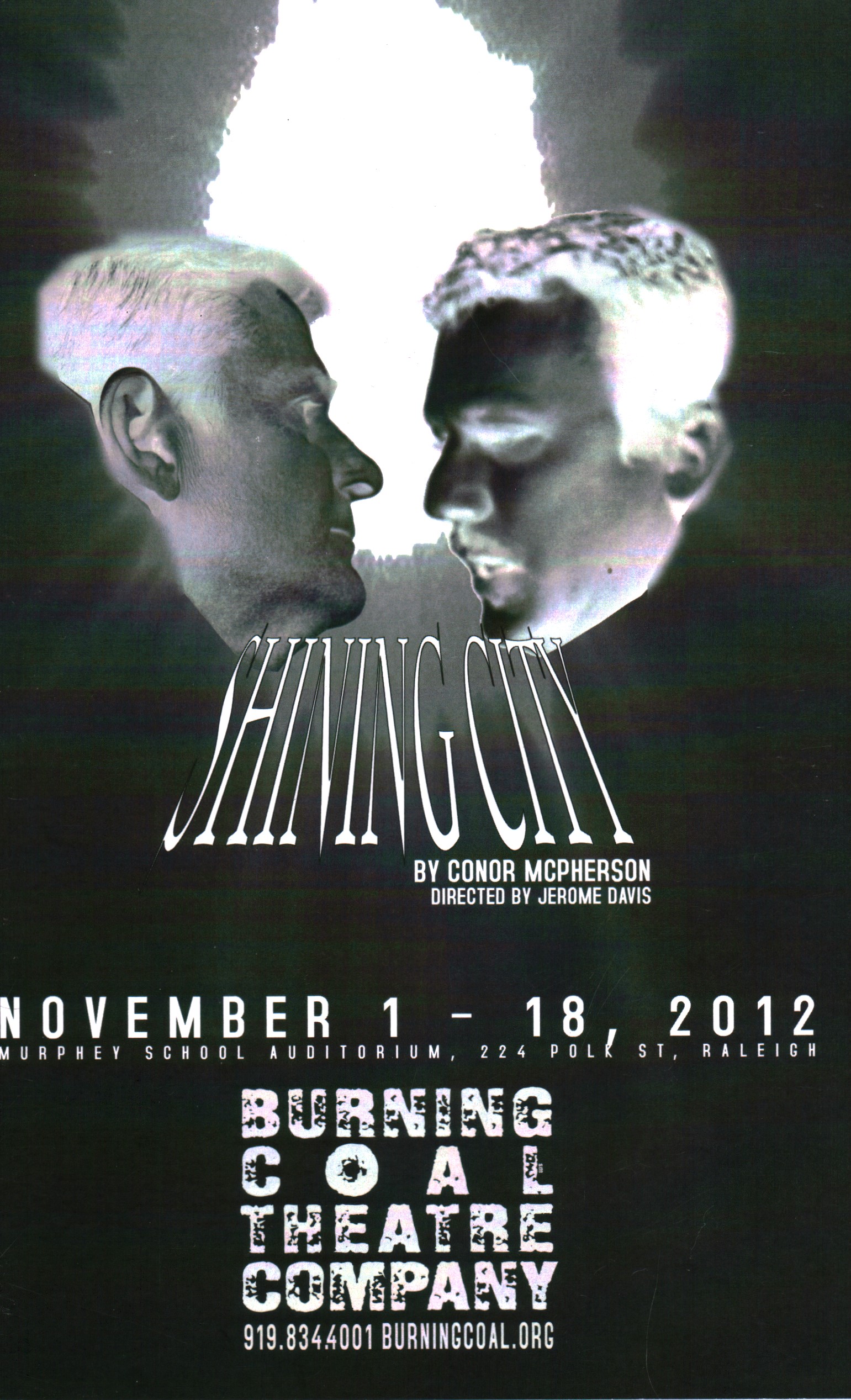
Shining City by Conor McPherson
Dir. Jerome Davis
Dates: November 1 -18 2012
Location: Murphey School
As You Like It
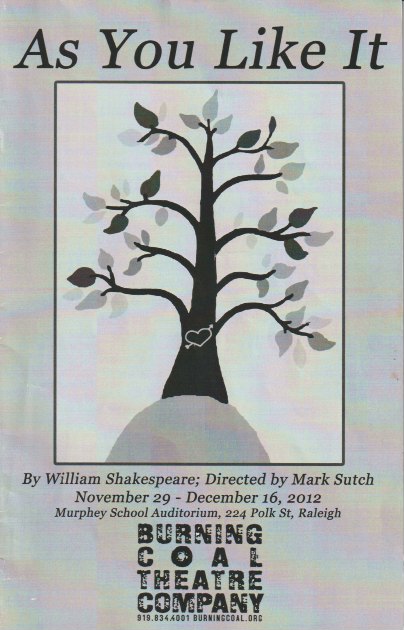
As You Like It by William Shakespeare
Dir. Mark Sutch
Dates: November 29-December 16, 2012
Location: Murphey School
Good
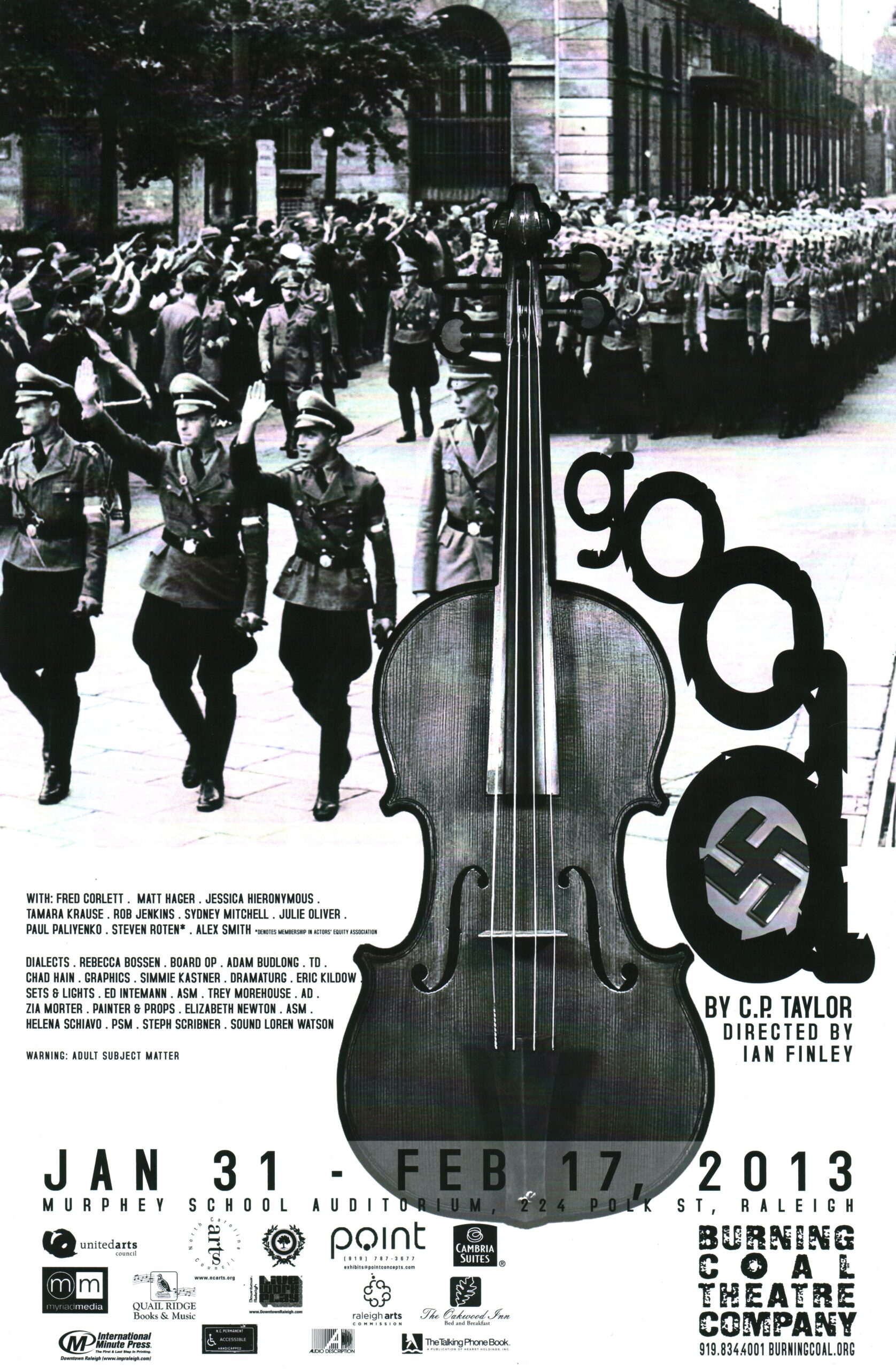
Good by C.P. Taylor
Dir. Ian Finley
Dates: January 31-February 17 2013
Location: Murphey School
Ruined
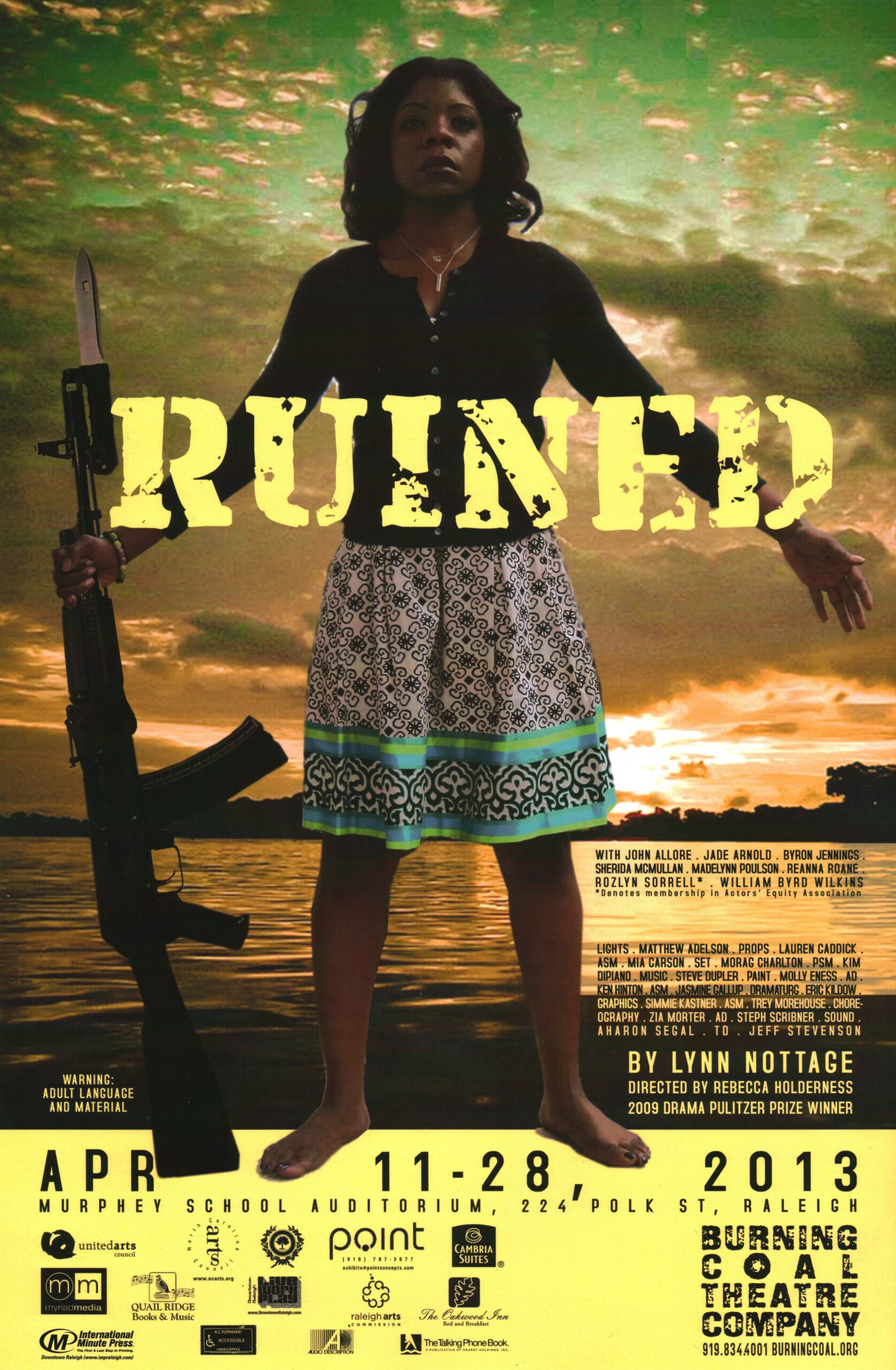
Ruined by Lynn Nottage
Dir. Rebecca Holderness
Dates: April 11-28 2013
Location: Murphey School
Brigadoon
Brigadoon by Lerner and Loewe
Dir. Emily Ranii
Dates: September 6-23 2012
Location: Murphey School
Artistic Director’s Notes:
Brigadoon is a simple story about a place that isn’t on any map. It is only an idyllic place in that it appears to human beings infrequently. To be a citizen of this town, a certain level of selflessness is required. In order to live there, you have to fully commit to the place and its people. You can’t stand outside, looking in. If you do, you’ll miss it. It’s a place where simple people live and love and work and die. The tragic thing about the town is that its simple beauty is only revealed infrequently. And that is a loss for the rest of the world. If that beauty, so simple and common, were able to be appreciated daily by the rest of the world … well, that would be a good thing.
In the early 1980s, as exhaustively detailed, among other places, in Randy Shilts’ gut-wrenching book And the Band Played On… a strange new disease began to fell strong young men in cities and towns across the world, with large swaths of the population in New York, Chicago and San Francisco being particularly hard hit. By the time it had been identified, far, far too many were dead. The toll was exacerbated by greed. Organized Crime members literally put guns to the heads of health inspectors in all three cities and informed them that if they wanted to continue living, they would leave open the bath-houses, which were at that time acting as Petri dishes for the disease, no matter how high the death toll climbed. The American Red Cross waited more than a year after it knew that its supply was tainted to let the public know. A leading doctor at the CDC fought tooth and nail to keep a French doctor’s vaccine out of the U.S., so that his later arriving vaccine could be documented, historically, as the first. In each case, greed was the determining factor in these behaviors. Simple, common, everyday greed. And one full generation of artists, along with many, many others, was wiped from the face of the earth. If the epidemic had occurred a few decades earlier, we might have lost Stephen Sondheim, Andy Warhol, Truman Capote, not to mention Mick & Keith. Two generations back, Noel Coward, James Baldwin, Sir Laurence Olivier and Allen Ginsberg . Go back three generations and imagine the loss of Oscar Wilde, Federico Garcia Lorca, E.M. Forster and A.E. Housman. If the 1980s had been the 1580s, would young William Shakespeare have survived? Who did we lose with the AIDS epidemic? We don’t know entirely. And we never will. What is the value of that lose, and who can the generations to come, missing perhaps another William Shakespeare, turn to for recompense? Greed is not good, no matter what Hollywood tells you, or Wall Street, or the nightly news, or any of the dictators locked in a pitched battle to keep their minorities, their agitators and their artists under wraps so that they can go about the business of further enriching their elites. No matter how common, how human, how everyday. Greed is not good, no matter what the religious leaders say as they spin their vision of ‘goodness’ that coincidentally looks just like them. Greed is not good, no matter what the “if it bleeds, it leads” press tells you, or the colleges who make way for ‘special’ students who play a child’s game very well but otherwise have no commitment to the hard work that a serious education requires.
Brigadoon is about greed. It is about people who are so awash in the glow of material success that they can’t even feel their own heart’s cry. And, too, in the fanciful way that art has of digging into the muck and finding the unwashed gem, it is about that equally human thing: love, and its ability to clasp that faintly glowing gem, strip it up out of the mire, and hold it up to the sun. It doesn’t happen often, but when it does, it is a story worth telling today.
Welcome to Burning Coal’s 16th season!
-Jerome Davis/Artistic Director
Crew:
Music Director: Julie Oliver
Choreography: Robin Harris
Stage Manager: Adam Budlong
Set/Light Design: Ed Intemann
Asst. Stage Manager: Mia Carson, Caroline Stam
Painter – Molly Eness
Technical Director: Barry Jaked
Board Operator: Kelsey Johnson
Graphics Design: Simmie Kastner
Dramaturg Eric Kildow
Asst. Director: Lori Mahl
Asst. Choreographer: Zia Affronti Morter
Props: Elizabeth Newton
Dialects/Asst. Stage Manager: Steph Scribner
Costumes: Karen Williams
Cast:
Jeff Aguiar – Charlie Dalrymple
James Anderson – Jeff Douglas
Rebecca Bossen – Jane/Kate
Andrew Bosworth – Tommy Albright
Eve Butler – Maggie Andereson
Jeff Cheek – Angus MacGuffie/Frank
Fred Corlett – Archie Beaton
George Jack – Andrew MacLaren
Ben Morris – Harry Beaton
Julie Oliver – Mrs. Lundie
Natalie Reder – Fiona MacLaren
Mikaela Saccoccio – Jean MacLaren
Erin Tito -Meg Brockie
Orchestra:
Greg Dixon, Brain Farias, Hana Jenkins, Diane Petteway

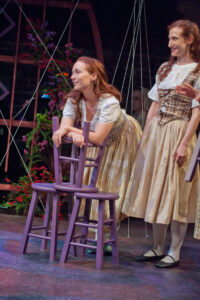
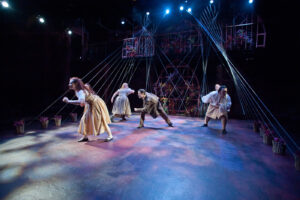
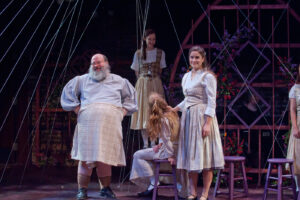
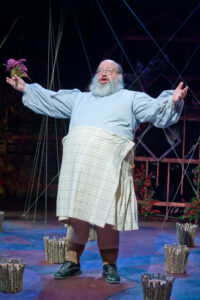

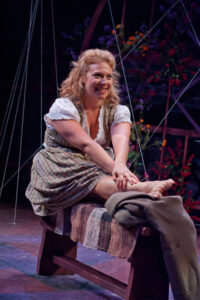


Have a fond or interesting memory of this play you’d like to share with us? We’d love to hear it!
Please Contact Us to Share!
Burning Coal Theatre
(919) 834-4001
224 Polk St., Raleigh NC 27604
Played September 6-23 2012: Brigadoon
Shining City
Shining City by Conor McPherson
Dir. Jerome Davis
Dates: November 1 -18 2012
Location: Murphey School
Artistic Director’s Notes:
Shining City marks the fifth go-round I’ve had with this red-headed-pug-Irishman named Conor McPherson. I think I can claim a draw, to date, which ain’t bad considerin’ how tricky this guy is. You see, though we’ve tussled four bouts in the last decade…I’ve never met the man! Hard to land a blow under them circumstances, but I keep swingin’ away. Though I’ve never met him, he continues to get under my skin. Every time I pick up one of his plays and start reading it, he draws me in. And then…wham! He knocks me for a loop! Why, oh why, do I keep allowing myself to get drawn in by this guy?!
It began with The Weir. I’d heard a lot of hoopla about this McPherson fella’s little five hander when it played in London at the Royal Court Upstairs–-a real dive–tiny little no frills lace. I’d even begun to see his mug in the papers. I didn’t think much of it. The British are good at all that sound and fury, signifying nothing bunk. Then the lightweight play making such a stink in London got on a boat and sailed to the U.S., where it had crowds on their feet…On Broadway, no less. Upstart. These were the boards reserved for true American heavyweights: Moss Hart, Kid Soundheim, Lerner and his pal, Loewe. Riche Rodgers & Hammerin’ Hammerstein, for heaven’s sake. Not some young punk from Dublin! It was, in hindsight, at that point that he had me. Hindsight being, of course, 20/20. Little did I know, as I chucked out a hard earned American sawbucks, that I was about to be sucker punched, and in a BIG way. Sure enough, as I sat in the lap of luxury at the posh midtown address, I let my guard down.
Two hours later, I staggered out of the ring…er…the theater with the emotional equivalent of two black eyes and a cauliflower ear. McPherson by TKO. I wasn’t sure what I’d seen, but I was sure it had floored me. I knew I had to take that play on at Burning Coal! That simple story of a small-town group of Irish geezer blowhards who, when faced with the presence of new blood, a beautiful young woman fro the city who hadn’t yet heard all their creepy tales 93 times already, responded…as all red-blooded male persons will,with the telling of those very tales again. In a typical “ghost story” form, though, it is the most innocent of the lot who has the most harrowing “ghost story” to tell–and when the young woman told it, you coulda heard a pin drop. At that point I was certain McPherson was a true heavyweight, But he wasn’t done. The Weir ends, you see, with a final “ghost story,” one told by the oldest and most cynical old coot in the room. And it involves nary a ghost. Yet, it froze the blood. Frozen with the recognition of human fragility–all too real, all too recognizable. ALL too me. He had me. Pound for pound, the finest playwright around!
After that, we took on the one-man show St. Nicholas, then The Seafarer, about the poor sod who finds himself across the poker table one Christmas Eve from Beelzebub hisself. A second crack at St. Nicholas ten years after, and now, Shining City. I must be some kinda masochist for daring to step into the ring again. And for those of you who think this one will be over fast–I hope you have your protective headgear on.
Jerome Davis
Crew:
Stage Manage: Kim DiPiano
Technical Direction: Barry Jaked
Scenery Design: C. Murdock Lucas
Lighting Design: Matthew Adelson
Costume Design: Alyssa Breeden
Props: Timothy Domack
Sound Design: Loren Watson
Asst. Director: Trey Morehouse
Dramaturg: Eric Kildow
Graphics Design: Simmie Kastner
Asst. Stage Manager: Elizabeth Newton, Helena Schiavo, Steph Scribner
Stage Crew: Maegan mercer-Bourne
Dialects Coach: Steph Scribner
Scenic Artist: Molly Eness
Board Operator: Zia Affronti Morter
Cast:
John Allore – John
James Anderson – Ian
Laura Tratnik – Neasa
Nic Carter -Laurence
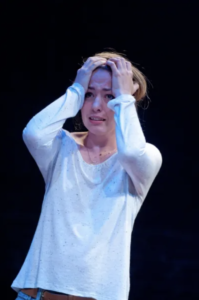
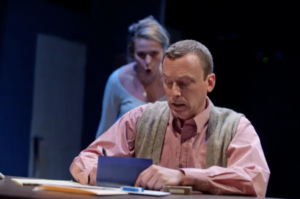
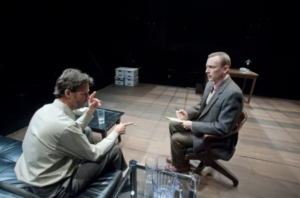
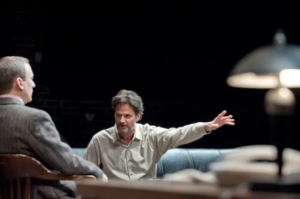
Have a fond or interesting memory of this play you’d like to share with us? We’d love to hear it!
Please Contact Us to Share!
Burning Coal Theatre
(919) 834-4001
224 Polk St., Raleigh NC 27604
Played November 1-18: Shining City
As You Like It
As You Like It by William Shakespeare
Dir. Mark Sutch
Dates: November 29-December 16, 2012
Location: Murphey School
Artistic Director’s Notes:
All the world’s a stage.
And all the men and women merely players:
They have their exits and their entrances;
And one man in his time plays many parts
Shakespeare wrote that. Four hundred years later, we read it and marvel. The metaphor is simple, but profoundly accurate, One man in his time plays many parts. Those parts are determined, to a large degree, by our interactions with others. If we cloistered ourselves away, ignoring the sun and other people, we would find ourselves turning pale, inwardly and outwardly. It is only when we connect with others that our role changes, that we take on other responsibilities in order to meet the needs of those other people who have made “their entrance” into our lives. In acting class, we talk about dividing the scene into “beats.” eats most often begin when someone enters of exits, the “objective” of the scene is said to change. Hamlet’s objective changes in the bedroom scene with Gertrude when he realizes Polonius is hiding behind the arras. Polonoius’ ‘entrance’ (though not strictly a physical entrance) into the scene causes Hamlet to behave differently, to act differently, to pursue a different goal. It also colors his attitude toward Gertrude from that moment forward.
It is no coincidence that Shakespeare wrote for the Elizabethan stage, that glorious “wooden O” that allowed the audience to look at the actors, to hear the actors…and to look through the actors at themselves. It was a thrust stage…a microscope and a mirror. The Greek amphitheatres many centuries before were also thrusts .Their stage was surrounded on three sides by the audience. Only in modern times with the advent of electricity and its immediate predecessors have we insisted on sequestering our audiences in the dark, alone, unaware of one another as we watch live performance. With the advent of movies, the essential three dimensionality of the thrust stage was further subdued with the flattening into two dimensions of the performers. Televisions, computers, Ipads, all conspire to flatten that image and to ignore a critical factor of live performance: the spatial relationship between the actor and the audience. Each of us have our entrances, but if those entrances never impact our fellow ‘players,’ then what chance have we to find the ‘part’ that is our true calling? If live performance is to survive the tidal wave of technology that is, even now, training generations to perceive life in two dimensions, we must survive by emphasizing that very human need to connect. All the world, after all, is a stage.
Crew:
Stage Manager: Beth Gardiner
Technical Director: Barry Jaked
Scenery Design: Natalie Taylor Hart
Lighting Design: Christopher Popowich
Costume Design: Jane Alois Stein
Props: Elizabeth Newton
Asst. Director: Trey morehouse
Dramaturg: Marshall Botvinick
Graphics Design: Steph Scribner
Asst. Stage Manager: Mia Carson, Tanner Norris, Courtney Pisano
Scenic Artist: Elizabeth Newton
Board Operator: Mia Carson
Cast:
Jeff Aguiar – Oliver, Sylvius, Corin, Hymen
John Allore – Adam, Touchstone, Jaques
Jade Arnold – Orlando, Charles, William
Rebecca Bossen – Rosalind, Amiens, Dennis
Lori Mahl – Celia, Phebe
Tom McCleister – Duke Frederick, Mar-Text, Duke Senior
Steph Scribner – Le Beau, Audrey, First Lord, Jaques De Boys
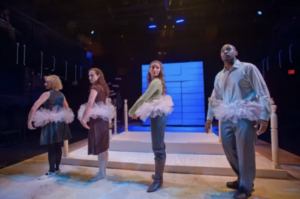
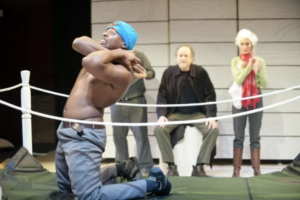
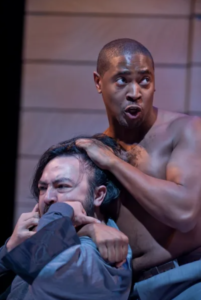

Have a fond or interesting memory of this play you’d like to share with us? We’d love to hear it!
Please Contact Us to Share!
Burning Coal Theatre
(919) 834-4001
224 Polk St., Raleigh NC 27604
Played November 29-December 16, 2012 : As You Like It
Good
Good by C.P. Taylor
Dir. Ian Finley
Dates: January 31-February 17 2013
Location: Murphey School
Artistic Director’s Notes:
The Holocaust happened a long time ago, and in a faraway, almost quaint-seeming world. One of the problems with the accelerating pace of our increasingly generic world culture is that human capacity for evil can seem to be eradicated as our tastes in clothing, patterns of speech and up- to-the-minute technology are obliterated by ‘the next wave.’ But human behavior isn’t as quick to change as are our hairstyles. Europe, the self-proclaimed most ‘cultured’ of human outposts, was the location of this horrific set of choices conceived of, planned and implemented by people who lived during the time that most of our parents, or certainly grandparents lived. And today, events through Europe and elsewhere suggest that while progress has been made, there are still members within the human family who cannot help but seek the easy answer of racial, ethical, religious or gender-based scapegoating as answer to complex questions. The continent of Africa is currently comprised of a series of failed states seething with an incendiary mix of religious fundamentalism, corrupt dictators and economic turmoil created by a mixture of untenable terrain and climate, centuries of colonialist ‘good intentions’ and personal ineptitude. In the Asian real, the generations-long fight to replace colonialism with communism has brought that part of the world to a semblance of economic might, but at the expense, apparently, of many of the human decencies that were ostensibly at the core of that original struggle, not to mention the crass pillaging of their environment…and of course, ours. Central and South America are making economic progress, but still find large populations eager to flee to the greener pastures to their north and fertile ground for drug gangs and other hoodlums who would rather pollute their countrymen and corrupt their government than do an honest day’s work. In the U.S., a pair of political parties perch like leering gargoyles at one another, their sinister gazes set in stone, their ability to act as limited as those grotesque architectural features from a previous dark ages.
All of this leads me to ask the question: how much progress have we made, as a species? Every day in political actions large and small we see men and women taking the Halder stance: “I can do better working within the system than without.” If that was so demonstrably not true in 1939, is it really any more true today? And if it isn’t true today, then how does one distinguish between the passionate radical –standing apart from the mainstream–and the foggy-minded zealot, sitting like a Pol Pot, Idi Amin or Joseph Stalin, waiting for their chance to lead people astray?
I don’t know what the answer to that question is, but I’m fairly certain it has something to do with getting the facts straight, which means knowing the facts, which means educating yourself. Even so, Halder (or certainly his real-life-counterpart) was an educated man. So was Pol Pot, for that matter (at the Sorbonne, no less). There clearly has to be more to the equation. Art has long been the answer from the vantage point of this lifer in the arts, yet Europe, the same Europe that showered hundreds of thousands of boys with mustard gas and shrapnel less than a century ago, is replete with art. And too, the innumerable church spires of Europe suggest that organized religion may not provide the ultimate answer, either. Where did we go wrong in 1939 and in the following years. What could we have done to limit the misery experienced by 6 million Jews and their families, friends, neighbors, descendants (not to mention the homosexuals, artists, clergy and physically and mentally disabled who were targeted by the Nazis). How did we fail them then> And how much better will we do the next time?
Jerome Davis
Crew:
Stage Manager: Steph Scirbner
Technical Director: Chad Hain
Scenery Design: ED Intemann
Lighting Design: ED Intemann
Costume Design: Maria Juri
Props: Elizabeth Newton
Sound Design: Loren Watson
Asst. Director: Zia Affronti Morter
Dramaturg: Eric Kildow
Graphics Design: Simmie Kastner
Dialects Coach: Rebecca Bossen
Asst. Stage Manager: Mia Carson, Trey Morehouse, Hellena Schiavo
Scenic Artist: Meredith Riggan
Master Electrician: Barry Jaked
Board Operator: Adam Budlong
Cast:
Fred Corlett – Eichmann, Bouller
Matthew Hager – Bok/Dispatch Rider
Jessica Heironimus – Anne
Rob Jenkins – Maurice
Tamara Farias Krasu – Helen
Sydney Mitchell – Sister/Wife
Julie Oliver – Mother
Paul Paliyenko – Hitler/Doctor
Alex Smith – Freddie
Steven Roten – Halder
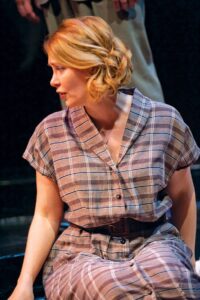

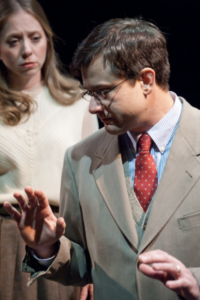
Have a fond or interesting memory of this play you’d like to share with us? We’d love to hear it!
Please Contact Us to Share!
Burning Coal Theatre
(919) 834-4001
224 Polk St., Raleigh NC 27604
Played January 31-February 17 2013: Good
Ruined
Ruined by Lynn Nottage
Dir. Rebecca Holderness
Dates: April 11-28 2013
Location: Murphey School
Crew:
Stage Manager: Kim DiPiano
Technical Director: Jeff Stevenson
Scenery Design & Portraits: Morag Charlton
Lighting Design: Matthew Adelson
Costume Design” Katrina Blose
Props: Lauren Caddick
Sound Design: Aharon Segal
Choreography: Zia Aharon Segal
Music Composer: jonathan Fitts
Fight Choreographer: David McClutchy
Asst. Director: Steph Scribner
Dramaturg: Eric Kildow
Graphics Design: Simmie Kastner
Dialects Coach: Rebecca Bossen
Asst. Stage Manager: Mia Carson, Trey Morehouse, Zia Affronti Morter
Scene Painter: molly Eness
Master Electrician: Barry Jaked
Board Operator: Mia Carson
Cast:
John Allore – Mr. Harari
Nic Carter – Musician
Delpho Curtis – Simon/Soldier
Corwin Evans – Laurent/Soldier/Miner
Gil Faison – Fortune/Miner
Savada Gilmore – Kisembe
Byron Jennings – Christian
Sherida McMullan – Josephine
Madelynn Poulson – Salima
Reanna Roane – Sophie
Rozlyn Sorrell – Mama Nadi
Byrd Wilkins – Commander Osembenga

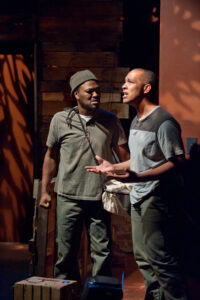
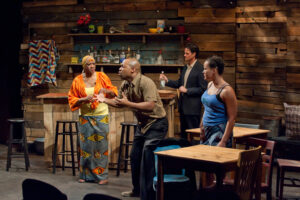
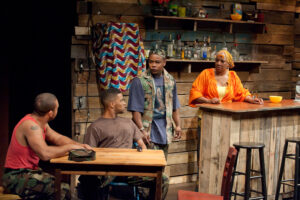


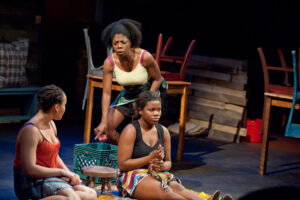
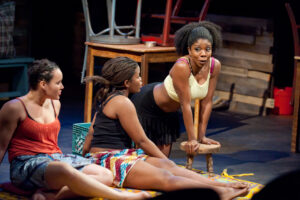

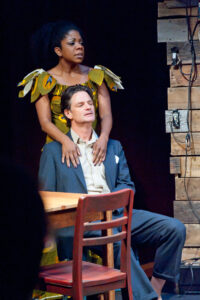
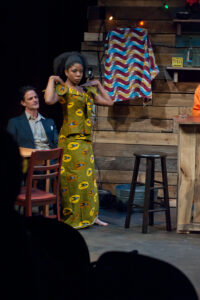

Have a fond or interesting memory of this play you’d like to share with us? We’d love to hear it!
Please Contact Us to Share!
Burning Coal Theatre
(919) 834-4001
224 Polk St., Raleigh NC 27604
Played April 11-28 2013: Ruined
Season 17: (2013-2014)
The Heretic
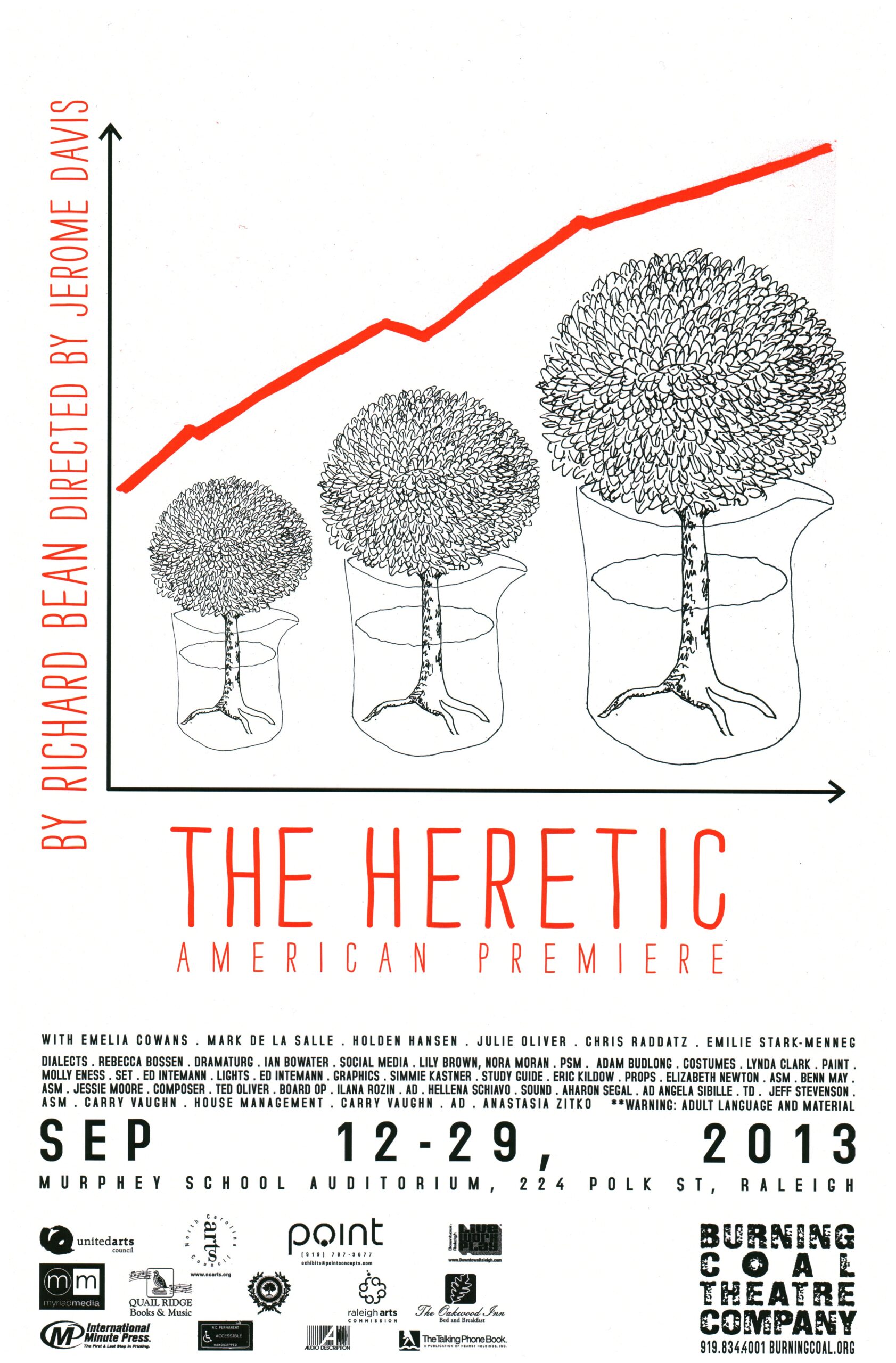
The Heretic by Richard Bean
Dir. Jerome Davis
Dates: September 12-29, 2013
Location: Murphey School
(Three Man) Tempest
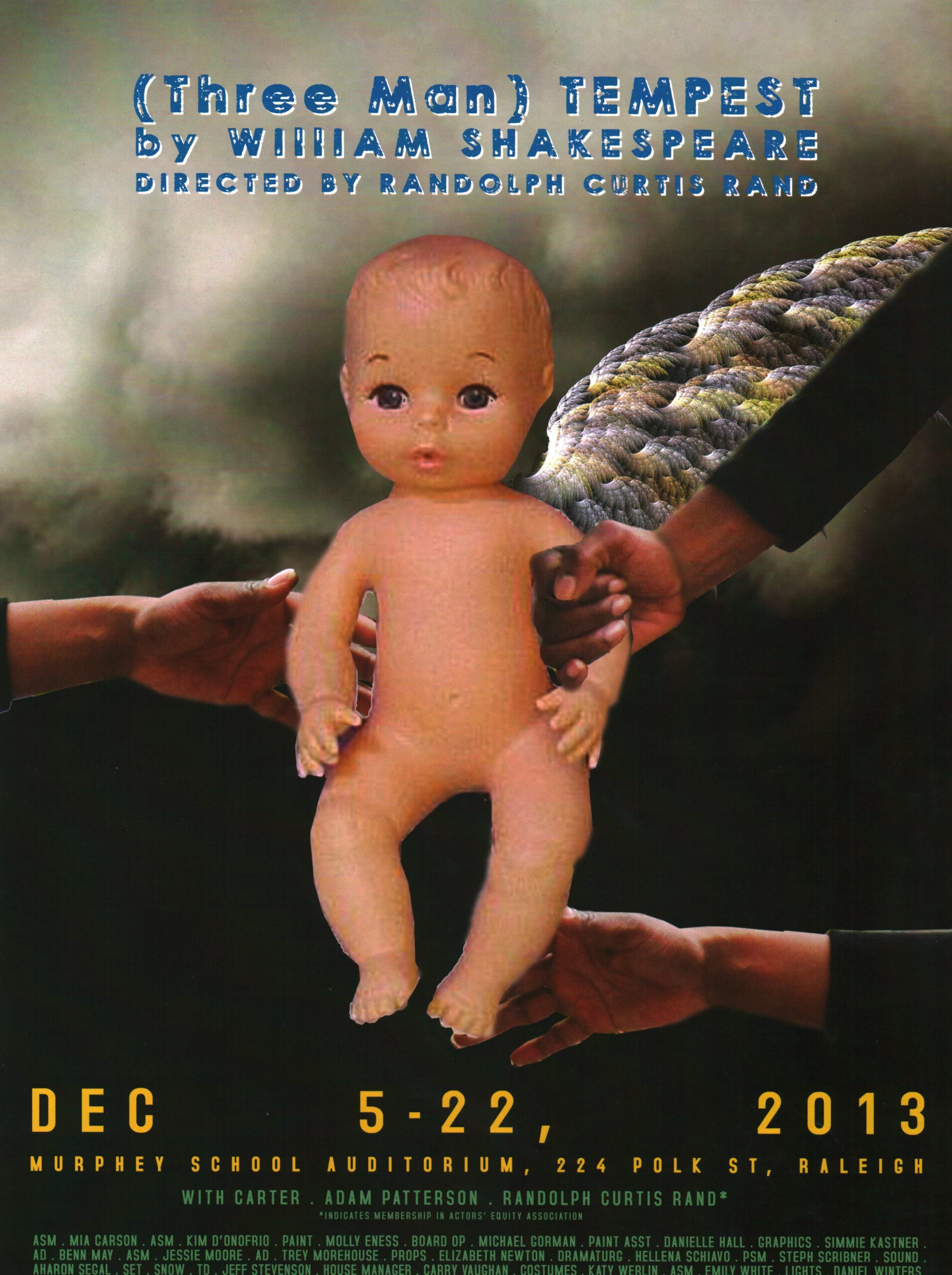
(Three Man) Tempest by William Shakespeare, Adapted by Randolph Curtis Rand
Dir. Randolph Curtis Randy
Dates: December 5-22, 2013
Location: Murphey School
The Jesus Fund
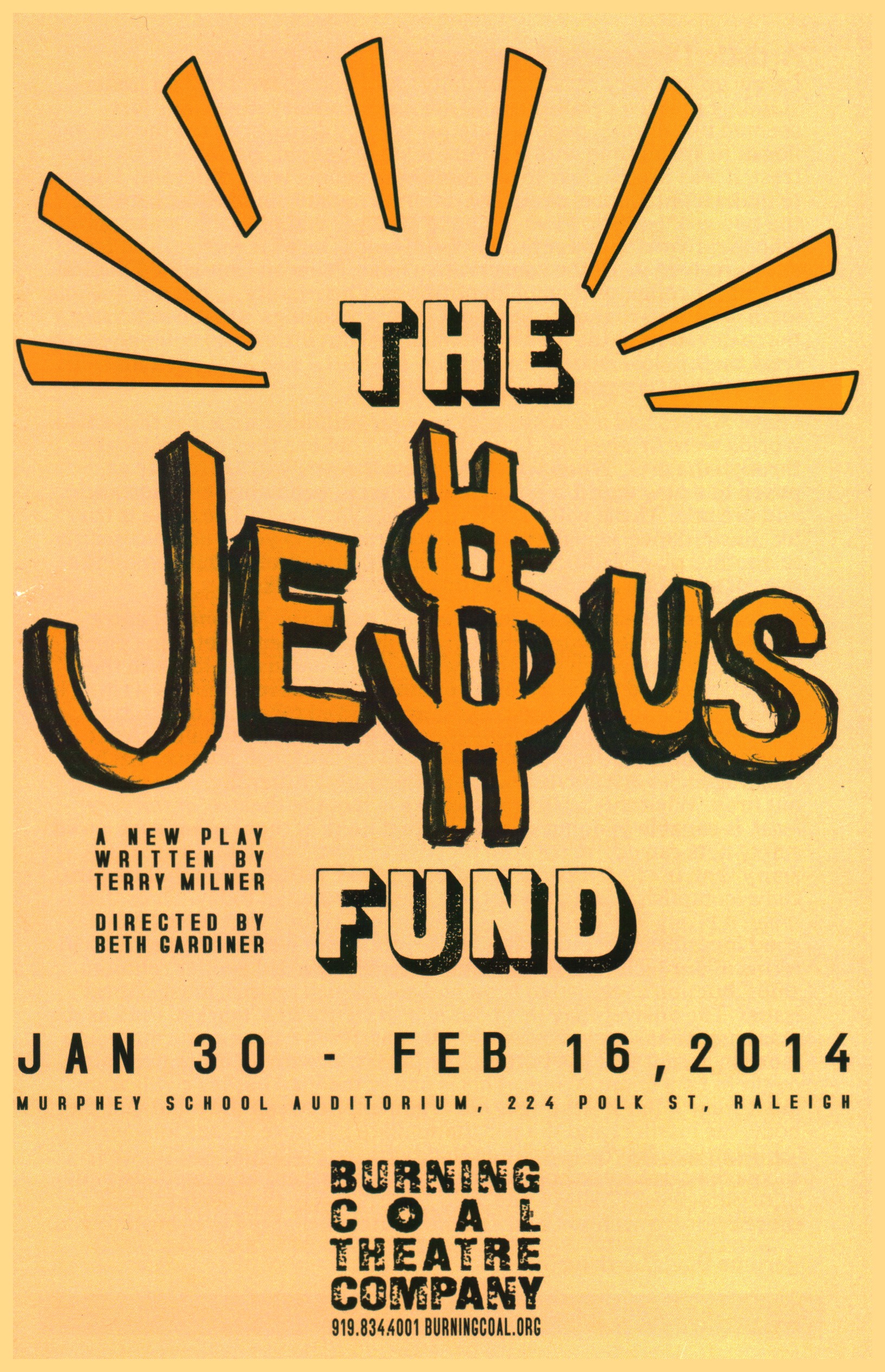
The Jesus Fund by Terry Milner
Dir. Beth Gardiner
Dates: January 30-February 16 2014
Location: Murphey School
The Road to Mecca
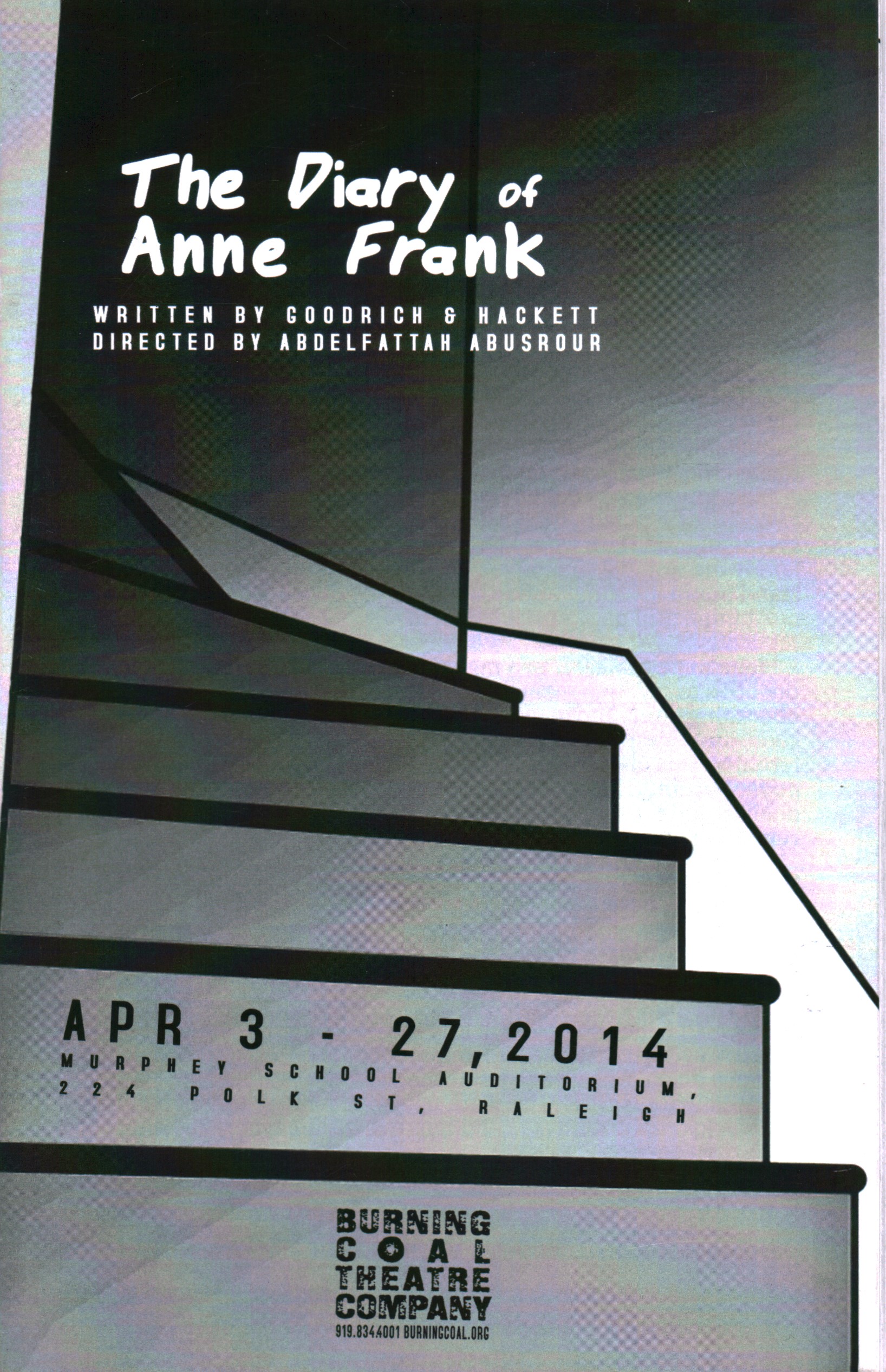
The Diary of Anne Frank by Goodrich and Hackett
Dir. Abdelfattah Abusrour
Dates: April 3-27, 2014
Location: Murphey School
The Heretic
The Heretic by Richard Bean
Dir. Jerome Davis
Dates: September 12-29 2013
Location: Murphey School
Artistic Director’s Notes:
I do love The Heretic and am so excited to be bringing you its US premiere. Richard Bean is a bit of a contrarian. He believes that the arts have been calcified into a world-view that is activist rather than scientific in its approach. He believes that the greatest value of art is when it asks its audience to consider alternative points, not when it solemnly preaches to the choir, asking for hosannas on issues long since settled in the minds of most of that audience.
When an artist, through his or her work, is willing to give voice to all or a variety of points of view, then that art is useful to its audience. Politicians and salespersons have a vested interest in telling one side of the story. The press has to some degree always had a bottom line mentality that created such touching axioms as “If it bleeds, it leads!” That doesn’t mean there aren’t many politicians and journalists who, from moment to moment, stand up and speak truth to power at great personal risk. But the systems in which both operate are rigged against them in many respects. Artists, on the other hand have, as their raison d’être, a dispassionate consideration of many points of view. Anything else is agitprop or crass commerce. From Moliere’s indictment of the clergy in Tartuffe to Pussy Riot, from Vaclav Havel’s Velvet Revolution to The Dixie Chicks, from Athol Fugard’s Market Street Theatre in Johannesburg to country troubadour Steve Earle and his raucous dissection of freedom American-style in the scalding “F the CC”…some artists have taken seriously their position as the last line of defense against mendacity. Though bold, loud and sometimes emotional, few of those artists would have found themselves in trouble were they not talking facts. I don’t think those facts are best discussed in the form of rigid hysterical, “us against them” discourse. That discussion, that art, must come in the form of a serious consideration of the facts.
I wonder, for instance, why doubtful, perhaps even unconstitutional acts on the part of our government are not forcefully and systematically being challenged? Mssrs. Snowden, Manning and the Wikileaks bunch aren’t exactly Woodward & Bernstein in terms of their credentials. None have held elected office. None are experienced journalists. And none, perhaps most conspicuously, are artists. And yet, sadly, they are all we have. No one else is taking on that responsibility. Are artists, along with journalists and politicians, looking the other way today, when a select few of the issues held in esteem by them are being given favorable lip-service by our national leaders? That cas could be argued. Richard Bean wouldn’t, I expect, think very much of that idea. Enjoy The Heretic. I am very pleased to be presenting this American Premiere to you tonight. And join us after for the nightly talkback with members of the cast.
Jerome Davis
Crew:
Stage Manager: Adam Budlong
Technical Director: Jeff Stevenson
Scenery & Lighting Design: ED Intemann
Costume Design: Lynda Clark
Props: Elizabeth Newton
Sound Design: Aharon Segal
Music Composer: Ted Oliver
Asst. Director: Hellena Schiavo, Anastasia Zitko
Study Guides: Eric Kildow
Graphics Design: Simmie Kastner
Dialects Coach: Rebecca Bossen
House Manager and Asst. Stage Manager: Carry Vaughn
Asst. Stage Manager: Benn May and Jessie Moore
Scene Painter: Molly Eness
Asst. Scene Painter: Danielle Hall
Master Electrician: Barry Jaked
Board Operator: Ilana Rozin
Carpenter: Greg Gunther
Cast:
Emilie Blum – Phoebe Cassell
Emelia Cowasn – Ms. Tickell
Mark de la Salle – Geoff Tordoff
Holden Hansen – Professor Kevin Maloney
Julie Oliver – Dr. Diane Cassell
Chris Raddatz – Ben Shotter

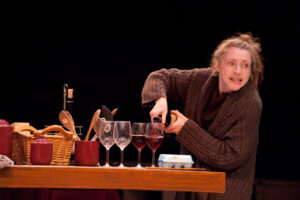
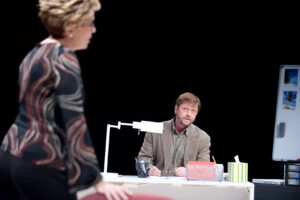


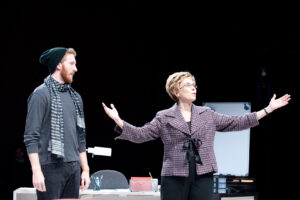
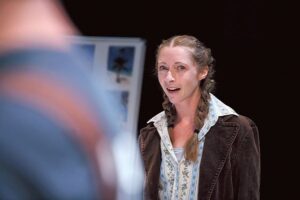

Have a fond or interesting memory of this play you’d like to share with us? We’d love to hear it!
Please Contact Us to Share!
Burning Coal Theatre
(919) 834-4001
224 Polk St., Raleigh NC 27604
Played September 12-29 2013: The Heretic
(3 Man) Tempest
(Three Man) Tempest by William Shakespeare, Adapted by Randolph Curtis Rand
Dir. Randolph Curtis Randy
Dates: December 5-22, 2013
Location: Murphey School
Artistic Director’s Notes:
I met Randolph Curtis Rand while working on a production of The Tempest at Columbia University in the early 90s. The director, Rebecca Holderness who I had known since my early days in Tennessee, was staging it in the apse of a small cathedral on the school’s campus. The cast included (now) Broadway stalwarts Jennifer Regan and Jeremy Shaos, Big Dance Theatre Founder Molly Hickok, an assistant stage manager named Diane Paulus (Google her!) and scenery/costumes designer Vicki Davis, now at the NC School of the Arts. The MFA directing program at Columbia was just starting up. The department head was Andre Serban. The head of directing was Anne Bogart. The head of playwriting was North Carolina native Romulus Linney. In my little world, this was a pivotal moment, a turning point in my life. Of course, I didn’t know that, nor, I imagine, did any of us. I did know that the response of my friends who came to see the production was unlike any I had experienced in the past: “Life changing!,” “The best Shakespeare I’ve ever seen!”, etc. In this business, you learn to take such things with a grain of salt. But months and months later, when people kept talking, I began to suspect that there had been some rough magic in the air.
I have my own feelings about The Tempest … what it means for us today, what Shakespeare meant. Much has been made of the time in which it was written…just as the word of the exotic New World was filtering back to England and the “civilized world.” In the play, a haughty Duke, Prospero, is deposed by some unscrupulous politicians, including his own brother, and banished, along with his virginal daughter, Miranda. They end up in an exotic land inhabited by strange creatures of earth (Caliban) and air (Ariel). The only things he brings with him are his books. Using his “magic,” Prospero is able to conquer the inhabitants of the island and remake for himself a kind of kingdom where he spends his time in the company of his daughter and his subjects, none of whom are too happy to be under his control. After years in this condition, Prospero’s usurping friends, including his brother Antonio, are shipwrecked on the island. Prospero is now faced with the opportunity to seek final revenge upon them…or…to forgive them.
The political is very much at the forefront of The Tempest, as is the relationship if any!) between the intellectual and the ethical. Fathers and daughters come into it, as well. In short, it covers a lot of ground. In each case, the question of forgiveness is raised. Is it possible for human beings to make such a choice? If so, can it be received by the victim? And finally, once forgiveness has been achieved, how then to proceed? In The Tempest, we see that the beginning of any solution involves the parties being “shipwrecked” together (i.e., put into the same room). Shakespeare, as is often the case, seems to have written a play for us, for here, for today. Maybe his genius was in asking questions so central to the human character that they will forever seem timely. Maybe we put ourselves into the roles and situations of Shakespeare out of a need to believe that it is possible for a single man to be speaking us from across the centuries (for that would surely mean that we ourselves have a chance at immortality). Perhaps he was a visionary, who foresaw in the settling of the New World the kinds of problems that, with hindsight certainly seem inevitable.
Whatever the case, we turn to him, again and again for guidance. And often, we find him there, at the turning points in our lives.
Crew:
Stage Manager: Steph Scribner
Technical Direction: Jeff Stevenson
Scenery: Snow
Lighting Design: Daniel Winters
Costume Design: Katy Werlin
Props: Elizabeth Newton
Sound Design: Aharon Segal
Asst. Director: Benn May, Trey Morehouse
Dramaturg: Hellena Schiavo
Study Guides: Eric Kildow
Graphics Design: Simmie Kastner
House Manager: Carry Vaughn
Asst. Stage Manager: Mia Carson, Gretchen Struckmeyer, Emily Rose White
Touring ASM: Fred Corlett
Scene Painter: Danielle Hall
Master Electrician: Barry Jaked
Board Operator: Michael Gorman
Cast:
Carter – Caliban and others
Adam Patterson – Miranda and others
Randolph Curtis Rand – Prospero and others

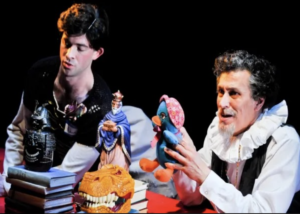

Have a fond or interesting memory of this play you’d like to share with us? We’d love to hear it!
Please Contact Us to Share!
Burning Coal Theatre
(919) 834-4001
224 Polk St., Raleigh NC 27604
Played December 5-22 2013: (3 Man) Tempest
The Jesus Fund
The Jesus Fund by Terry Milner
Dir. Beth Gardiner
Dates: January 30-February 16 2014
Location: Murphey School
Artistic Director’s Notes:
I grew up in a very rural community. As a youngster, I had no understanding that the people around me were ‘conservative,’ they just seemed like normal people. Into my teens, I discovered the theatre and began to spend time with a different set of people. Because of the contrast, it was pretty clear to me that these people were different. I began to make mental notes about the differences, and similarities between the two groups. What I am going to say now will probably make people who identify with either group quite angry, but it is the truth, at least as I perceived it. Of the conservative folks. I saw an iron-willed dedication to the religious dogma identified as ‘Christianity’…but not a whole lot of attention to the meaning of Christ’s teachings. On the left, I saw a fierce devotion to the idea of ‘Humanism’, but little or no willingness to treat their fellow citizens humanely. In short, I saw a lot of similarities between the two groups.
I have always had a fanciful, maybe even grandiose idea that those two worlds were bridgeable. I still think so. I believe they are bridgeable through the arts. When you walk into a theatre, you are ideally exposed to a new world, a new set of interests, behaviors, circumstances and dreams. These will be different from your own. The same is true for music, dance, visual art, film. Each transports you–not necessarily to another place (you can do that with a plane ticket)- but behind the eyes of someone in whose shoes you have not walked.
I was recently reading a wonderful new book The National Theatre Story by Daniel Rosenthal. In it, he quotes a gentlemen of some position as having written that the theatre was a tool useful for both the education of and the “softening” of the larger society. He was writing in 1871. His point is very interesting to me. We know that our culture, even many libertarians, believe that the government should at least fund the police, the fire department and the national defense. Each of those agencies are entrusted, metaphorically or literally, with putting out fires. What this writer was saying is that the theatre, at the very least, is capable of doing something that none of those other core social safety nets can do” make sure those fires never start, build up a citizenry that, in effect, live by “the Golden Rule.” The notion that theatre can accomplish that feat is not one regularly touted today. Does that mean it is any less true? If it is true, then certainly that seems like a good investment of public funds. How is it that we have come so far in terms of our technology, our economy, our race and gender relationships, but don’t seem to have budged an inch on this most critical issue? The answer may lie in our subservience to a ‘market’ that, as the mass media has grown more…well, massive, we have come more and more to accept that the button line for art, as with all other pursuits, ought to be a financial one. This is one of the final battles civilization must wage, I think–the ages old argument between the mind and the body, the intellect and the will, immediate pleasure versus long term ‘civilization.’ Maybe in fighting that battle, we will find within ourselves the capacity to honor ideologies that are not of immediate benefit to ourselves. I believe The Jesus Fund is a play that begins to ask these critical questions, and I am absolutely delighted to bring it to you.
Crew:
Stage Manager: Hellena Schiavo
Technical Direction: Jeff Stevenson
Scenery Design: Michael Minahan
Lighting Design: Joyce Liao
Costume Design: Caitlin Cisek
Props: Elizabeth Newton
Sound Design: Aharon Segal
Asst. Director: Mia Carson
Dramaturg: Ilana Rozin
Study Guides: Eric Kildow
Graphics Design: Simmie Kastner
House Manager: Carry Vaughn
Asst. Stage Manager: Benn May and Taylor Shumate
Scene Painter: Danielle Hall
Master Electrician: Barry Jaked
Board Operator: Ilana Rozin
Cast:
Ian Finley – Jonathan Lewis
David Henderson -Dr. David Padgett
Carly Prentis Jones – Ilana Shelby
Tom McCleister – Dr. Aubrey Lothrop
Gregor McElvogue – Dr. Michael Brand
Rajeev Rajendran – Jamil Rana
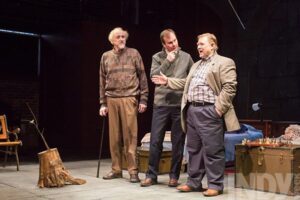
Have a fond or interesting memory of this play you’d like to share with us? We’d love to hear it!
Please Contact Us to Share!
Burning Coal Theatre
(919) 834-4001
224 Polk St., Raleigh NC 27604
Played January 30-February 16 2014: The Jesus Fund
The Diary of Anne Frank
The Diary of Anne Frank by Goodrich and Hackett
Dir. Abdelfattah Abusrour
Dates: April 3-27 2014
Location: Murphey School
Artistic Director’s Notes:
I remember reading The Diary of Anne Frank for the first time in my twenties, after I’d moved to New York City. I was trying to convince myself that some of the many books I’d rigorously avoided as a youth were now going to reveal themselves to me. I was no longer under the thumb of those nasty teachers who wanted to enforce their worldview on me, so I could read or not read as I saw fit. A little Faulkner, a bit of Chaucer, maybe Jane Austen on a Sunday afternoon. Then one day, without really thinking too much about it, I picked up a copy of Anne Frank: The Diary of a Young Girl.
I read the slight book over a twenty-four hour period which was fast for me. Most of it in one night, then, finishing it as I rode into my Manhattan job on the Long Island Railroad. I can clearly recall being drawn into the family’s story as their liberation seemed imminent. I could almost smell the fresh air that Anne longed for. Then…I turned the page…and there was nothing on it. No neat ending. No climax, followed by denouement…just a blank page.
I remembered then what I already knew. That Anne and most of her family did not live “happily ever after.” That blank page continues to stand out in my mind and in the world of literature as the single most impactful page ever published.
A blank page can have two meanings. It can mean, as I felt there on the LIRR as a young man, the chill of death, of loneliness and tragedy, of nothing after. It can mean the end of a life snuffed out far too soon. But in my later years, I have come to see that blank page differently. It is also an opportunity. It is a symbol of what the world might become, if we listen to the story of the Franks, the van Daans, of Miep and Kraler and all the rest, If we allow the storytellers to remind us, again and again, of our common humanity.
I’ve steered away from this play for years, because I feared it was too well known. Then I met Abed, the director, and I realized immediately that here was a possible way into the story. He did not know the play, did not know the film, and was only loosely familiar with the diary. I realized he would be able to build the play from the same viewpoint as the one Anne had developed to construct the fanciful world which she lived in during her years of confinement in the annex. Through creative and empathetic imagination, not through a reliance on anyone else to point the way, to signify what is important and what is trite. The work of an artist must both encompass the world and its doings … and burrow within, where the simplest truths are born and still, perhaps, exist. After all, when you begin to create a work of art or a better world you have to start with a blank page.
Crew:
Stage Manager: Steph Scribner
Technical Director: Barry Jaked
Asst. Technical Director: Jeff Stevenson
Scenery Design: Elizabeth Newton
Lighting Design: Matthew Adelson
Costume Design: Karen Morgan Williams
Props: Sarah Morrissey
Sound Design: Aharon Segal
Asst. Director: Ilana Rozin
Dramaturg: Fred Corlett
Study Guides: Eric Kildow
Graphics Design: Simmie Kastner
House Manager: Carry Vaughn
Asst. Stage Manager: Mia Carson and Taylor Shumatae
Asst. Stage Manager/Board Operator: Tanisha Woods
Scene Painter: Danielle Hall
Asst. Technical Director: Michael Gorman
Asst. Lighting Designer: Cee Cee Huffman
Cast:
John Allore – Otto Frank
Thom Haynes – Mr. van Daan
George Kaiser – First Man
Josh Martin – Peter van Daan
Trey Morehouse – Third Man
Greg Paul – Second Man
Samantha Rahn – Anne Frank
Lucius Robinson – Mr. Kraler
Mikaela Saccoccio – Mies Giep
Al Singer – Mr. Dussel
Jenn Suchanec – Mrs. van Daan
Erin Tito – Edith Frank
Anna Grey Voelker – Margot Frank
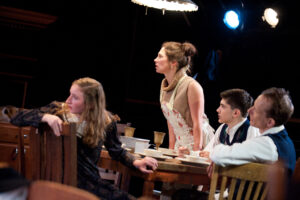
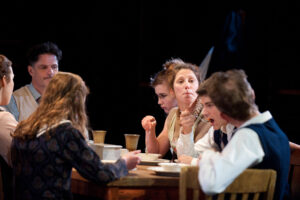
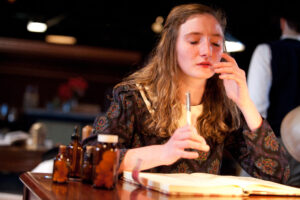

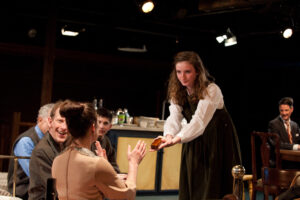
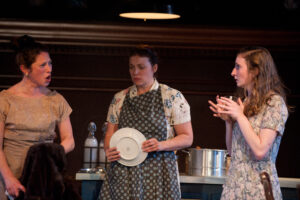
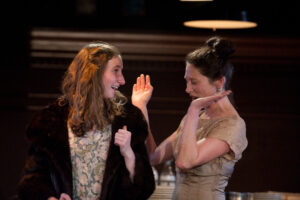


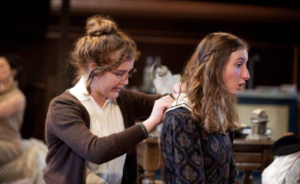

Have a fond or interesting memory of this play you’d like to share with us? We’d love to hear it!
Please Contact Us to Share!
Burning Coal Theatre
(919) 834-4001
224 Polk St., Raleigh NC 27604
Played April 3-27, 2014: The Diary of Anne Frank
Season 18: (2014-2015)
The Iron Curtain Trilogy
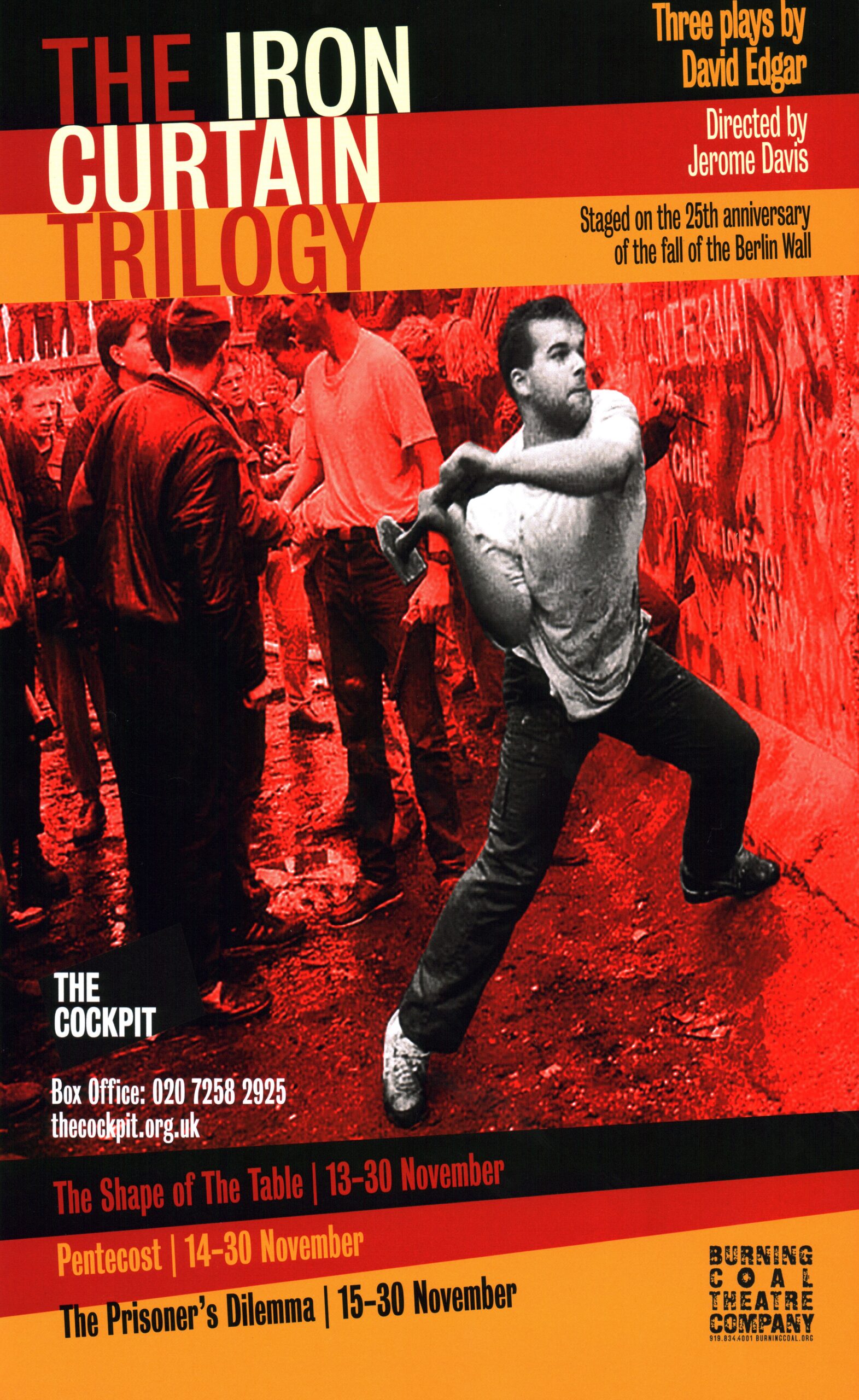
The Iron Curtain Trilogy by David Edgar
Dir. Jerome Davis
Dates: September 4 - 27, 2014 (Raleigh), November 14-20, 2014 (London)
Location: Warehouse District, Raleigh / The Cockpit, London
Romeo & JUliet
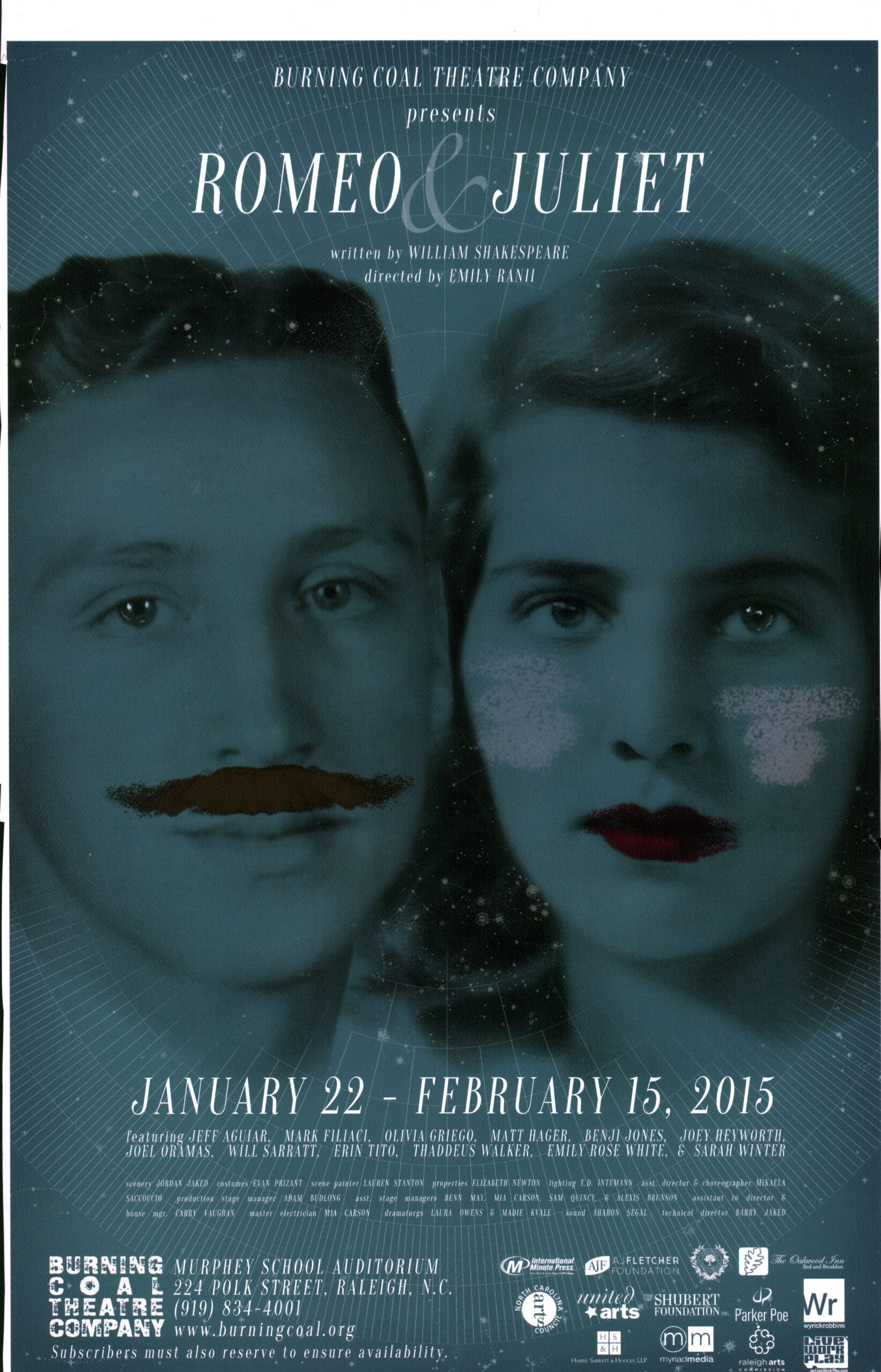
Romeo & Juliet by William Shakespeare
Dir. Emily Ranii
Dates: January 22-February 15 2015
Location: Murphey School
Sunday in the Park with George

Sunday in the Park with George by Stephen Sondheim and James Lapine
Dir. Jerome Davis
Dates: April 9-May 3 2015
Location: Murphey School
The Iron Curtain Trilogy
The Iron Curtain Trilogy by David Edgar
Dir. Jerome Davis
Dates: September 4 – 27, 2014 (Raleigh), November 14-20 (London)
Location: Warehouse District, Raleigh / The Cockpit, London
Artistic Director’s Notes:
Burning Coal has been producing for 18 years. We closed our first season with David Edgar’s play Pentecost. We presented it in Raleigh in June of 1998 in an un-air conditioned high school gymnasium. The audiences were asked to climb atop some fairly doubtful scaffolding and from that perch to watch a 2.5 hour play about ethnic cleansing in Eastern Europe performed by a company most of them had never heard of or seen. The play began to pop during rehearsals. A turning point came one night near the end of the rehearsal process when a photographer from the local ‘paper of record’ came to shoot some rehearsal stills for a story that it was planning to run a week late. He apologized immediately, saying that he could only stay for an hour as he had to go shoot his six year old daughter’s swimming competition. He quietly went about the business of snapping shots for that hour and then left as he’d said he would. About 10pm that night, though, he came back. I watched him for a bit, then walked over and asked him why he’d returned. He whispered to me as the rehearsal moved on, “I couldn’t believe what I was seeing. I had to come back!” That was pretty good for Burning Coal, and a night when I began to believe that our little company might actually find traction in this (then) sleepy southern town with a long history of literary accomplishments, pottery and what I like to call the ‘tactile arts’ – but a fairly minimal and certainly unknown record where the performing arts and theatre were concerned.
Since then, we’ve tried to walk the line between entertaining our audiences and providing material for the community that is informative, educational, useful. That’s a tough trick, sometimes – watching the masses flock to yet another overhyped sporting event or a vapid touring production of the latest stage adaptation of a not altogether memorable or meaningful film while you struggle to fill seats. We had in fact, an intrepid 13 in attendance at our very first production, a few months before Pentecost. And certainly there was no reason for me to think this challenging work would do any better. But it did. The word of mouth, every producer’s favorite ally, led to huge audiences, people being turned away at the doo, and almost no one leaving before the production’s 2.5 hours had run their course (in fact, only one elderly couple did over a three week run, citing the uncomfortable chairs – they were right!). I wish I could report that every production in the 18 years since then has had similar results, but it has happened often enough that we have confidence in our community. We believe in them and we have faith that if we lead them down an interesting path, they will follow.
Time and again, those interesting paths have started in the fertile imaginations of playwrights either from or inspired by the English and Irish theatre tradition. This little corner of the earth seems to create men and women who know how to tell a story. Maybe that is tradition, maybe its climate, maybe it’s what you eat for breakfast – I don’t know. But I do know that we are grateful for this centuries old facility. E hope that our work on these three plays by one of your favorite sons will honor that tradition. The fall of the Iron Curtain is, I believe, the greatest story of our lives (those of us born in the second half of the 20th century), and one that continues and will continue to unfold in interesting and all too often disturbing ways. The 25th anniversary of that event’s beginning makes staging them this fall an easy choice. The three plays are, collectively, the greatest work of art yet created on this subject. We are delighted to be making our London debut with these three powerful and thrilling plays.
Lastly, a heartfelt thank you to Dave Wybrow and his remarkable team here at the Cockpit. His willingness to take a chance of this magnitude on an unknown company is a compliment to his passion. His extraordinary generosity, his knowledge of the art form for which he toils and his boldness. Those are the qualities of a great leader, an we are happily in his debt.
Jerome Davis/Artistic Director
Playwright’s Notes:
From Babel to Pentecost (and back again)
David Edgar
In early 1990 I visited what was still just about Yugoslavia on a British Council lecture tour, subsequently journeying to Romania in order to research a film about their December 1989 revolution. Out of this came not a film but three stage plays. They weren’t intended as a trilogy – writing the first raised questions that I tried to answer in the second, which in turn raised questions I wanted to address in the third. They weren’t premiered by the same institution: the first was done by the National Theatre, the second and third by the Royal Shakespeare Company. Although they’re all set in unnamed countries, they’re not the same country, and they don’t share any characters. They’ve not been done together until now.
The first play – The Shape of the Table – was directly inspired by the events of late 1989 and was premiered one day before the first anniversary of the fall of the Berlin wall. For someone of my generation and history, these events were both inspiring and poignant. Those brave East Europeans thronging the streets, squares and churches of Eastern Europe had returned revolution to the historical agenda, and with a vengeance. But they had done so in order to overthrow regimes that claimed to be the torchbearers of the revolutionary ideal. Although I had never had much time for the Soviet Union, I was formed by the student revolt of the late 60s, which was both an inspiration for the 1989 insurgents and the most recent version of the ideology it sought to overthrow. So when the wall fell, it seemed indecent not to try and write about it. And because, in Eastern Europe, basically, the same thing happened five times, in Poland, Hungary, Bulgaria, East Germany and Czechoslovakia (Romania was different), I decided I could and should create a fictional, paradigmatic East European revolution constructed from the body-parts of all the real ones.
The Shape of the Table was most closely based on the Czech revolution, and begins with a dissident brought from prison during a political crisis to discuss the terms of his release. The play is set in a 19th century Austro Hungarian Imperial palace taken over by the Communists as a government building in 1945, in what had been a ballroom and was now called the Great Hall of the 23rd of May. In it, I was able to assemble the two groups I was most interested in. Of course the play deals with the heroes of the revolution, tumbling in off the streets. But it also deals with the losers. Many, if not most of the great political dramas are about the vanquished – from Aeschylus’ The Persians and Shakespeare’s Richard II. I felt it proper and right, in a play about the end of the Marxist-Leninist dream, to acknowledge that, despite its failure in practice, it had been a great dream and that its collapse impoverished humanity.
However, as I wrote and rehearsed the play, there was no doubt that the dream was over, not least because of the confidence and energy of the forces that had defeated it. This was after all a most extraordinary time, that spring and summer of 1990, when it seemed the entire youth of Europe was marching, Beethoven’s Ode to Joy on their lips, old Soviet army caps at jaunty angles on their heads, through the great yawning gaps in the Berlin wall. To the west, it seemed, the national barriers had already fallen, and there were only a few more pockets of resistance to clean up before the European Union ideal of a frontier-less, supranational Europe was fully and finally realised. To the east, surely, it was only a matter of time before the emergent liberal democracies of the former Soviet empire followed the western powers down the Pan-European path, exchanging their sadly failed version of post- enlightenment utopia for an obviously successful one.
But two years on, things looked very different. Far from the east importing western universalism, the traffic appeared to be the other way, with Bavaria, Catalonia, Lombardy and Scotland eagerly emulating the emergent separatism of Slovenia, Slovakia and the Baltic states. And instead of being a temporary festivity, the ornaments of new nationhood were hardening into real statehoods with real controls over the movement of people and capital, often defined by the atavisms of ancient religious and ethnic disputes (virtually the first act of any new east European state appeared to be the delegitimization of their own minorities, be they ethnic Hungarians in Slovakia, ethnic Russians in Latvia or Muslims in the former Yugoslavia).
The concept of Europeanness itself had changed from one of inclusion to one of exclusivity, less about who you were than what they weren’t. Even in 1990, I was aware that for many of its citizens, Europe was a continent that stopped 20 kilometres to the east of wherever one happened to be. By Christmas 1990, when I visited Prague, it was clear that liberal middle class Czechs had drawn thick black borders between themselves and the Slovaks, were seriously debating what to do about the gypsies, and weren’t frankly that sure about the Moravians.
Whether post-cold war Europe was to prove an assertion or a denial of universal enlightenment values – whether the lesson of Pentecost would defeat the stern lesson of the Tower of Babel was, thus, the question posed by my second Eastern European play. The third play was inspired by a television documentary on the Oslo peace process, and started outoptimistically. Its source material was about the initially successful attempts to settle two kinds of conflict: those long-standing contentions in South Africa, Northern Ireland and the Middle East which had appeared intractable but which after 1989 seemed open to resolution, and new disputes which emerged in the wake of the cold war, notably in the former Yugoslavia.
It was in this spirit that I started work on The Prisoner’s Dilemma. In the manner of The Shape of the Table, I wanted to draw on these different real world events and create a fictional paradigm (an insurgency by majority Muslim province against a majority Christian, post-Soviet republic). But when I’d reached the second act, what had seemed a success story was falling apart. Following the unqualified success of negotiations in South Africa and what appeared to be breakthroughs in the Middle East and Northern Ireland; peace settlements were beginning to unravel. The Northern Ireland process appeared to grind to a halt. The techniques which had ended the Bosnian war at Dayton failed to resolve the Kosovo conflict at Rambouillet.
Despite or maybe even because of the success of Oslo, the Middle East settlement crumbled and the intifada exploded once again. As a consequence, the confidence of governments in conflict resolution wavered and suddenly it was the peacemakers themselves whose strategies, techniques and motivation were called into question, with both European and American peacemakers facing charges that far from being honest brokers they had their own agendas, which were not always in the interests of the people they were claiming to help. Finally, surely, the era of hope for a new kind of peace-making, which began with the fall of the Berlin Wall on the date Europeans write as 9.11.89, was brought to an end by the events of the American 9.11.01.
So are the plays I wrote towards the end of the last century – and the questions they posed – now no more than an interesting historical curiosity? In The Shape of the Table, the dominant political reality for the leaders of my fictional East European state democracy is what is referred to euphemistically as “our great neighbor to the East”, a country now led by Vladimir Putin. In Pentecost, a country divided between supposedly a civilized, European-oriented west and alleged reactionary primitives in the east is invaded by asylum seekers, including an Afghan fleeing his collapsing country and a Kurd fighting for a separate state. The first half of The Prisoners’ Dilemma is about two peoples of different ethnicities and religions, trying to work out whether they can live together in the same country, or whether the ultimate solution is for the Christians to flee from the Muslim areas and for a new state to be created by forced partition of the old one.
The first image of the Iron Curtain trilogy is of an artist in a country whose totalitarian regime is about to be overthrown by a mass popular uprising. The last is of another artist who is threatened with expulsion from a separatist statelet that has been taken over by religious fundamentalists. Much of our contemporary world – in both its positive and its negative aspects – was born 25 years ago.
Crew:
Stage Manager: Steph Scribner
Technical Director: Barry Jaked
Asst. Technical Director: Jeff Stevenson
Scenery Design: Elizabeth Newton
Lighting Design: Matthew Adelson
Costume Design: Karen Morgan Williams
Props: Sarah Morrissey
Sound Design: Aharon Segal
Asst. Director: Ilana Rozin
Dramaturg: Fred Corlett
Study Guides: Eric Kildow
Graphics Design: Simmie Kastner
House Manager: Carry Vaughn
Asst. Stage Manager: Mia Carson and Taylor Shumatae
Asst. Stage Manager/Board Operator: Tanisha Woods
Scene Painter: Danielle Hall
Asst. Technical Director: Michael Gorman
Asst. Lighting Designer: Cee Cee Huffman
Cast:
Shape of the Table:
Brain Linden – Pavel Prus
Thaddeus Walker -Petr Vladislav
Tim X. Davis – Joseph Lutz
Marc Carver – Michael Kaplan
Jeff Aguiar – Jan Milev
Jon Fitts – Andrew Zietek
Brook North – Jan Matkovic
Randolph Curtis Rand – Victor Spassov
Rajeev Rajendran – Bishop
Greg Paul – Minister of Defense
Matthew Lupin – Social Democrat
Hope Hynes Love – Monica Freie
Joey Heyworth – Youth LEader
Julie Oliver – Vera Rousova
Maggie Lea – Victoria Brodskaya
Pentecost
Brian Linden – Leo Katz
Tim X. Davis – Czaba/Nico
Marc Carver – Oliver Davenport
Jeff Aguiar – Grigori/1st Soldier
Jon Fitts – Pusbas/Abdul/Swedish Man
Rajeev Rajendran – 2nd Soldier/Command
Greg Paul – Bojovic
Matthew Hagar – Karolyi
Hope Hynes Love – Garbeilla Pecs
Joey Hayworth – Restorer/Commando
Julie Oliver – Anna Jedlikova/Amira
Maggie Lea – Marina
Max Hanau – Raif/Restorer
Gil Faison – ANtonio
Rebecca Bossen – Czaba’s Secretary/Fatima
Jeanine Frost -Yasmin
Steph Scribner – Tunu
Madeline Kvale – Cleopatra/Restorer
Mikaela Saccoccio – Toni Newsome/Teen Girl
Matthew Lubin – Restorer/Policeman
Prisoner’s Dilemma
Thaddeus Walker – Roman/2nd Kavkaz Soldier
Jeff Aguiar – Nikolai/Lou Wasserman
Jon Fitts – Al Bek
Brook North – Erik
Brian Linden – Petrovian
Rajeev Rajendran – Hasim/1st Kavkaz Soldier
Greg Paul – 1st Drozhdan Soldier/Trevelyan/Zelim
Joey Jeyworth – Young Man/Paramilitary/2nd Drozhdan
Julie Oliver – Floss Weatherby
Matthew Lubin – Kavkaz Soldier/Soldier/Paramilitary/Father
Marc Carver – Tom Rothman
Max Hanau – James Neil/2nd Paramilitary
Joel Oramas – Patterson Davis/Len
Rebecca Bossen – Kelima
Jeanine Frost – Gina/Mother
Mikaela Saccoccio – Emela/1st
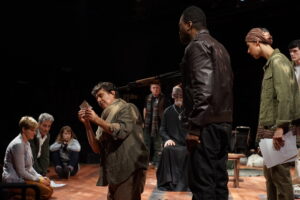

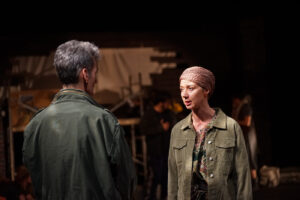
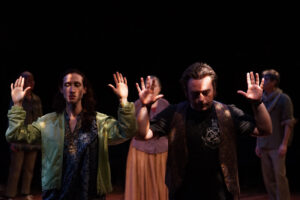

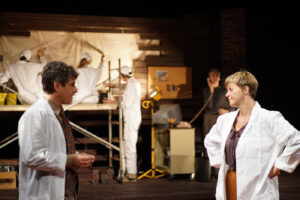

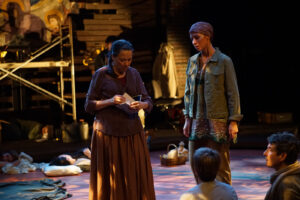
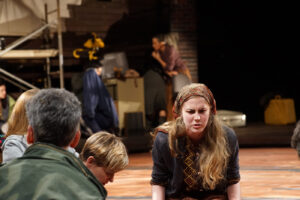


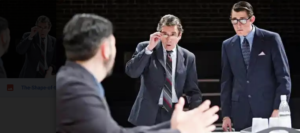
Have a fond or interesting memory of this play you’d like to share with us? We’d love to hear it!
Please Contact Us to Share!
Burning Coal Theatre
(919) 834-4001
224 Polk St., Raleigh NC 27604
Played September 4 - 27, 2014: The Iron Curtain Trilogy
Romeo & Juliet
Romeo & Juliet by William Shakespeare
Dir. Emily Ranii
Dates: January 22-February 15 2015
Location: Murphey School
Crew:
Scenery Design: Jordan Jaked
Costume Design: Evan Prizant
Asst. Director and Choreographer: Mikaela Saccoccio
Props: Elizabeth Newton
Scene Painter: Lauren Stanton
Lighting: ED Intemann
Stage Manager: Adam Budlong
Asst. Stage Manager: Benn May, Alexis Brunson, Sam Quincy, Mia Carson
Asst. Director and House Manager: Carry Vaughan
Master Electrician: Mia Carson
Dramaturg: Laura Owens and Madie Kvale
Sound Design: Aharon Segal
Technical Director: Barry Jaked
Cast:
Jeff Aguiar – Montague, Abraham, Friar
Gil Faison – The Prince
Mark Filiaci – Capulet, Sampson, Friar John
Olivia Griego – Lady Montague, Balthasar
Matt Hager – Benvolio
Joey Heyworth – Romeo
Benji Jones – Lady Capulet, Gregory, Apothecary
Joel Oramas – Mercutio
Will Sarratt -Tybalt
Erin Tito – Nurse
Thaddeus Walker – Paris
Emily Rose White – Juliet
Sarah Winter – Peter

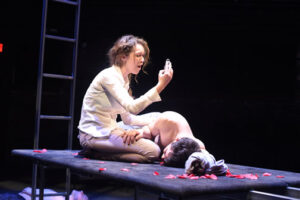

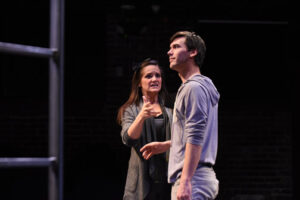
Have a fond or interesting memory of this play you’d like to share with us? We’d love to hear it!
Please Contact Us to Share!
Burning Coal Theatre
(919) 834-4001
224 Polk St., Raleigh NC 27604
Played January 22-February 15 2015: Romeo & Juliet
Sunday in the Park with Geroge
Sunday in the Park with George by Stephen Sondheim and James Lapine
Dir. Jerome Davis
Dates: April 9-May 3, 2015
Location: Murphey School
Crew:
Music Director/Pianist: Christian Stahr
Stage Manager: Robert V. Thurber
Scenery & Lighting Design: ED Intemann
Costume Design: Bonnie Raddatz
Props: Elizabeth Newton
Asst. Director: Stephen Eckert and Jackie Knolhuff
Choreographer: Mikaela Saccocio
Dramaturg: Madie KVale and Laura Owens
Study Guides: Katy Werlin
Technical Director: Barry Jaked, Jeff Sammarco, Adam York
Asst. Technical Director: Michael Gorman
Asst. Stage Manager: Garrett Canna. Christine Martin, Laura Owens
Graphics Design: Simmie Kastner
House Manager: Carry Vaughn
Master Electrician: Mia Carson
Scene Painter: Lauren Stanton
Costume Assts.: Liesa Johnson, Jackie Knollhuf, Maegan Mercer-Bourne, Loren Armitage, Nancy Law, Linda Pukalo
Musicians: Pill Pashby (cello), Jack Pashby (violin)
Cast:
Fred Corlett – Louis/Billy Webster
Alec Donaldson – Jules/Bob Greenberg
Lenore Field – George’s Mother/Blair Daniels
Abbe Fralix – Frieda/Betty
Tyler Graeper – Georges/George
Eric Hale – Mr. American/Lee Randolph
Laura Jenkins – Nurse/Harriest Pawling
Bailey Jenkins – Louise
Diana Cameron McQueen – Yvonne/Naomin.Eisen
James Merkle – Franz/Dennis
Mary Floyd Page – Mrs.American/Waitress
Natalie Reder – Dot.Marie
Alex Reynolds – Boatman/Charles Redmond
Alice Rothman-Hicks – Celeste #2/Elaine
Sarah Winter – Celeste #1/Photographer
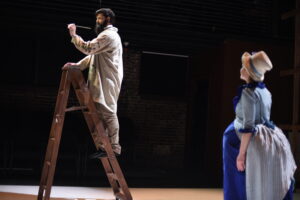
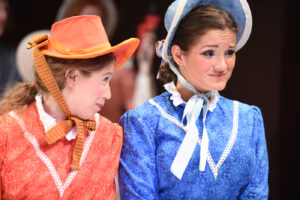

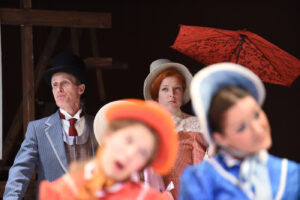
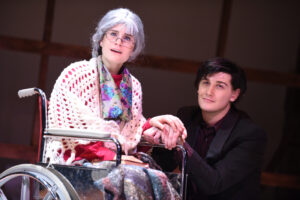
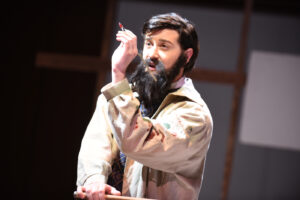
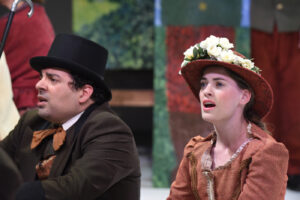
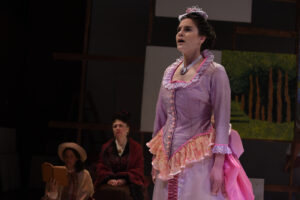

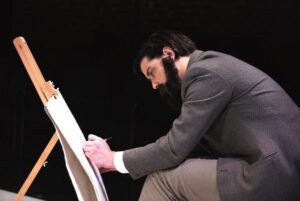
Have a fond or interesting memory of this play you’d like to share with us? We’d love to hear it!
Please Contact Us to Share!
Burning Coal Theatre
(919) 834-4001
224 Polk St., Raleigh NC 27604
Played April 9-May 3 2015: Sunday in the Park with George

Thank you. Your being here and your support makes it possible to bring live, inclusive, innovative theatre to Downtown Raleigh, NC, and beyond.
Burning Coal Theatre Company is funded in part by the City of Raleigh based on recommendations of the Raleigh Arts Commission. Burning Coal Theatre Company is supported by the United Arts Council of Raleigh and Wake County.
Burning Coal Theatre | (919) 834-4001 | info@burningcoal.org | 224 Polk St., Raleigh NC 27604
Copyright © 2021 Burning Coal Theatre Company | All Rights Reserved | Home
